Nikon 4151EB Digital Camera User Manual COOLPIX L840 UserMan
Nikon Corporation Digital Camera COOLPIX L840 UserMan
Nikon >
User manual
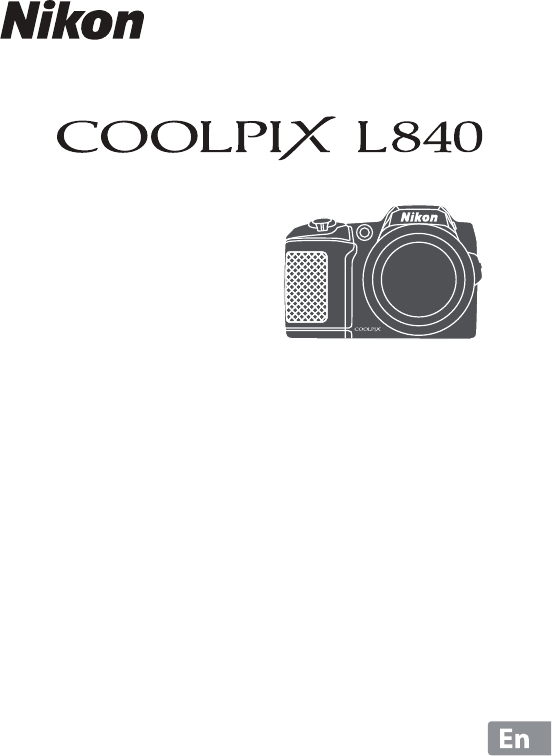
DIGITAL CAMERA
Reference Manual

Introduction i
Table of Contents xiii
Parts of the Camera 1
Preparing for Shooting 6
Basic Shooting and Playback Operations 12
Shooting Features 23
Playback Features 57
Recording and Playing Back Movies 68
Using Menus 75
Using the Wi-Fi (Wireless LAN) Function 118
Connecting the Camera to a TV, Printer, or Computer 122
Technical Notes 132
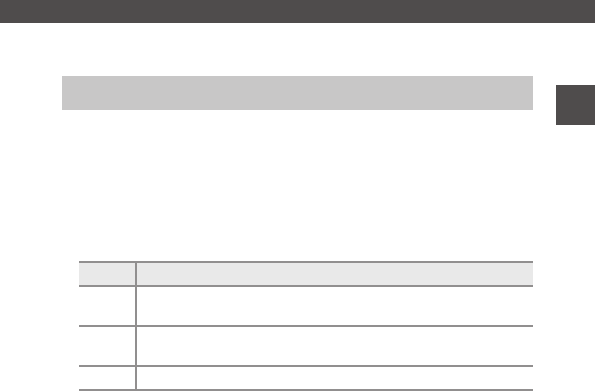
i
Introduction
Introduction
To get the most from this Nikon product, be sure to read “For Your Safety”
(Av-vii) and “Wi-Fi (Wireless LAN Network)” (Ax), and all other instructions
thoroughly and keep them where they will be read by all who use the camera.
•If you want to start using the camera right away, see “Preparing for
Shooting” (A6) and “Basic Shooting and Playback Operations” (A12).
Other Information
•Symbols and Conventions
•SD, SDHC, and SDXC memory cards are referred to as “memory cards” in this
manual.
•The setting at the time of purchase is referred to as the “default setting.”
•The names of menu items displayed in the camera monitor, and the names
of buttons or messages displayed on a computer monitor appear in bold.
•In this manual, images are sometimes omitted from monitor display samples
so that monitor indicators can be more clearly shown.
Read This First
Symbol Description
BThis icon marks cautions and information that should be read before
using the camera.
CThis icon marks notes and information that should be read before
using the camera.
AThis icon marks other pages containing relevant information.

ii
Introduction
Information and Precautions
Life-Long Learning
As part of Nikon’s “Life-Long Learning” commitment to ongoing product support
and education, continually updated information is available online at the following
websites:
•For users in the U.S.A.: http://www.nikonusa.com/
•For users in Europe and Africa: http://www.europe-nikon.com/support/
•For users in Asia, Oceania, and the Middle East: http://www.nikon-asia.com/
Visit these websites to keep up-to-date with the latest product information, tips,
answers to frequently asked questions (FAQs), and general advice on digital imaging
and photography. Additional information may be available from the Nikon
representative in your area. Visit the website below for contact information.
http://imaging.nikon.com/
Use Only Nikon Brand Electronic Accessories
Nikon COOLPIX cameras are designed to the highest standards and include complex
electronic circuitry. Only Nikon brand electronic accessories (including battery
chargers, batteries, and AC adapters) certified by Nikon specifically for use with this
Nikon digital camera are engineered and proven to operate within the operational
and safety requirements of this electronic circuitry.
THE USE OF NON-NIKON ELECTRONIC ACCESSORIES COULD DAMAGE THE CAMERA
AND MAY VOID YOUR NIKON WARRANTY.
For more information about Nikon brand accessories, contact a local authorized
Nikon dealer.
Before Taking Important Pictures
Before taking pictures on important occasions (such as at weddings or before taking
the camera on a trip), take a test shot to ensure that the camera is functioning
normally. Nikon will not be held liable for damages or lost profits that may result from
product malfunction.

iii
Introduction
About the Manuals
•No part of the manuals included with this product may be reproduced,
transmitted, transcribed, stored in a retrieval system, or translated into any
language in any form, by any means, without Nikon’s prior written permission.
•Illustrations and monitor content shown in this manual may differ from the actual
product.
•Nikon reserves the right to change the specifications of the hardware and software
described in these manuals at any time and without prior notice.
•Nikon will not be held liable for any damages resulting from the use of this
product.
•While every effort was made to ensure that the information in these manuals is
accurate and complete, we would appreciate it were you to bring any errors or
omissions to the attention of the Nikon representative in your area (address
provided separately).
Notice Concerning Prohibition of Copying or Reproduction
Note that simply being in possession of material that was digitally copied or
reproduced by means of a scanner, digital camera or other device may be
punishable by law.
•Items prohibited by law from being copied or reproduced
Do not copy or reproduce paper money, coins, securities, government bonds or local
government bonds, even if such copies or reproductions are stamped “Sample.” The
copying or reproduction of paper money, coins, or securities which are circulated in a
foreign country is prohibited. Unless the prior permission of the government was
obtained, the copying or reproduction of unused postage stamps or post cards
issued by the government is prohibited.
The copying or reproduction of stamps issued by the government and of certified
documents stipulated by law is prohibited.
•Cautions on certain copies and reproductions
The government has issued cautions on copies or reproductions of securities issued
by private companies (shares, bills, checks, gift certificates, etc.), commuter passes, or
coupon tickets, except when a minimum of necessary copies are to be provided for
business use by a company. Also, do not copy or reproduce passports issued by the
government, licenses issued by public agencies and private groups, ID cards and
tickets, such as passes and meal coupons.
•Comply with copyright notices
The copying or reproduction of copyrighted creative works such as books, music,
paintings, woodcut prints, maps, drawings, movies, and photographs is governed by
national and international copyright laws. Do not use this product for the purpose of
making illegal copies or to infringe copyright laws.

iv
Introduction
Disposing of Data Storage Devices
Please note that deleting images or formatting data storage devices such as memory
cards or built-in camera memory does not completely erase the original image data.
Deleted files can sometimes be recovered from discarded storage devices using
commercially available software, potentially resulting in the malicious use of personal
image data. Ensuring the privacy of such data is the user’s responsibility.
Before discarding a data storage device or transferring ownership to another person,
erase all data using commercial deletion software, or format the device and then
completely refill it with images containing no private information (for example,
images of empty sky). Care should be taken to avoid injury or damage to property
when physically destroying data storage devices.
To delete the Wi-Fi settings, select Restore default settings in the Wi-Fi options
menu (A75).
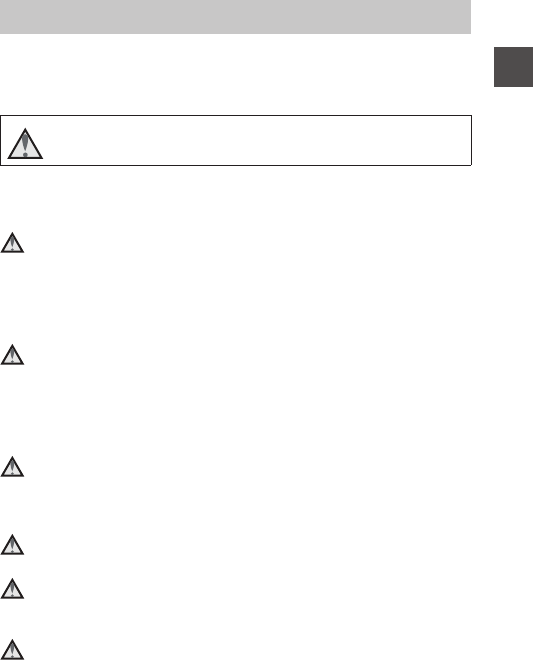
v
Introduction
To prevent damage to your Nikon product or injury to yourself or to others,
read the following safety precautions in their entirety before using this
equipment. Keep these safety instructions where all those who use the product
will read them.
WARNINGS
Turn off in the event of malfunction
Should you notice smoke or an unusual smell coming from the camera or AC
adapter, unplug the AC adapter and remove the batteries immediately, taking
care to avoid burns. Continued operation could result in injury. After removing
or disconnecting the power source, take the equipment to a Nikon-authorized
service representative for inspection.
Do not disassemble
Touching the internal parts of the camera or AC adapter could result in injury.
Repairs should be performed only by qualified technicians. Should the camera
or AC adapter break open as the result of a fall or other accident, take the
product to a Nikon-authorized service representative for inspection, after
unplugging the product and/or removing the batteries.
Do not use the camera or AC adapter in the presence of flammable
gas
Do not use electronic equipment in the presence of flammable gas, as this
could result in explosion or fire.
Handle the camera strap with care
Never place the strap around the neck of an infant or child.
Keep out of reach of children
Particular care should be taken to prevent infants from putting the batteries or
other small parts into their mouths.
Do not remain in contact with the camera, battery charger, or AC
adapter for extended periods while the devices are on or in use
Parts of the devices become hot. Leaving the devices in direct contact with the
skin for extended periods may result in low-temperature burns.
For Your Safety
This icon marks warnings, information that should be read before using
this Nikon product, to prevent possible injury.

vi
Introduction
Do not leave the product where it will be exposed to extremely
high temperatures, such as in an enclosed automobile or in direct
sunlight
Failure to observe this precaution could cause damage or fire.
Observe caution when handling batteries
Batteries may leak or explode if improperly handled. Observe the following
precautions when handling batteries for use in this product:
•Before replacing the batteries, turn the product off. If you are using an AC
adapter, be sure it is unplugged.
•Use only the batteries approved for use in this product (A7). Do not
combine old and new batteries or batteries of different makes or types.
•When charging Nikon EN-MH2 rechargeable Ni-MH batteries, use only the
specified charger and charge the batteries four at a time. When replacing
the batteries with EN-MH2-B2 batteries (available separately), purchase two
sets (total of four batteries).
•The EN-MH2 rechargeable batteries are for use with Nikon digital cameras
only, and are compatible with COOLPIX L840.
•Insert batteries in the correct orientation.
•Do not short or disassemble batteries or attempt to remove or break battery
insulation or casing.
•Do not expose batteries to flame or to excessive heat.
•Do not immerse in or expose to water.
•Do not transport or store with metal objects such as necklaces or hairpins.
•Batteries are prone to leakage when fully discharged. To avoid damage to
the product, be sure to remove the batteries when no charge remains.
•Discontinue use immediately should you notice any change in the batteries,
such as discoloration or deformation.
•If liquid from damaged batteries comes in contact with clothing or skin,
rinse immediately with plenty of water.
Observe the following precautions when handling the Battery
Chargers (available separately)
•Keep dry. Failure to observe this precaution could result in fire or electric
shock.
•Dust on or near the metal parts of the plug should be removed with a dry
cloth. Continued use could result in fire.
•Do not handle the power cable or go near the battery charger during
lightning storms. Failure to observe this precaution could result in electric
shock.
•Do not damage, modify, forcibly tug or bend the power cable, place it under
heavy objects, or expose it to heat or flames. Should the insulation be
damaged and the wires become exposed, take it to a Nikon-authorized
service representative for inspection. Failure to observe these precautions
could result in fire or electric shock.

vii
Introduction
•Do not handle the plug or battery charger with wet hands. Failure to
observe this precaution could result in electric shock.
•Do not use with travel converters or adapters designed to convert from one
voltage to another or with DC-to-AC inverters. Failure to observe this
precaution could damage the product or cause overheating or fire.
Use appropriate cables
When connecting cables to the input and output jacks, use only the cables
provided or sold by Nikon for the purpose, to maintain compliance with
product regulations.
Do not touch the moving parts of the lens
Failure to observe this precaution could result in injury.
Handle moving parts with care
Be careful that your fingers or other objects are not pinched by the lens cover
or other moving parts.
Using the flash close to your subject’s eyes could cause temporary
visual impairment
The flash should be no less than 1 meter (3 ft 4 in.) from the subject. Particular
care should be observed when photographing infants.
Do not operate the flash with the flash window touching a person
or object
Failure to observe this precaution could result in burns or fire.
Avoid contact with liquid crystal
Should the monitor break, care should be taken to avoid injury caused by
broken glass and to prevent liquid crystal from the monitor touching the skin
or entering the eyes or mouth.
Follow the instructions of airline and hospital personnel

viii
Introduction
Notices for Customers in the U.S.A.
Federal Communications Commission (FCC) Radio Frequency
Interference Statement
This equipment has been tested
and found to comply with the
limits for a Class B digital device,
pursuant to Part 15 of the FCC
rules. These limits are designed
to provide reasonable
protection against harmful interference in a residential installation. This
equipment generates, uses, and can radiate radio frequency energy and, if not
installed and used in accordance with the instructions, may cause harmful
interference to radio communications. However, there is no guarantee that
interference will not occur in a particular installation. If this equipment does
cause harmful interference to radio or television reception, which can be
determined by turning the equipment off and on, the user is encouraged to try
to correct the interference by one or more of the following measures:
•Reorient or relocate the receiving antenna.
•Increase the separation between the equipment and receiver.
•Connect the equipment into an outlet on a circuit different from that to
which the receiver is connected.
•Consult the dealer or an experienced radio/television technician for help.
CAUTIONS
Modifications
The FCC requires the user to be notified that any changes or modifications
made to this device that are not expressly approved by Nikon Corporation may
void the user’s authority to operate the equipment.
Interface Cables
Use the interface cables sold or provided by Nikon for your equipment. Using
other interface cables may exceed the limits of Class B Part 15 of the FCC rules.
Notices
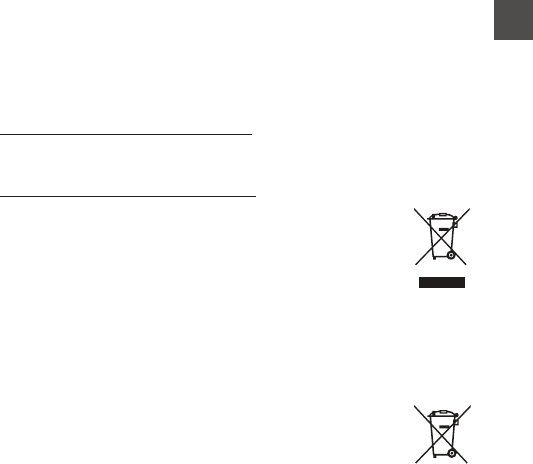
ix
Introduction
Notice for Customers in the State of California
WARNING
Handling the cord on this product will expose you to lead, a chemical known to
the State of California to cause birth defects or other reproductive harm.
Wash hands after handling.
Nikon Inc.,
1300 Walt Whitman Road, Melville, New York 11747-3064, U.S.A.
Tel: 631-547-4200
Notice for Customers in Canada
CAN ICES-3 B / NMB-3 B
Notices for Customers in Europe
This symbol indicates that electrical and electronic equipment is to
be collected separately.
The following apply only to users in European countries:
•This product is designated for separate collection at an
appropriate collection point. Do not dispose of as household
waste.
•Separate collection and recycling helps conserve natural resources and
prevent negative consequences for human health and the environment
that might result from incorrect disposal.
•For more information, contact the retailer or the local authorities in charge
of waste management.
This symbol on the batteries indicates that the batteries are to be
collected separately.
The following apply only to users in European countries:
•All batteries, whether marked with this symbol or not, are
designated for separate collection at an appropriate collection
point. Do not dispose of as household waste.
•For more information, contact the retailer or the local authorities in charge
of waste management.

x
Introduction
This product is controlled by the United States Export Administration
Regulations, and you are required to obtain permission from the United States
government if you export or re-export this product to any country to which the
United States embargoes goods. The following countries were subject to
embargo: Cuba, Iran, North Korea, Sudan, and Syria. Since the target countries
are subject to change, please contact the United States Department of
Commerce for the latest information.
Restrictions on Wireless Devices
The wireless transceiver included in this product conforms to wireless
regulations in the country of sale and is not for use in other countries (products
purchased in the EU or EFTA can be used anywhere within the EU and EFTA).
Nikon does not accept liability for use in other countries. Users who are unsure
as to the original country of sale should consult with their local Nikon service
center or Nikon-authorized service representative. This restriction applies to
wireless operation only and not to any other use of the product.
Notice for Customers in the U.S.A. and Canada
Federal Communications Commission (FCC) and Industry of Canada
(IC)
Declaration of Conformity
This device complies with Part 15 of FCC Rules and Industry Canada licence-
exempt RSS standard(s). Operation is subject to the following two conditions:
(1) this device may not cause interference, and (2) this device must accept any
interference, including interference that may cause undesired operation of this
device.
FCC/IC RF Exposure Statement
This transmitter must not be co-located or operated in conjunction with any
other antenna or transmitter.
The available scientific evidence does not show that any health problems are
associated with using low power wireless devices. There is no proof, however,
that these low power wireless devices are absolutely safe. Low power wireless
devices emit low levels of radio frequency energy (RF) in the microwave range
while being used. Whereas high levels of RF can produce health effects (by
heating tissue), exposure of low-level RF that does not produce heating effects
causes no known adverse health effects. Many studies of low-level RF
exposures have not found any biological effects. Some studies have suggested
that some biological effects might occur, but such findings have not been
confirmed by additional research.
Wi-Fi (Wireless LAN Network)
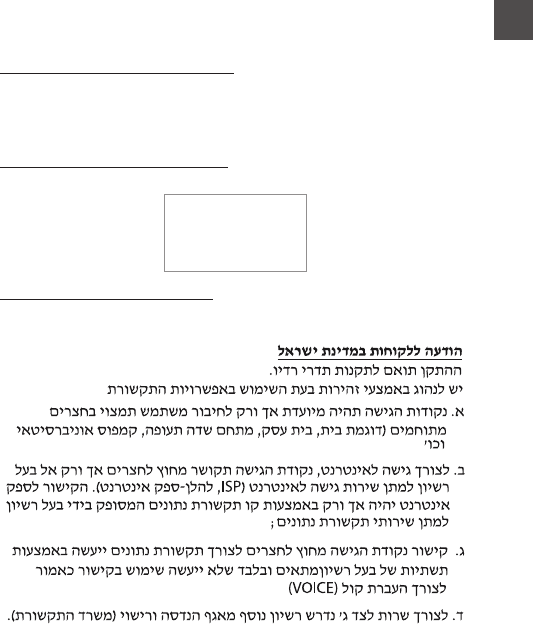
xi
Introduction
COOLPIX L840, which is equipped with a WSDB-686GN (FCC ID:2AAD3AA1G0J0
/ IC ID:4634A-2150EC) Wireless LAN Module, has been tested and found to
comply with FCC/IC radiation exposure limits set forth for an uncontrolled
environment and meets the FCC radio frequency (RF) Exposure Guidelines in
Supplement C to OET65 and RSS-102 of the IC radio frequency (RF) Exposure
rules. Please refer to the SAR test report that was uploaded to FCC website.
Declaration of Conformity (Europe)
Hereby, Nikon Corporation, declares that COOLPIX L840 is in compliance with
the essential requirements and other relevant provisions of Directive 1999/5/
EC. The declaration of conformity may be consulted at
http://imaging.nikon.com/support/pdf/DoC_L840.pdf.
Notice for Customers in Singapore
This device complies with radio-frequency regulations.
Notice for Customers in Jamaica
This product contains a Type Approved Module by Jamaica: “SMA – WSDB-
686GN”
Complies with
IDA Standards
DA103423

xii
Introduction
Precautions when Using Radio Transmissions
Always keep in mind that radio transmission or reception of data is subject to
interception by third parties. Note that Nikon is not responsible for data or
information leaks that may occur during data transfer.
Personal Information Management and Disclaimer
•User information registered and configured on the product, including
wireless LAN connection settings and other personal information, is
susceptible to alteration and loss resulting from operational error, static
electricity, accident, malfunction, repair or other handling. Always keep
separate copies of important information. Nikon is not responsible for any
direct or indirect damages or lost profits resulting from alteration or loss of
content that is not attributable to Nikon.
•Before discarding this product or transferring it to another owner, perform
Reset all in the setup menu (A75) to delete all user information registered
and configured with the product, including wireless LAN connection
settings and other personal information.

xiii
Table of Contents
Table of Contents
Introduction ................................................................................................................. i
Read This First .............................................................................................................................. i
Other Information......................................................................................................................................... i
Information and Precautions ................................................................................................................ ii
For Your Safety .......................................................................................................................... v
WARNINGS ....................................................................................................................................................... v
Notices....................................................................................................................................... viii
Wi-Fi (Wireless LAN Network)............................................................................................... x
Parts of the Camera .................................................................................................. 1
The Camera Body...................................................................................................................... 1
The Monitor ................................................................................................................................ 3
Shooting Mode ............................................................................................................................................. 3
Playback Mode .............................................................................................................................................. 5
Preparing for Shooting............................................................................................ 6
Attaching the Camera Strap and Lens Cap ..................................................................... 6
Insert the Batteries and Memory Card .............................................................................. 7
Applicable Batteries.................................................................................................................................... 7
Removing the Batteries or Memory Card ..................................................................................... 8
Memory Cards and Internal Memory............................................................................................... 8
Turn the Camera On and Set the Display Language, Date, and Time ................... 9
Raising and Lowering the Flash ....................................................................................................... 11
Basic Shooting and Playback Operations....................................................... 12
Shooting with Scene Auto Selector Mode..................................................................... 12
Using the Zoom......................................................................................................................................... 14
The Shutter-release Button................................................................................................................. 16
Play Back Images..................................................................................................................... 17
Delete Images .......................................................................................................................... 18
Changing the Shooting Mode ........................................................................................... 20
Using the Flash, Self-timer, Etc........................................................................................... 21
Recording Movies ................................................................................................................... 22
Changing the Angle of the Monitor................................................................................. 22

xiv
Table of Contents
Shooting Features................................................................................................... 23
o (Scene Auto Selector) Mode....................................................................................... 23
Scene Mode (Shooting Suited to Scenes)...................................................................... 24
Tips and Notes ............................................................................................................................................ 25
Shooting with Easy Panorama.......................................................................................................... 30
Playback with Easy Panorama........................................................................................................... 32
Special Effects Mode (Applying Effects When Shooting)......................................... 33
Smart Portrait Mode (Enhancing Human Faces When Shooting)......................... 35
Using Smile Timer..................................................................................................................................... 36
Using Self-Collage..................................................................................................................................... 37
Short Movie Show Mode (Combining Movie Clips to Create Short Movies) .... 38
A (Auto) Mode ...................................................................................................................... 41
Using the Creative Slider ...................................................................................................................... 41
Flash Mode................................................................................................................................ 43
Self-timer ................................................................................................................................... 45
Macro Mode (Taking Close-up Pictures)......................................................................... 46
Exposure Compensation (Adjusting Brightness) ........................................................ 47
Default Settings (Flash, Self-timer, Etc.).......................................................................... 48
Focusing..................................................................................................................................... 50
Using Face Detection ............................................................................................................................. 50
Using Skin Softening............................................................................................................................... 51
Using Target Finding AF ....................................................................................................................... 52
Subjects Not Suitable for Autofocus............................................................................................. 53
Focus Lock..................................................................................................................................................... 54
Functions That Cannot Be Used Simultaneously When Shooting........................ 55

xv
Table of Contents
Playback Features.................................................................................................... 57
Playback Zoom ........................................................................................................................ 57
Thumbnail Playback/Calendar Display ........................................................................... 58
List by Date Mode................................................................................................................... 59
Viewing and Deleting Images Captured Continuously (Sequence)..................... 60
Viewing Images in a Sequence ........................................................................................................ 60
Deleting Images in a Sequence ....................................................................................................... 61
Editing Images (Still Images) .............................................................................................. 62
Before Editing Images ............................................................................................................................ 62
Quick Effects: Changing Hue or Mood ....................................................................................... 62
Quick Retouch: Enhancing Contrast and Saturation .......................................................... 63
D-Lighting: Enhancing Brightness and Contrast................................................................... 64
Red-eye Correction: Correcting Red-eye When Shooting with the Flash ............ 64
Glamour Retouch: Enhancing Human Faces........................................................................... 65
Small Picture: Reducing the Size of an Image ........................................................................ 66
Crop: Creating a Cropped Copy ...................................................................................................... 67
Recording and Playing Back Movies................................................................. 68
Capturing Still Images While Recording Movies ......................................................... 71
Operations During Movie Playback ................................................................................. 72
Editing Movies ......................................................................................................................... 73
Extracting Only the Desired Portions of a Movie .................................................................. 73
Saving a Frame from a Movie as a Still Image......................................................................... 74

xvi
Table of Contents
Using Menus.............................................................................................................. 75
The Shooting Menu (for A (Auto) Mode) .................................................................... 77
Image Mode (Image Size and Quality)......................................................................................... 77
White Balance (Adjusting Hue) ........................................................................................................ 79
Continuous Shooting ............................................................................................................................. 81
ISO Sensitivity .............................................................................................................................................. 83
AF Area Mode.............................................................................................................................................. 84
Autofocus Mode........................................................................................................................................ 87
The Smart Portrait Menu ...................................................................................................... 88
Self-Collage .................................................................................................................................................. 88
Blink Proof...................................................................................................................................................... 89
The Short Movie Show Menu ............................................................................................. 90
Number of Shots ....................................................................................................................................... 90
Special Effects ............................................................................................................................................. 90
Background Music.................................................................................................................................... 91
End Recording ........................................................................................................................................... 91
The Playback Menu ................................................................................................................ 92
Mark for Wi-Fi Upload ........................................................................................................................... 92
Slide Show..................................................................................................................................................... 93
Protect.............................................................................................................................................................. 94
Rotate Image .............................................................................................................................................. 94
Copy (Copy Between the Memory Card and Internal Memory).................................. 95
Sequence Display Options.................................................................................................................. 96
The Image Selection Screen............................................................................................................... 97
The Movie Menu ..................................................................................................................... 98
Movie Options............................................................................................................................................. 98
Autofocus Mode..................................................................................................................................... 102
Movie VR...................................................................................................................................................... 103
Wind Noise Reduction ....................................................................................................................... 103
Frame Rate ................................................................................................................................................. 104
The Wi-Fi Options Menu.................................................................................................... 105
Operating the Text Input Keyboard ........................................................................................... 106

xvii
Table of Contents
The Setup Menu ................................................................................................................... 107
Time Zone and Date ............................................................................................................................ 107
Monitor Settings..................................................................................................................................... 109
Date Stamp................................................................................................................................................ 111
Photo VR ...................................................................................................................................................... 112
AF Assist ...................................................................................................................................................... 112
Digital Zoom ............................................................................................................................................. 113
Sound Settings ....................................................................................................................................... 113
Auto Off........................................................................................................................................................ 114
Format Card/Format Memory........................................................................................................ 115
Language .................................................................................................................................................... 116
Reset All ...................................................................................................................................................... 116
Battery Type ............................................................................................................................................. 116
Conformity Marking ............................................................................................................................. 117
Firmware Version .................................................................................................................................. 117
Using the Wi-Fi (Wireless LAN) Function ..................................................... 118
Functions That Can Be Performed Using Wi-Fi ......................................................... 118
Take Photos ............................................................................................................................................... 118
View Photos............................................................................................................................................... 118
Installing the Software on the Smart Device ............................................................. 118
Connecting the Smart Device to the Camera............................................................ 119
Preselecting Images in the Camera That You Want to Transfer to a Smart
Device ...................................................................................................................................... 121

xviii
Table of Contents
Connecting the Camera to a TV, Printer, or Computer........................... 122
Connecting the Camera to a TV (Playback on a TV) ................................................ 124
Connecting the Camera to a Printer (Direct Print)................................................... 126
Connecting the Camera to a Printer .......................................................................................... 126
Printing Images One at a Time ...................................................................................................... 127
Printing Multiple Images ................................................................................................................... 128
Using ViewNX 2 (Transferring Images to a Computer) .......................................... 130
Installing ViewNX 2 ............................................................................................................................... 130
Transferring Images to a Computer ........................................................................................... 130
Technical Notes..................................................................................................... 132
Caring for the Product ....................................................................................................... 133
The Camera................................................................................................................................................ 133
Batteries........................................................................................................................................................ 134
Memory Cards.......................................................................................................................................... 135
Cleaning and Storage......................................................................................................... 136
Cleaning....................................................................................................................................................... 136
Storage ......................................................................................................................................................... 136
Error Messages...................................................................................................................... 137
Troubleshooting .................................................................................................................. 140
File Names .............................................................................................................................. 146
Optional Accessories .......................................................................................................... 147
Specifications ........................................................................................................................ 148
Approved Memory Cards.................................................................................................................. 152
Index......................................................................................................................................... 154
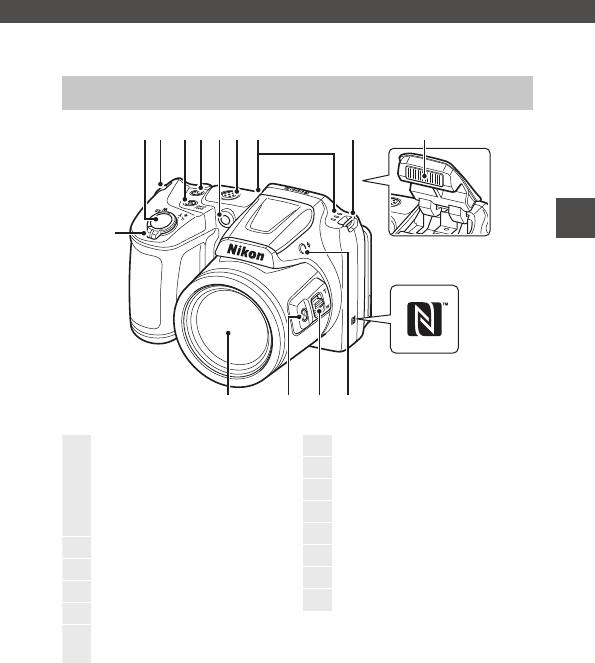
1
Parts of the Camera
Parts of the Camera
The Camera Body
1214
10
876 9
4 33
1
13
5
11
2
1
Zoom control........................................ 14
f: Wide-angle..............................14
g: Telephoto................................. 14
h: Thumbnail playback..........58
i: Playback zoom...................... 57
j: Help .............................................24
2Shutter-release button.................... 13
3Eyelet for camera strap ......................6
4Power switch/power-on lamp......9
5Z (Wi-Fi) button...................119, 121
6Self-timer lamp ....................................45
AF-assist illuminator
7Speaker
8Microphone (stereo)
9Flash.................................................... 11, 43
10 N-Mark (NFC antenna)........119, 121
11 m (flash pop-up) button......... 11, 43
12 Side zoom control ............................. 14
13 q (snap-back zoom) button...... 15
14 Lens
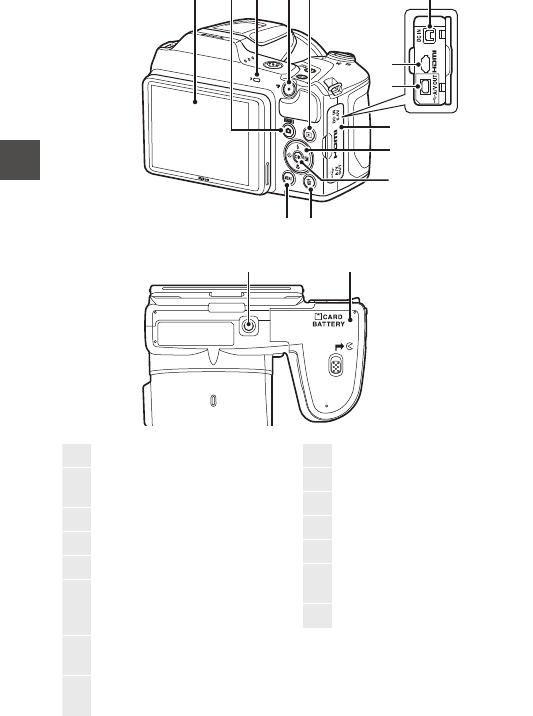
2
Parts of the Camera
1213
5
10
432
9
16
15 14
11
8
7
1Monitor................................................ 3, 22
2A (shooting mode) button
................................23, 24, 33, 35, 38, 41
3Flash lamp...............................................44
4b (e movie-record) button..... 68
5c (playback) button ......................17
6
DC input connector
(for AC adapter available
separately from Nikon)................. 147
7HDMI micro connector
(Type D) ................................................. 122
8USB/audio/video output
connector............................................. 122
9Connector cover.............................. 122
10 Multi selector ........................................75
11 k (apply selection) button ......... 75
12 l (delete) button .............................. 18
13 d (menu) button.......................... 75
14 Battery-chamber/
memory card slot cover ....................7
15 Tripod socket ..................................... 150
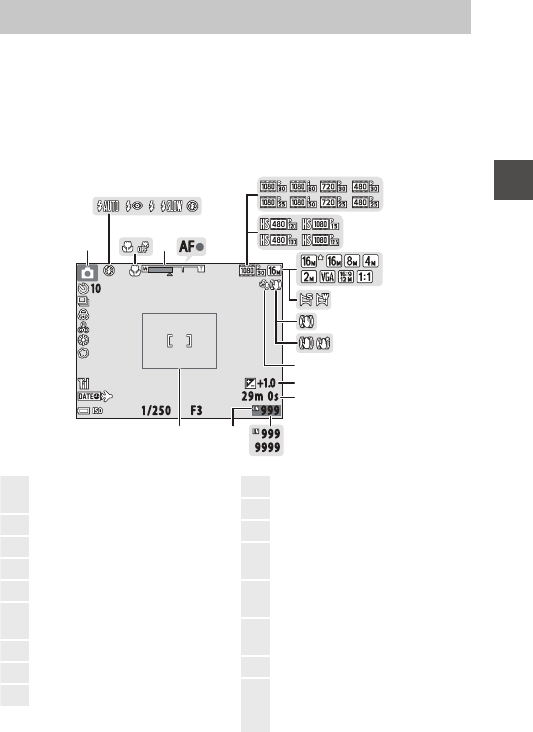
3
Parts of the Camera
The information that is displayed in the monitor during shooting and playback
changes depending on the camera’s settings and state of use.
By default, information is displayed when the camera is turned on and when
you operate the camera, and turns off after a few seconds (when Photo info is
set to Auto info in Monitor settings (A109)).
Shooting Mode
The Monitor
999
2 9 m 0 s
F31/250
9 9 9
9 9 9 9
+1.0
10
AF
1
2
345
6
8
9
10
11
12
13
14
15
1617
7
1Shooting mode
........................20, 23, 24, 33, 35, 38, 41
2Flash mode............................................. 43
3Macro mode..........................................46
4Zoom indicator............................ 14, 46
5Focus indicator ....................................13
6Movie options (normal speed
movies)......................................................98
7Movie options (HS movies) .......... 99
8Image mode.......................................... 77
9Easy panorama..................................... 30
10 Photo VR icon .................................... 112
11 Movie VR icon.................................... 103
12 Wind noise reduction ................... 103
13 Exposure compensation value
....................................................... 35, 41, 47
14 Remaining movie recording time
....................................................................... 68
15 Number of exposures remaining
(still images)........................................... 10
16 Internal memory indicator............ 10
17
Framing border (Moon or Bird-
watching scene mode, or snap-
back zoom)..................................... 15, 29
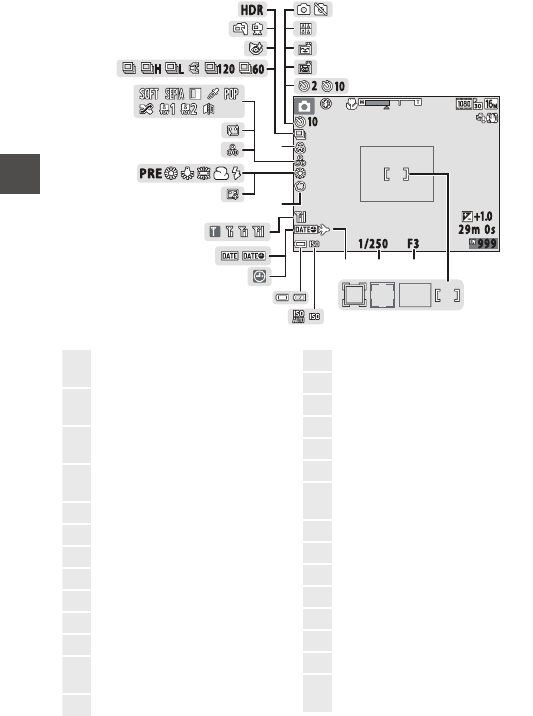
4
Parts of the Camera
H D R
PRE
10
2
999
2 9 m 0 s
F 3
1/250
+1.0
10
120
HL6 0
18192021
222324
25
26
27
28
29
32
35
37
38
39
40
41
42
43
44
45
34
36
33
30
31
18 Focus area (manual or center)
............................................................... 54, 84
19 Focus area (target finding AF)
............................................................... 52, 85
20 Focus area (face detection,
pet detection)................28, 35, 50, 84
21 Focus area (subject tracking)
............................................................... 85, 86
22 Aperture value...................................... 16
23 Shutter speed ....................................... 16
24 Travel destination icon................. 107
25 ISO sensitivity........................................ 83
26 Battery level indicator......................10
27 “Date not set” indicator ............... 141
28 Date stamp.......................................... 111
29 Wi-Fi communication indicator
..........................................................105, 119
30 Soft .............................................................. 35
31 Foundation makeup......................... 35
32 White balance mode........................ 79
33 Hue.............................................................. 41
34 Skin softening....................................... 35
35 Special effects....................................... 90
36 Vividness .................................................. 41
37 Continuous shooting mode
............................................................... 28, 81
38 Blink proof icon.................................... 89
39 Hand-held/tripod....................... 25, 26
40 Backlighting (HDR) ............................27
41 Self-timer indicator............................45
42 Pet portrait auto release................. 28
43 Smile timer .............................................36
44 Self-Collage .................................... 37, 88
45 Still image capture
(during movie recording)..............71
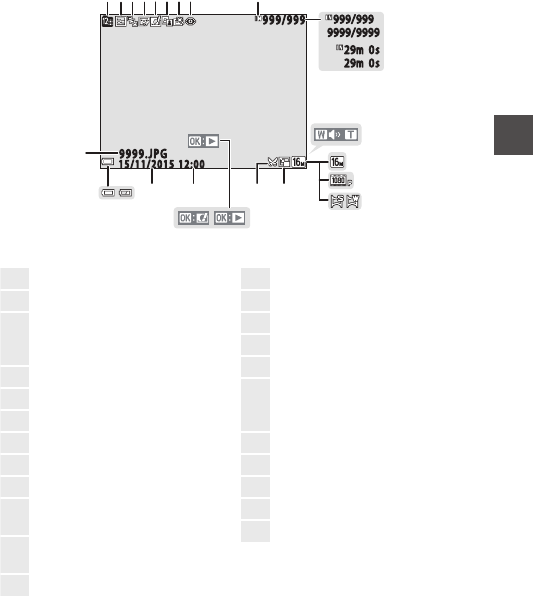
5
Parts of the Camera
Playback Mode
999
/
999
9999
/
9999
29
m
0s
29
m
0s
9 9 9 9 . J P G
15/11/2015 12:00
999/999
1 2 34567 8 9
10
11
12
13
14
15
1617
1819
20
21
22
23
1List by date icon.................................. 59
2Protect icon............................................94
3
Sequence display (when
Individual pictures is selected)
.......................................................................96
4Glamour retouch icon..................... 65
5Quick effects icon............................... 62
6D-Lighting icon.................................... 64
7Quick retouch icon............................ 63
8Red-eye correction icon.................64
9Internal memory indicator
10 Current image number/
total number of images
11 Movie length or elapsed playback
time
12 Volume indicator................................ 72
13 Image mode.......................................... 77
14 Movie options ......................................98
15 Easy panorama..................................... 32
16 Small picture icon .............................. 66
17 Crop icon......................................... 57, 67
18
Easy panorama playback guide
Sequence playback guide
Movie playback guide
19 Quick effects guide
20 Time of recording
21 Date of recording
22 Battery level indicator...................... 10
23 File number and type ................... 146
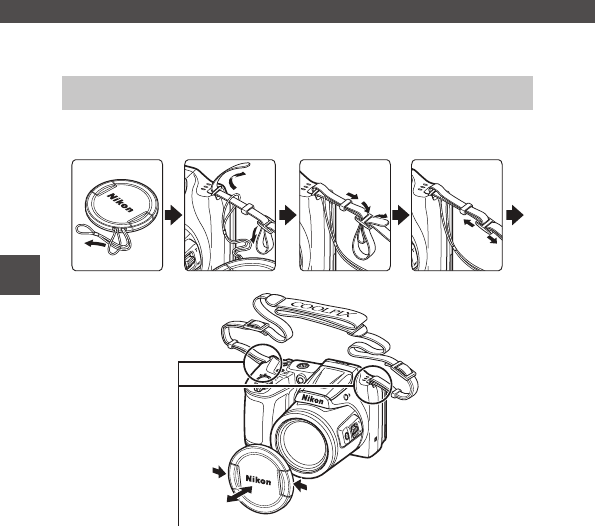
6
Preparing for Shooting
Preparing for Shooting
Attach the lens cap to the camera strap, and then attach the strap to the
camera.
BLens Cap
When the camera is not in use, protect the lens by attaching the lens cap.
Attaching the Camera Strap and Lens Cap
Attach them at two places.
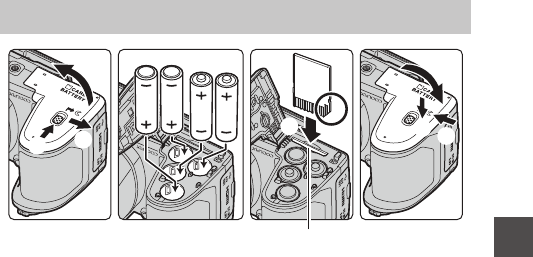
7
Preparing for Shooting
•Hold the camera upside down to prevent the batteries from falling out,
confirm that the positive (+) and negative (–) terminals of the batteries are
oriented correctly, and insert the batteries.
•Slide the memory card in until it clicks into place (5).
•Be careful not to insert the batteries or memory card upside-down or
backward, as this could cause a malfunction.
•When closing the cover, slide it while securely holding down the area
marked 7.
BFormatting a Memory Card
The first time you insert a memory card that has been used in another device into
this camera, make sure to format it with this camera. Insert the memory card into the
camera, press the d button, and select Format card in the setup menu (A75).
Applicable Batteries
•Four LR6/L40 (AA-size) alkaline batteries (included batteries)
•Four FR6/L91 (AA-size) lithium batteries
•Four EN-MH2 rechargeable Ni-MH (nickel metal hydride) batteries
* EN-MH1 rechargeable Ni-MH batteries cannot be used.
Insert the Batteries and Memory Card
12
34
578
6
Memory card slot
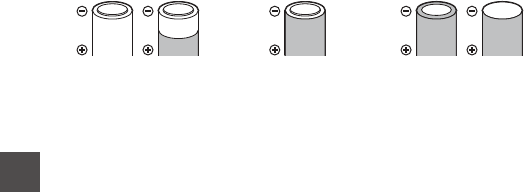
8
Preparing for Shooting
BNotes About the Batteries
•Do not combine old and new batteries or batteries of different makes or types.
•Batteries with the following defects cannot be used:
BNotes About EN-MH2 Rechargeable Batteries
When using EN-MH2 batteries with the camera, charge four batteries at a time using
Battery Charger MH-73 (A134).
CAlkaline Batteries
Performance of alkaline batteries may vary greatly depending on the manufacturer.
Removing the Batteries or Memory Card
Turn the camera off and make sure that the power-on lamp and monitor have
turned off, and then open the battery-chamber/memory card slot cover.
•Gently push the memory card into the camera to partially eject the memory
card.
•Be careful when handling the camera, batteries, and memory card
immediately after using the camera, as they may become hot.
Memory Cards and Internal Memory
Camera data, including images and movies, can be saved either on a memory
card or in the camera’s internal memory. To use the camera’s internal memory,
remove the memory card.
Batteries with insulation
that does not cover the
area around the
negative terminal
Batteries with peeling Batteries with a flat
negative terminal
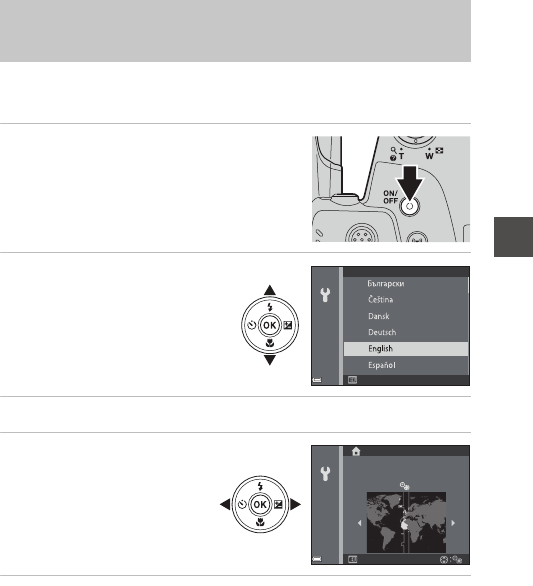
9
Preparing for Shooting
When the camera is turned on for the first time, the language-selection screen
and the date and time setting screen for the camera clock are displayed.
1Remove the lens cap, and then
press the power switch to turn on
the camera.
•The monitor turns on.
•To turn the camera off, press the power
switch again.
2Use the multi selector
HI to select the desired
language and press the
k button.
3Select Yes and press the k button.
4Select your home time
zone and press the
kbutton.
•Press H to display W above
the map and enable
daylight saving time. Press
I to disable it.
5Use HI to select the date format and press the kbutton.
Turn the Camera On and Set the Display
Language, Date, and Time
Ca nc el
La ngu age
Ba ck
Lo nd on, Ca sab lan ca
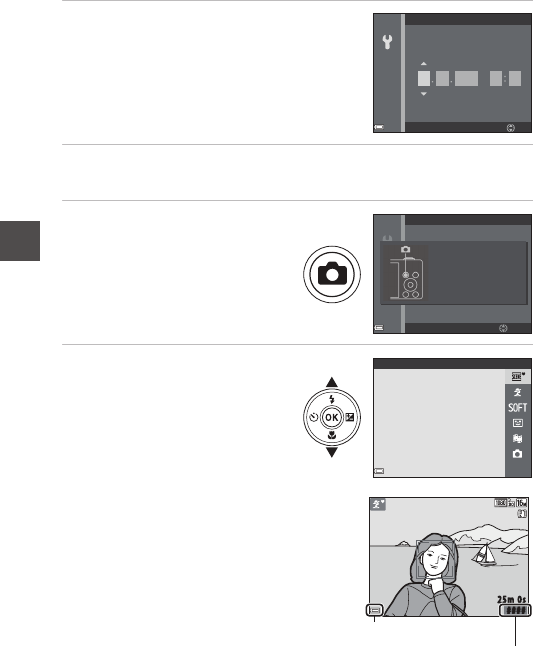
10
Preparing for Shooting
6Set the date and time, and press
the kbutton.
•Use JK to select a field and then use HI
to set the date and time.
•Select the minute field and press the
kbutton to confirm the setting.
7When the confirmation dialog is displayed, use HI to
select Yes and press the k button.
8Press the A (shooting
mode) button.
•The lens extends.
9Select Scene auto
selector and press the
kbutton.
•The shooting screen is displayed, and you
can take pictures in scene auto selector
mode. The camera automatically selects the
optimum scene mode.
•Battery level indicator
b: The battery level is high.
B: The battery level is low.
•Number of exposures remaining
C is displayed when no memory card is
inserted in the camera, and images are
saved in the internal memory.
Da te an d t ime
201501 01 00 00
YMD h m
Ed it
Pre ss thi s b utt on in
sh oot ing mo de fo r
sh oot ing -mo de
se lec tio n m enu .
Ed it
Da te an d t ime
Sc ene au to se lec to r
# # # #
25m 0s
Battery level indicator
Number of exposures
remaining
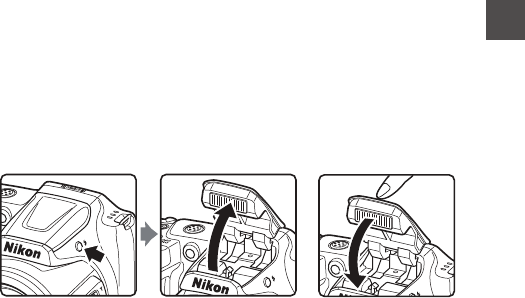
11
Preparing for Shooting
CChanging the Language or the Date and Time Setting
•You can change these settings using the Language and Time zone and date
settings in the zsetup menu (A75).
•You can enable or disable daylight saving time in the z setup menu by selecting
Time zone and date followed by Time zone. Press the multi selector K and then
H to enable daylight saving time and move the clock forward one hour, or I to
disable daylight saving time and move the clock back one hour.
CThe Clock Battery
•The camera’s clock is powered by a built-in backup battery.
The backup battery charges when the main batteries are inserted into the camera
or when the camera is connected to an optional AC adapter, and it can run the
clock for several days after about 10 hours of charging.
•If the camera’s backup battery becomes exhausted, the date and time setting
screen is displayed when the camera is turned on. Set the date and time again
(A9).
Raising and Lowering the Flash
Press the m (flash pop-up) button to raise the flash.
•Push the flash down gently to lower the flash until it clicks into place when
not in use.
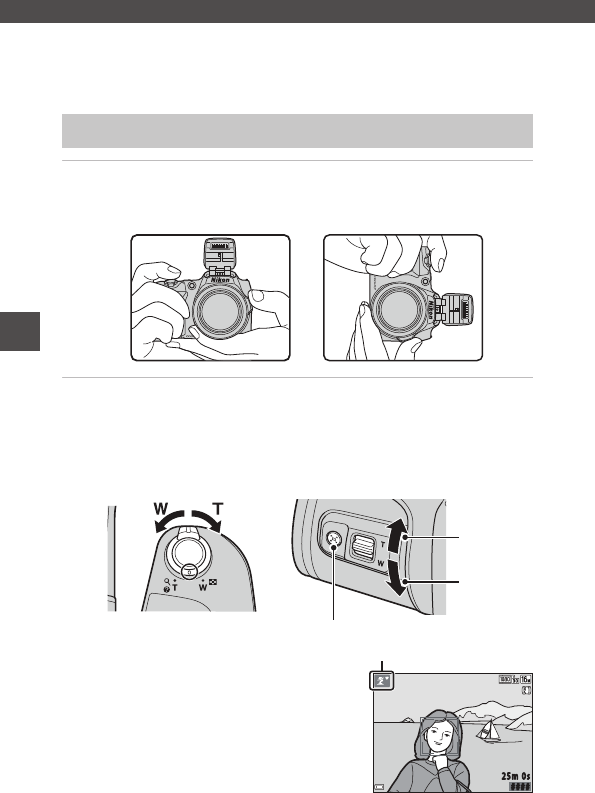
12
Basic Shooting and Playback Operations
Basic Shooting and Playback
Operations
1Hold the camera steady.
•Keep fingers and other objects away from the lens, flash, AF-assist
illuminator, microphone, and speaker.
2Frame the picture.
•Move the zoom control or side zoom control to change the zoom lens position.
•When the subject is lost at the telephoto zoom position, press the q (snap-
back zoom) button to temporarily widen the angle of view so that you can
frame the subject more easily.
•When the camera recognizes the shooting
scene, the shooting mode icon changes
accordingly.
Shooting with Scene Auto Selector Mode
Zoom out Zoom in
Zoom in
Zoom out
q (snap-back zoom) button
# # # #
25m 0s
Shooting mode icon
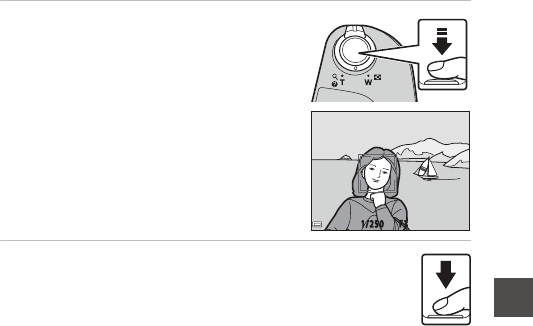
13
Basic Shooting and Playback Operations
3Press the shutter-release button
halfway.
•When the subject is in focus, the focus area
or focus indicator is displayed in green.
•When you are using digital zoom, the
camera focuses in the center of the frame
and the focus area is not displayed.
•If the focus area or focus indicator flashes,
the camera is unable to focus. Modify the
composition and try pressing the shutter-
release button halfway again.
4Without lifting your finger, press
the shutter-release button the rest
of the way down.
BNotes About Saving Images or Movies
The indicator showing the number of exposures remaining or the indicator showing
the remaining recording time flashes while images or movies are being saved. Do
not open the battery-chamber/memory card slot cover or remove the
batteries or memory card while an indicator is flashing. Doing this could result in
loss of data, or in damage to the camera or the memory card.
CThe Auto Off Function
•When no operations are performed for about one minute, the monitor turns off,
the camera enters standby mode, and then the power-on lamp flashes. The
camera turns off after remaining in standby mode for about three minutes.
•To turn the monitor back on while the camera is in standby mode, perform an
operation such as pressing the power switch or shutter-release button.
CWhen Using a Tripod
•We recommend using a tripod to stabilize the camera in the following situations:
- When the flash is lowered in dark locations or when using a shooting mode in
which the flash does not fire
- When the zoom is at a telephoto position
•When using a tripod to stabilize the camera during shooting, set Photo VR to Off
in the setup menu (A75) to prevent potential errors caused by this function.
F 31 / 2 5 0
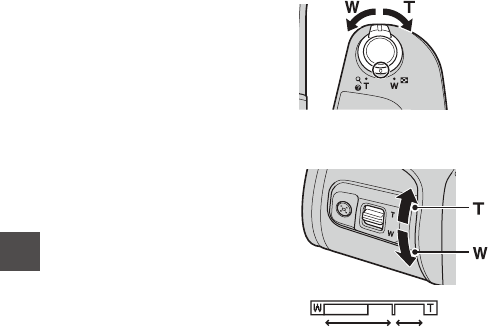
14
Basic Shooting and Playback Operations
Using the Zoom
When you move the zoom control,
the zoom lens position changes.
•To zoom in: Move toward g
•To zoom out: Move toward f
When you turn the camera on,
the zoom moves to the
maximum wide-angle position.
•Rotating the zoom control all the
way in either direction adjusts
the zoom quickly (except during
movie recording).
•The side zoom control (A1) can
also be moved toward g or f
to operate the zoom.
•A zoom indicator is displayed on
the shooting screen when the
zoom control is moved.
•Digital zoom, which allows you
to further magnify the subject up to approximately 4× the maximum optical
zoom ratio, can be activated by moving and holding the zoom control or
the side zoom control toward g when the camera is zoomed in to the
maximum optical zoom position.
CDigital Zoom
The zoom indicator changes to blue when the digital zoom is activated, and it
changes to yellow when the zoom magnification is increased further.
•Zoom indicator is blue: Image quality is not noticeably reduced by using the
Dynamic Fine Zoom.
•Zoom indicator is yellow: There may be cases in which image quality is noticeably
reduced.
•The indicator remains blue across a wider area when the image size is smaller.
•The zoom indicator may not change to blue when using certain continuous
shooting settings or other settings.
Wide-angle Telephoto
Wide-
angle
Telephoto
Optical zoom Digital zoom
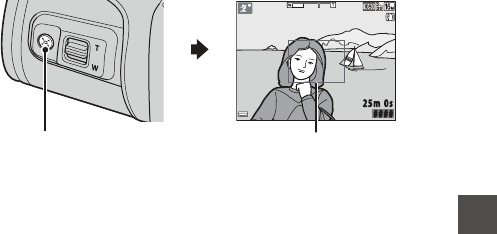
15
Basic Shooting and Playback Operations
Using the Snap-back Zoom
When the subject is lost at the telephoto zoom position, press the q (snap-
back zoom) button to temporarily widen the angle of view so that you can
frame the subject more easily.
•While pressing the q button, frame the subject inside the framing border of
the shooting screen.
•To change the angle of view further, move the zoom control while pressing
the q button.
•Release the q button to return to the original zoom position.
BNotes About Snap-back Zoom
The snap-back zoom cannot be used during movie recording.
# # # #
2 5 m 0 s
q button Framing border
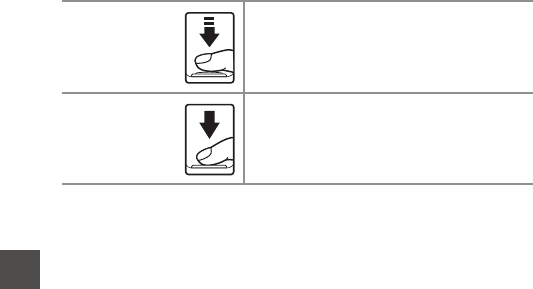
16
Basic Shooting and Playback Operations
The Shutter-release Button
Press halfway
To set focus and exposure (shutter speed and
aperture value), press the shutter-release button
lightly until you feel a slight resistance. Focus and
exposure remain locked while the shutter-release
button is pressed halfway.
Press all the way
Press the shutter-release button all the way to
release the shutter and take a picture.
Do not use force when pressing the shutter-
release button, as this may result in camera shake
and blurred images. Press the button gently.
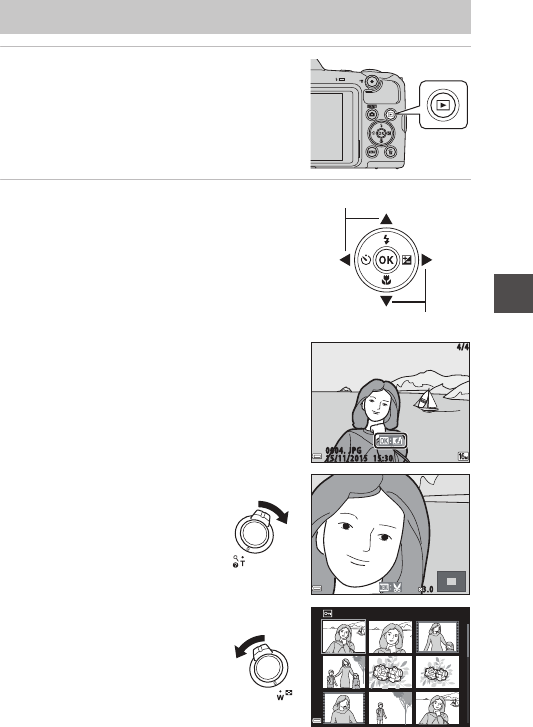
17
Basic Shooting and Playback Operations
1Press the c (playback) button to
enter playback mode.
•If you press and hold down the c button
while the camera is turned off, the camera
turns on in playback mode.
2Use the multi selector to select an
image to display.
•Press and hold down HIJK to scroll
through the images quickly.
•To return to shooting mode, press the
Abutton or shutter-release button.
•When e is displayed in full-frame
playback mode, you can press the
kbutton to apply an effect to the image.
•Move the zoom control
toward g (i) in full-frame
playback mode to zoom in on
an image.
•In full-frame playback mode,
move the zoom control
toward f (h) to switch to
thumbnail playback mode
and display multiple images
on the screen.
Play Back Images
Display the previous image
Display the next image
4 / 4
15/11/2015 15:30
0004. JPG
3.0
1 / 2 0
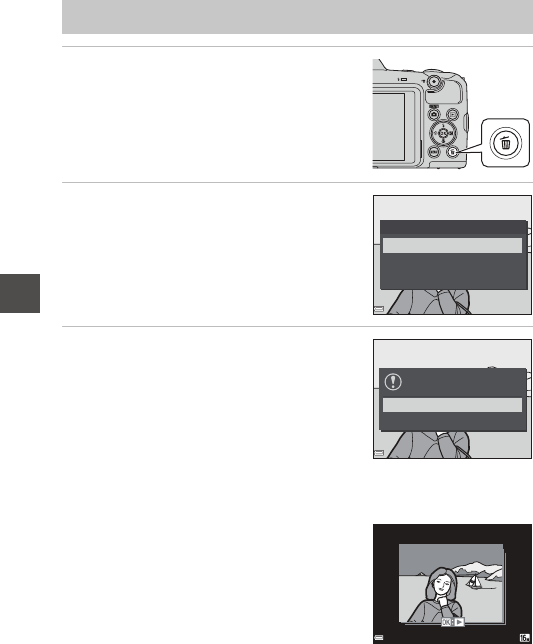
18
Basic Shooting and Playback Operations
1Press the l (delete) button to
delete the image currently
displayed in the monitor.
2Use the multi selector HI to
select the desired deletion
method and press the kbutton.
•To exit without deleting, press the d
button.
3Select Yes and press the
kbutton.
•Deleted images cannot be recovered.
BDeleting Images Captured Continuously (Sequence)
•Images captured continuously are saved as a
sequence, and only the first image of the
sequence (the key picture) is displayed in
playback mode (default setting).
•If you press the l button while a key picture is
displayed for a sequence of images, all images in
the sequence are deleted.
•To delete individual images in a sequence, press
the k button to display them one at a time and press the l button.
CDeleting the Image Captured While in Shooting Mode
When using shooting mode, press the l button to delete the last image that was
saved.
Delete Images
De le te
Cu rre nt i mag e
Er as e sel ec ted i ma ges
Al l image s
Ye s
No
Er as e 1 ima ge ?
1 / 5
15/11/2015 15:30
0004.JPG

19
Basic Shooting and Playback Operations
Operating the Erase Selected Images Screen
1Use the multi selector JK to
select an image to be deleted, and
then use H to display c.
•To undo the selection, press I to remove
c.
•Move the zoom control (A1) toward g (i)
to switch to full-frame playback or f (h)
to switch to thumbnail playback.
2Add c to all images that you want to delete and then press
the kbutton to confirm the selection.
•A confirmation dialog is displayed. Follow the on-screen instructions to
complete operations.
Er ase se le ct ed im age s
Ba ck
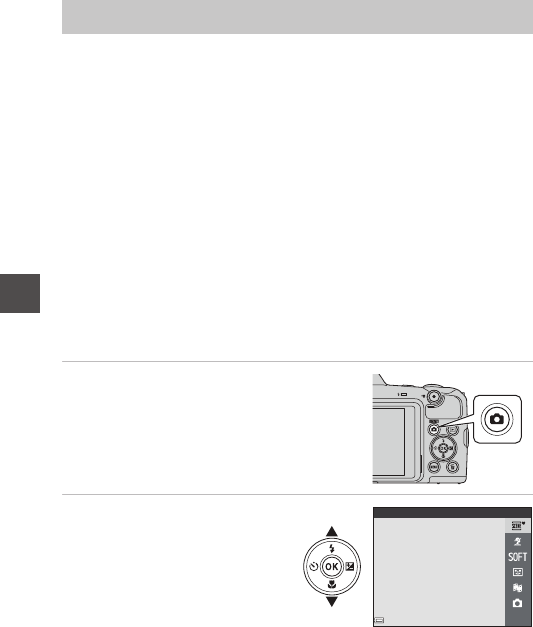
20
Basic Shooting and Playback Operations
The shooting modes described below are available.
•o Scene auto selector
The camera automatically recognizes the shooting scene when you frame a
picture, making it easier to take pictures using settings that suit the scene.
•b Scene mode
Camera settings are optimized according to the scene that you select.
•O Special effects
Effects can be applied to images during shooting.
•F Smart portrait
Use glamour retouch to enhance human faces during shooting, and use the
smile timer or self-collage function to take pictures.
•M Short movie show
You can create a short movie that is up to 30 seconds long by recording and
automatically combining multiple movie clips that are several seconds long.
•A Auto mode
Used for general shooting. Settings can be changed to suit the shooting
conditions and the type of shot you want to capture.
1When the shooting screen is
displayed, press the A (shooting
mode) button.
2Use the multi selector
HI to select a shooting
mode and press the
kbutton.
•When scene mode or special
effects mode is selected, press
K to select a scene mode or
effect before pressing the
kbutton.
Changing the Shooting Mode
Sc ene au to se lec to r
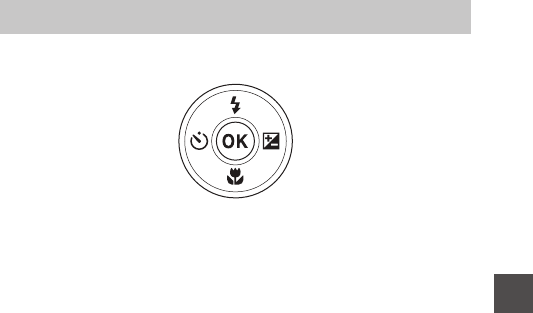
21
Basic Shooting and Playback Operations
When the shooting screen is displayed, you can press the multi selector H(m)
J(n) I(p) K(o) to set the functions described below.
•m Flash mode
You can select a flash mode to match the shooting conditions when the
flash is raised.
•n Self-timer
The camera releases the shutter 10 seconds or 2 seconds after you press the
shutter-release button.
•p Macro mode
Use macro mode when you take close-up pictures.
•o Exposure compensation
You can adjust overall image brightness.
The functions that can be set vary depending on the shooting mode.
Using the Flash, Self-timer, Etc.
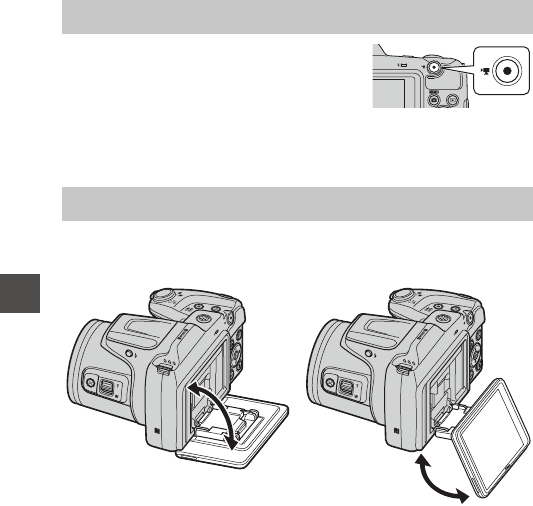
22
Basic Shooting and Playback Operations
Display the shooting screen and press the b
(e movie-record) button to start recording a
movie. Press the b(e) button again to end
recording.
•To play back a movie, select a movie in full-
frame playback mode and press the k button.
The angle of the monitor can be lowered down to approx. #85°# or raised
upward to approx. #90°#. This is convenient when taking pictures with the
camera held at high or low positions.
BNotes About Monitor
•Do not apply excessive force when changing the angle of the monitor.
•The monitor cannot be moved to the left or right.
•Put the monitor back in the original position when using in normal situations.
Recording Movies
Changing the Angle of the Monitor
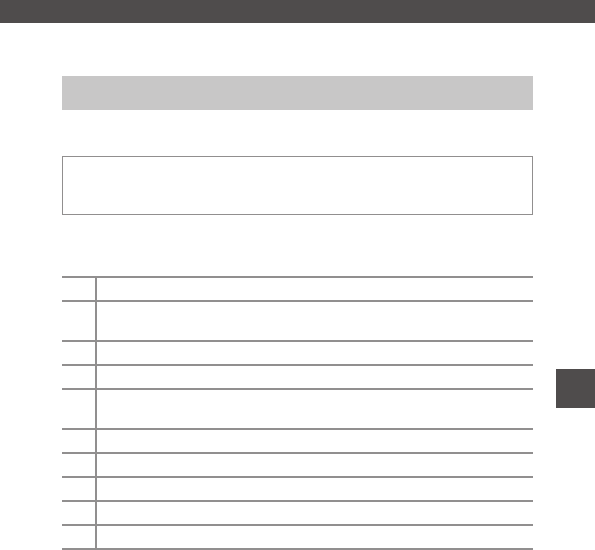
23
Shooting Features
Shooting Features
The camera automatically recognizes the shooting scene when you frame a
picture, making it easier to take pictures using settings that suit the scene.
When the camera automatically recognizes the shooting scene, the shooting
mode icon displayed on the shooting screen changes accordingly.
* One image is captured at a slow shutter speed.
BNotes About o (Scene Auto Selector) Mode
•Depending on shooting conditions, the camera may not select the desired scene
mode. In this case, select another shooting mode (A20).
•When the digital zoom is in effect, the shooting mode icon changes to d.
Functions Available in o (Scene Auto Selector) Mode
•Flash mode (A43)
•Self-timer (A45)
•Exposure compensation (A47)
•Image mode (A77)
o (Scene Auto Selector) Mode
Enter shooting mode M A (shooting mode) button M o (scene auto
selector) mode M kbutton
ePortrait (for taking close-up portraits of one or two people)
bPortrait (for taking portraits of large numbers of people, or images in which
the background takes up a large portion of the frame)
fLandscape
hNight portrait* (for taking close-up portraits of one or two people)
cNight portrait* (for taking portraits of large numbers of people, or images in
which the background takes up a large portion of the frame)
gNight landscape*
iClose-up
jBacklighting (for taking pictures of subjects other than people)
dBacklighting (for taking portrait pictures)
dOther scenes
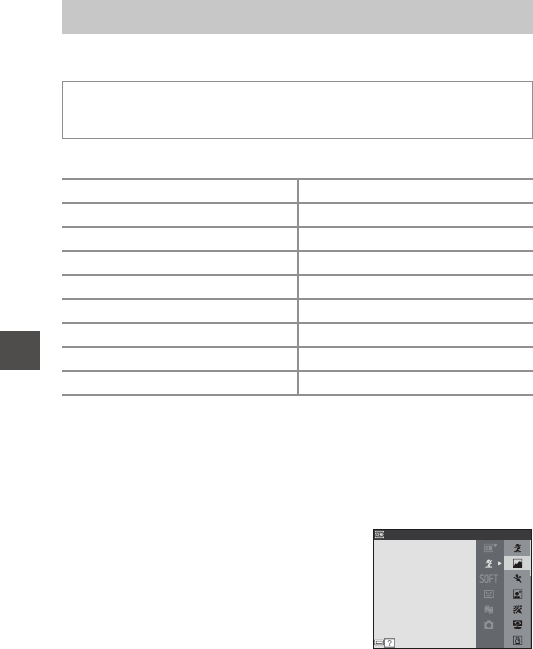
24
Shooting Features
When a scene is selected, camera settings are automatically optimized for the
selected scene.
* The icon of the last scene selected is displayed.
1The camera focuses at infinity.
2The camera focuses on the area in the center of the frame.
3Use of a tripod is recommended, because the shutter speed is slow. Set Photo VR
(A112) to Off in the setup menu when using a tripod to stabilize the camera
during shooting.
Displaying a Description of Each Scene Mode (Help Display)
Select a scene and move the zoom control
(A1) toward g(j) to view a description of
that scene. To return to the previous screen,
move the zoom control toward g (j) again.
Scene Mode (Shooting Suited to Scenes)
Enter shooting mode M A (shooting mode) button M b (second icon
from the top*) M K M HI M select a scene M k button
bPortrait (default setting) jNight landscape1, 2 (A26)
cLandscape1, 2 kClose-up (A26)
dSports2 (A25) uFood (A26)
eNight portrait (A25) mFireworks show1, 3 (A26)
fParty/indoor2 (A25) oBacklighting (A27)
ZBeach2pEasy panorama2 (A30)
zSnow2OPet portrait (A28)
hSunset2, 3 LMoon (A29)1, 2
iDusk/dawn1, 2, 3 lBird-watching (A29)1, 2
La nds cap e

25
Shooting Features
Tips and Notes
dSports
•While the shutter-release button is held all the way down, the camera shoots up
to about #7# images continuously at a rate of about #9.2# fps (when Image
mode is set to P4608×3456).
•The frame rate for continuous shooting may vary depending on the current
image mode setting, the memory card used, or shooting conditions.
•Focus, exposure, and hue are fixed at the values determined with the first image
in each series.
e Night portrait
•Raise the flash before shooting.
•On the screen displayed when e Night portrait is selected, select Y Hand-
held or ZTripod.
•Y Hand-held (default setting):
- While the e icon on the shooting screen is displayed in green, press the
shutter-release button all the way to capture a series of images which are
combined into a single image and saved.
- Once the shutter-release button is pressed all the way, hold the camera still
until a still image is displayed. After taking a picture, do not turn the camera
off before the monitor switches to the shooting screen.
- If the subject moves while the camera is shooting continuously, the image
may be distorted, overlapped, or blurred.
•Z Tripod:
- One image is captured at a slow shutter speed when the shutter-release
button is pressed all the way.
- Vibration reduction is disabled even when Photo VR (A112) in the setup
menu is set to On.
f Party/indoor
•To avoid the effects of camera shake, hold the camera steady. Set Photo VR
(A112) to Off in the setup menu when using a tripod to stabilize the camera
during shooting.
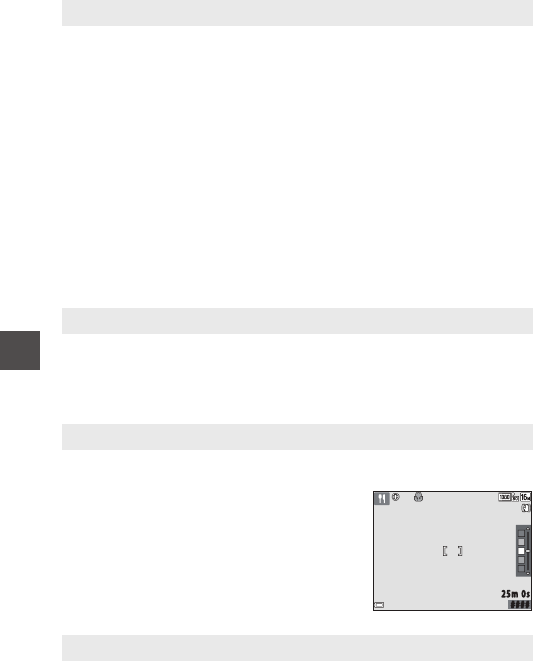
26
Shooting Features
j Night landscape
•On the screen displayed when j Night landscape is selected, select
YHand-held or ZTripod.
•Y Hand-held (default setting):
- While the j icon on the shooting screen is displayed in green, press the
shutter-release button all the way to capture a series of images which are
combined into a single image and saved.
- Once the shutter-release button is pressed all the way, hold the camera still
until a still image is displayed. After taking a picture, do not turn the camera
off before the monitor switches to the shooting screen.
- The angle of view (i.e., the area visible in the frame) seen in the saved image is
narrower than that seen in the monitor at the time of shooting.
•ZTripod:
- One image is captured at a slow shutter speed when the shutter-release
button is pressed all the way.
- Vibration reduction is disabled even when Photo VR (A112) in the setup
menu is set to On.
k Close-up
•Macro mode (A46) is enabled and the camera automatically zooms to the
closest position at which it can focus.
•You can move the focus area. Press the k button, use the multi selector
HIJK to move the focus area, and press the k button to apply the setting.
u Food
•Macro mode (A46) is enabled and the camera automatically zooms to the
closest position at which it can focus.
•You can adjust hue by using the multi selector
HI. The hue setting is saved in the camera’s
memory even after the camera is turned off.
•You can move the focus area. Press the
kbutton, use the multi selector HIJK to
move the focus area, and press the k button to
apply the setting.
m Fireworks show
•The shutter speed is fixed at four seconds.
# # # #
2 5 m 0 s

27
Shooting Features
o Backlighting
•On the screen displayed when o Backlighting is selected, select o or k
to enable or disable the high dynamic range (HDR) function based on the type
of image you want to capture.
•k (default setting): The flash fires to prevent the subject from being hidden in
shadow. Raise the flash before shooting.
- When the shutter-release button is pressed all the way down, one image is
captured.
•o: Use when taking pictures with very bright and dark areas in the same frame.
- When the shutter-release button is pressed all the way, the camera shoots
images continuously at high speed, and saves the following two images:
- A non-HDR composite image
- An HDR composite image in which the loss of details in highlights or
shadows is minimized
- If there is only enough memory to save one image, an image processed by D-
Lighting (A64) at the time of shooting, in which dark areas of the image are
corrected, is the only image saved.
- Once the shutter-release button is pressed all the way, hold the camera still
until a still image is displayed. After taking a picture, do not turn the camera
off before the monitor switches to the shooting screen.
- The angle of view (i.e., the area visible in the frame) seen in the saved image is
narrower than that seen in the monitor at the time of shooting.

28
Shooting Features
BPet Portrait Auto Release
•Press the multi selector J (n) to change the Pet portrait auto release setting.
-Y: The camera detects a dog or cat face and automatically releases the shutter.
-k: The camera does not release the shutter automatically, even if a dog or cat
face is detected. Press the shutter-release button. The camera also detects
human faces when k is selected.
•Pet portrait auto release is set to k after five bursts have been taken.
•Shooting is also possible by pressing the shutter-release button, regardless of the
Pet portrait auto release setting. When V Continuous is selected, you can
take pictures continuously while holding down the shutter-release button all the
way.
BFocus Area
•When the camera detects a face, the face is
displayed inside a yellow border. When the
camera acquires focus on a face displayed inside a
double border (focus area), the double border
changes to green. If no faces are detected, the
camera focuses on the subject in the center of the
frame.
•Under some shooting conditions, the pet face
may not be detected and other subjects may be displayed inside a border.
O Pet portrait
•When you point the camera at a dog or cat, the camera detects the pet’s face and
focuses on it. By default, the camera detects a dog or cat face and automatically
releases the shutter (pet portrait auto release).
•On the screen displayed when O Pet portrait is selected, select U Single or
VContinuous.
-U Single: The camera captures one image when a dog or cat face is
detected.
-V Continuous: The camera captures three images continuously when a dog
or cat face is detected.
# # # #
25m 0s
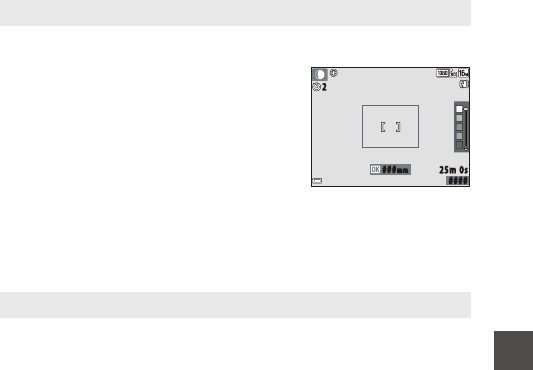
29
Shooting Features
L Moon
•You can adjust hue by using the multi selector HI. The hue setting is saved in
the camera’s memory even after the camera is turned off.
•Adjust the brightness with exposure
compensation (A47) according to shooting
conditions such as the waxing and waning of
the moon and shooting requirements.
•At the wide-angle zoom position, the framing
border is displayed to indicate the angle of view
equivalent to that of #855# mm lens (in 35mm
[135] format). The angle of view becomes
equivalent to that of #855# mm lens by pressing
the k button.
•When the subject is lost at the telephoto zoom position, press the q (snap-back
zoom) button to temporarily widen the angle of view so that you can frame the
subject more easily.
l Bird-watching
•From the screen displayed after l Bird-watching is selected, select U Single
or V Continuous.
•U Single: One image is shot each time the shutter-release button is pressed.
•V Continuous (default setting): While the shutter-release button is held all the
way down, images are captured continuously.
- The frame rate for continuous shooting is about #9.2# fps and the maximum
number of continuous shots is about #7# (when image size is set to
#P4608×3456#).
•At the wide-angle zoom position, the framing border is displayed to indicate the
angle of view equivalent to that of #440# mm lens (in 35mm [135] format). The
angle of view becomes equivalent to that of #440# mm lens by pressing the
kbutton.
•When the subject is lost at the telephoto zoom position, press the q (snap-back
zoom) button to temporarily widen the angle of view so that you can frame the
subject more easily.
# # # #
2 5 m 0 s
# # #
m m
2
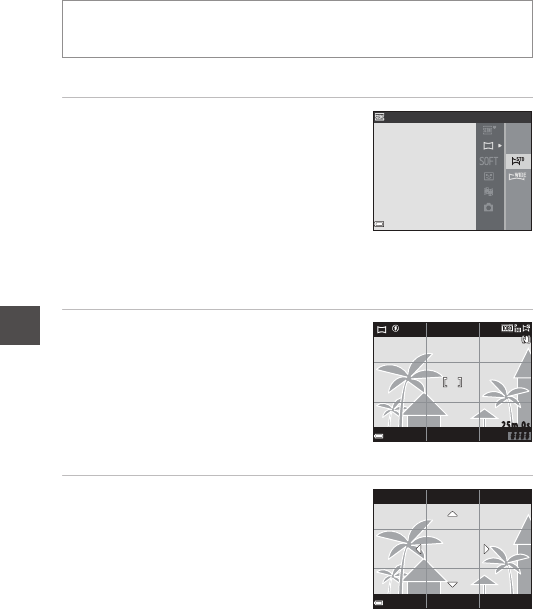
30
Shooting Features
Shooting with Easy Panorama
* The icon of the last scene selected is displayed.
1Select W Normal or X Wide
as the shooting range and press
the k button.
•When the camera is readied in the
horizontal position, the image size (width ×
height) is as follows:
-W Normal: 4800 × 920 when moved
horizontally, 1536 × 4800 when moved
vertically
-X Wide: 9600 × 920 when moved horizontally, 1536 × 9600 when
moved vertically
2Frame the first edge of the
panorama scene, and then press
the shutter-release button
halfway to focus.
•The zoom position is fixed at wide-angle
position.
•The camera focuses in the center of the
frame.
3Press the shutter-release button
all the way, and then remove your
finger from the shutter-release
button.
•KLJI are displayed to indicate the
direction of camera movement.
Enter shooting mode M A (shooting mode) button M b (second icon
from the top*) M K M HI M p (easy panorama) M k button
No rma l
# # # #
25m 0s
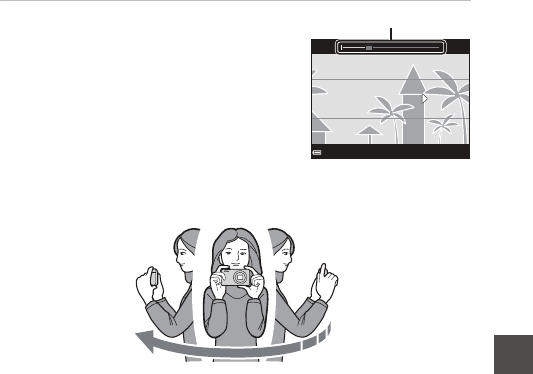
31
Shooting Features
4Move the camera in one of the
four directions until the guide
indicator reaches the end.
•When the camera detects which direction it
is moving in, shooting begins.
•Shooting ends when the camera captures
the specified shooting range.
•Focus and exposure are locked until
shooting ends.
Example of camera movement
•Using your body as the axis of rotation, move the camera slowly in an arc, in
the direction of the marking (KLJI).
•Shooting stops if the guide does not reach the edge within about 15
seconds (when WNormal is selected) or within about 30 seconds (when
X Wide is selected) after shooting starts.
BNotes About Easy Panorama Shooting
•The range of the image seen in the saved image is narrower than that seen in the
monitor at the time of shooting.
•If the camera is moved too quickly or shaken too much, or if the subject is too
uniform (e.g. walls or darkness), an error may occur.
•If shooting is stopped before the camera reaches the half-way point in the
panorama range, a panorama image is not saved.
•If more than half of the panorama range is captured but shooting ends before
reaching the edge of the range, the range not captured is recorded and displayed
in gray.
Guide
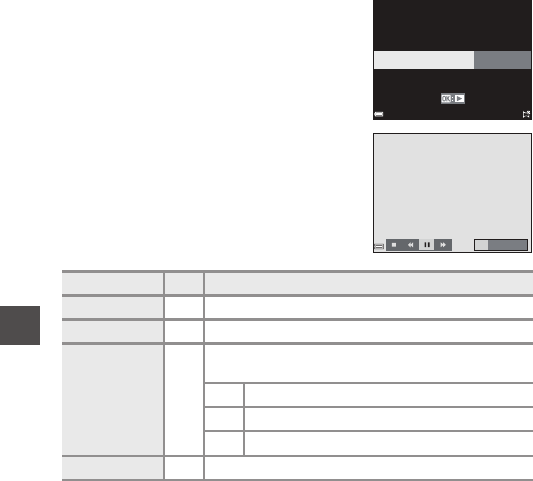
32
Shooting Features
Playback with Easy Panorama
Switch to playback mode (A17), display an
image captured using easy panorama in full-
frame playback mode, and then press the
kbutton to scroll the image in the direction
that was used when shooting.
Playback controls are displayed in the monitor
during playback. Use the multi selector JK to
select a control, and then press the k button to
perform the operations described below.
BNotes About Easy Panorama Images
•The images cannot be edited on this camera.
•This camera may not be able to scroll the playback of, or zoom in on, easy
panorama images captured with another make or model of digital camera.
BNotes About Printing Panorama Images
The entire image may not be able to be printed depending on the printer’s settings.
Additionally, printing may not be possible depending on the printer.
Function Icon Description
Rewind AHold down the k button to scroll backward quickly.
Advance BHold down the k button to scroll forward quickly.
Pause E
Pause playback. The operations listed below can be
performed while paused.
CHold down the k button to rewind.
DHold down the k button to scroll.
FResume automatic scrolling.
End GSwitch to full-frame playback mode.
15/11/2015 15:30
4 / 4
0 0 0 4 . J P G
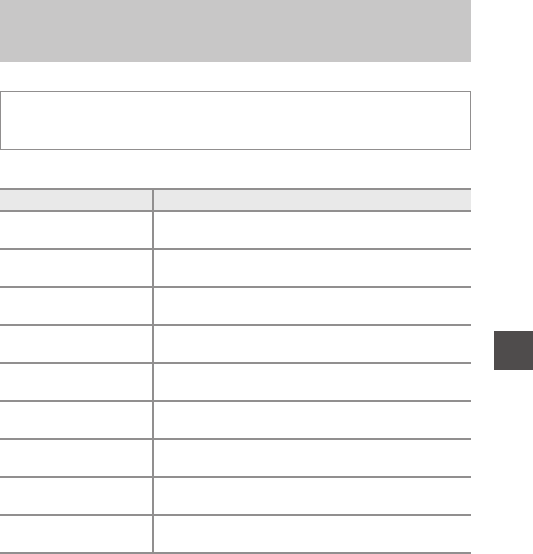
33
Shooting Features
Effects can be applied to images during shooting.
* The icon of the last effect selected is displayed.
* Certain Movie options (A99) are not available.
Special Effects Mode (Applying Effects
When Shooting)
Enter shooting mode M A (shooting mode) button M O (third icon
from the top*) M K M HI M select an effect M k button
Type Description
O Soft*
(default setting)
Softens the image by adding a slight blur to the entire
image.
P Nostalgic sepia* Adds a sepia tone and reduces the contrast to simulate
the qualities of an old photograph.
F High-contrast
monochrome*
Changes the image to black and white and gives it
sharp contrast.
I Selective color Creates a black and white image in which only the
specified color remains.
l Pop Increases the color saturation of the entire image to
create a bright look.
o Cross process Gives the image a mysterious appearance based on a
specific color.
m Toy camera effect 1* Gives the entire image a yellowish hue and darkens the
image periphery.
n Toy camera effect 2* Decreases the color saturation of the entire image and
darkens the image periphery.
b Mirror* Creates a bilaterally symmetric image whose right half
is an inverted mirror image of the left half.

34
Shooting Features
•The camera focuses on the area in the center of the frame.
•When Selective color or Cross process is
selected, use the multi selector HI to select
the desired color, and press the k button to
apply the color. To change the color
selection, press the k button again.
Sa veSa ve
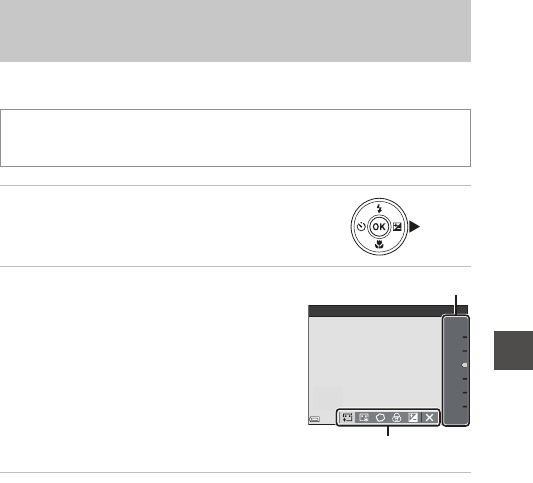
35
Shooting Features
You can take a picture with the glamour retouch function to enhance human
faces.
1Press the multi selector K.
2Apply an effect.
•Use JK to select the desired effect.
•Use HI to select the amount of effect.
•You can simultaneously apply multiple
effects.
BSkin softening, lFoundation
makeup, QSoft, GVividness,
oBrightness (Exp. +/-)
•Select f Exit to hide the slider.
•After configuring the desired effects, press
the k button to apply them.
3Frame the picture and press the shutter-release button.
BNotes About Smart Portrait Mode
•The amount of effect may differ between the image on the shooting screen and
the saved image.
•When Soft is set, some Movie options (A98) are not available.
Functions Available in Smart Portrait Mode
•Glamour retouch (A35)
•Smile timer (A36)
•Self-Collage (A37)
•Flash mode (A43)
•Self-timer (A45)
•Smart portrait menu (A88)
Smart Portrait Mode (Enhancing Human
Faces When Shooting)
Enter shooting mode M A (shooting mode) button M F Smart portrait
mode M kbutton
Sk in sof te nin g
O F F
1
2
3
4
5
Slider
Effect
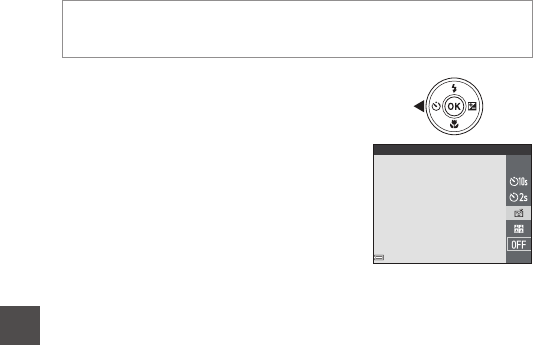
36
Shooting Features
Using Smile Timer
When you press the multi selector J to select
a Smile timer and press the k button, the
camera automatically releases the shutter
whenever a smiling face is detected.
•Set the glamour retouch function before
selecting smile timer (A35).
•When you press the shutter-release button to
take a picture, smile timer is terminated.
BNotes About Smile Timer
•Under some shooting conditions, the camera may be unable to detect faces or
smiles (A50). The shutter-release button can also be used for shooting.
•This function may not be available to use in combination with other functions
(A55).
CWhen the Self-timer Lamp Flashes
When using smile timer, the self-timer lamp flashes when the camera detects a face
and flashes quickly immediately after the shutter is released.
Enter shooting mode M A (shooting mode) button M F Smart portrait
mode M k button
Sm ile ti mer
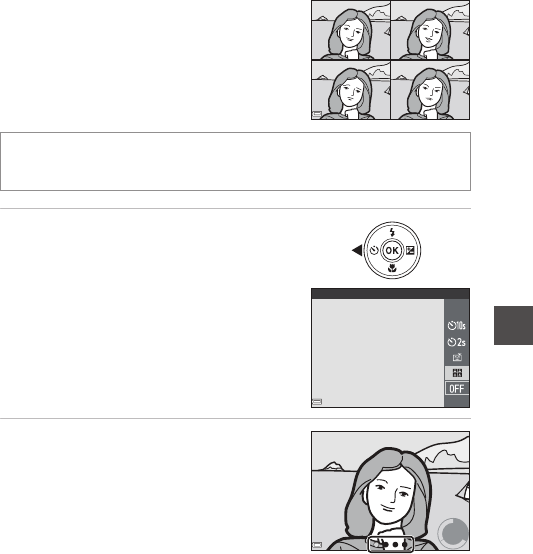
37
Shooting Features
Using Self-Collage
The camera can capture a series of four or nine
images at intervals and save them as a one-
frame image (a collage image).
1Press the multi selector J to
select n Self-Collage, and press
the k button.
•A confirmation dialog is displayed.
•When you press the d button and select
Self-Collage before pressing J, you can
configure the settings for Number of shots,
Interval, and Shutter sound (A88).
•If you want to apply glamour retouch when
shooting, set the effect before selecting
self-collage (A35).
2Take a picture.
•When you press the shutter-release button,
a countdown starts (about five seconds) and
the shutter is automatically released.
•
The camera automatically releases the shutter
for the remaining pictures. A countdown starts
about three seconds before shooting.
•The number of shots is indicated by U in
the monitor. It is displayed in green during
shooting and it changes to white after shooting.
•When the camera finishes taking the specified number of shots, the collage
image is saved.
•
Each captured image is saved as an individual image separate from the collage image.
BNotes About Self-Collage
•If you press the shutter-release button before the camera takes the specified number
of shots, shooting is canceled and the collage image is not saved. The pictures that
were taken before shooting was canceled are saved as individual images.
•This function may not be available to use in combination with other functions (A55).
Enter shooting mode M A (shooting mode) button M F Smart portrait
mode M k button
Se lf- Col lag e
2
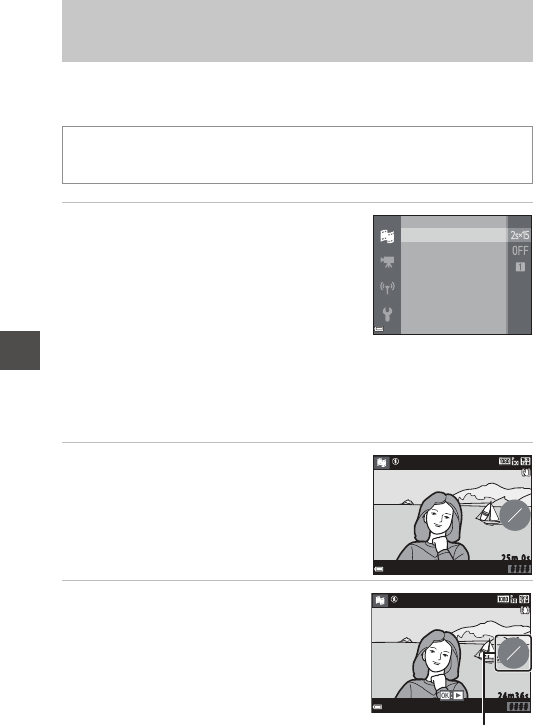
38
Shooting Features
You can create a short movie (e 1080/30p or S 1080/25p) that is up to
30 seconds long by recording and automatically combining multiple movie
clips that are several seconds long.
1Press the d (menu) button and
configure the settings for
recording movies.
•
Number of shots
: Set the number of movie
clips that the camera records and the recording
time for each movie clip. By default, the camera
records 15 movie clips that are 2 seconds each
to create a 30-second short movie.
•Special effects: Apply various effects to movies when shooting. Effects can
be changed for each movie clip.
•Background music: Select the background music.
•After the settings are complete, press the d button or shutter-release
button to exit the menu.
2Press the b (e movie-record)
button to record a movie clip.
•The camera stops recording the movie clip
when the time specified in step 1 elapses.
•Movie clip recording can be paused
temporarily.
See “Pausing Movie Recording” (A40).
3Check the recorded movie clip, or
delete it.
•To check it, press the k button.
•To delete it, press the l button. The last
recorded movie clip or all movie clips can
be deleted.
•To continue recording movie clips, repeat
the operation in step 2.
•To change the effects, return to step 1.
Short Movie Show Mode (Combining
Movie Clips to Create Short Movies)
Enter shooting mode M A (shooting mode) button M n Short movie
show mode M k button
Nu mb er of s hots
Sp ec ial e ects
Ba ck gro un d mus ic
En d rec ordin g
# # # #
25m 0s
0
15
# # # #
2 4 m 3 6 s
12
15
Number of movie clips
recorded
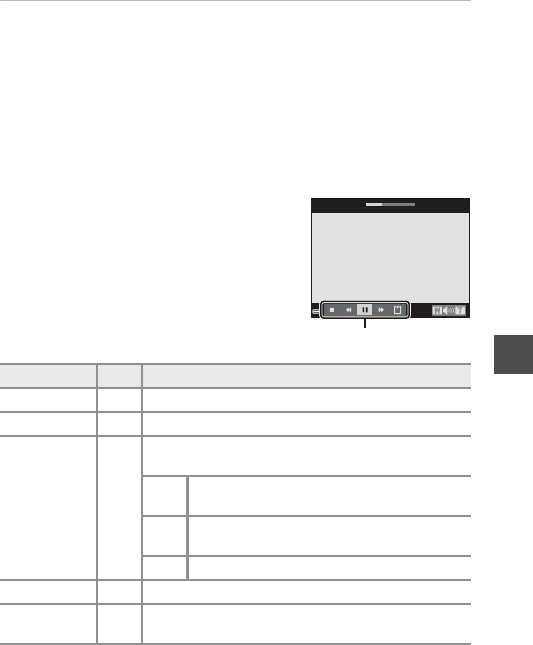
39
Shooting Features
4Save the short movie show.
•The short movie show is saved when the camera finishes recording the
specified number of movie clips.
•To save a short movie show before the camera finishes recording the
specified number of movie clips, press the d button on the shooting
screen while a movie clip is not being recorded, and then select End
recording.
•Movie clips are deleted when a short movie show is saved.
Operations During Movie Clip Playback
To adjust the volume, move the zoom control
while a movie clip is playing (A1).
Playback controls are displayed in the monitor.
The operations described below can be
performed by using the multi selector JK to
select a control and then pressing the
kbutton.
BNotes About Recording a Short Movie Show
•The camera cannot record movies if a memory card is not inserted.
•Do not exchange the memory card until a short movie show is saved.
Function Icon Description
Rewind AHold down the k button to rewind the movie.
Advance BHold down the k button to advance the movie.
Pause E
Pause playback. The operations listed below can be
performed while paused.
CRewind the movie one frame. Hold down the
kbutton for continuous rewinding.
DAdvance the movie one frame. Hold down the
k button for continuous advancing.
FResume playback.
End playback GReturn to the shooting screen.
End recording pSave the short movie show using the recorded movie
clips.
10 s
Playback controls

40
Shooting Features
CPausing Movie Recording
•A still image (l 4608×2592) can be captured if you press the shutter-release
button on the shooting screen while a movie is not being recorded.
•You can pause movie recording and play back images or enter other shooting
modes to take pictures. Movie recording resumes when you enter short movie
show mode again.
Functions Available in Short Movie Show Mode
•Self-timer (A45)
•Macro mode (A46)
•Exposure compensation (A47)
•Short movie show menu (A90)
•Movie options menu (A98)

41
Shooting Features
Used for general shooting. Settings can be adjusted to suit the shooting
conditions and the type of shot you want to capture.
•You can change how the camera selects the area of the frame to focus on by
changing the AF area mode setting (A84). The default setting is Target
finding AF (A52).
Functions Available in A (Auto) Mode
•Creative slider (A41)
•Flash mode (A43)
•Self-timer (A45)
•Macro mode (A46)
•Shooting menu (A77)
Using the Creative Slider
You can adjust the brightness (exposure compensation), vividness, and hue
when shooting.
1Press the multi selector K.
2Use JK to select an item.
•F Hue: Adjust the hue (reddish/bluish) of
the entire image.
•G Vividness: Adjust the vividness of the
entire image.
•o Brightness (Exp. +/-): Adjust the
brightness of the entire image.
A (Auto) Mode
Enter shooting mode M A (shooting mode) button M A (auto) mode
M k button
Enter shooting mode M A (shooting mode) button M A (auto) mode
M k button
Br igh tne ss (E xp. + /-)
+ 2 . 0
+ 0 . 3
- 2 . 0
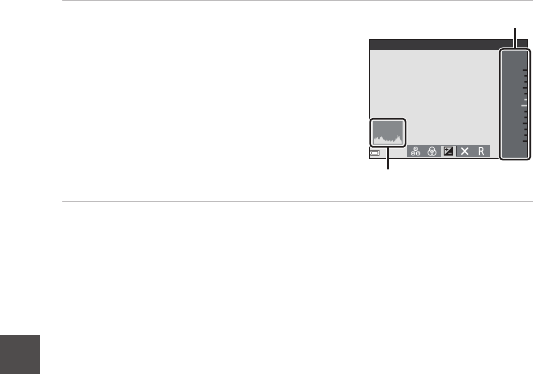
42
Shooting Features
3Use HI to adjust the level.
•You can preview the results on the monitor.
•To set another item, return to step 2.
•Select f Exit to hide the slider.
•To cancel all settings, select P Reset and
press the k button. Return to step 2 and
adjust the settings again.
4Press the k button when setting is complete.
•The settings are applied and the camera returns to the shooting screen.
CCreative Slider Settings
•This function may not be available to use in combination with other functions
(A55).
•The settings for brightness (exposure compensation), vividness and hue are saved
in the camera’s memory even after the camera is turned off.
•See “Using the Histogram” (A47) for more information.
Br igh tne ss (E xp. + /-)
+ 2 . 0
+ 0 . 3
- 2 . 0
Slider
Histogram
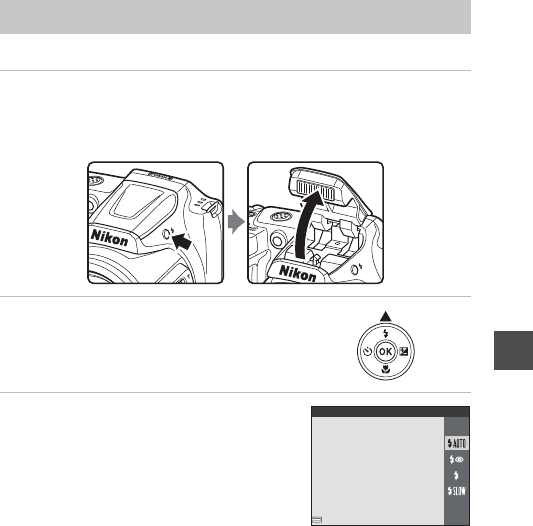
43
Shooting Features
You can select a flash mode to match the shooting conditions.
1Press the m (flash pop-up) button.
•The flash pops up.
•The flash does not fire while it is lowered. W is displayed to indicate that the
flash does not fire.
2Press the multi selector H (X).
3Select the desired flash mode
(A44) and press the k button.
•If the setting is not applied by pressing the
k button within a few seconds, the
selection will be canceled.
BLowering the Flash
Push the flash down gently to lower the flash until it clicks into place when not in use
(A11).
Flash Mode
Au to
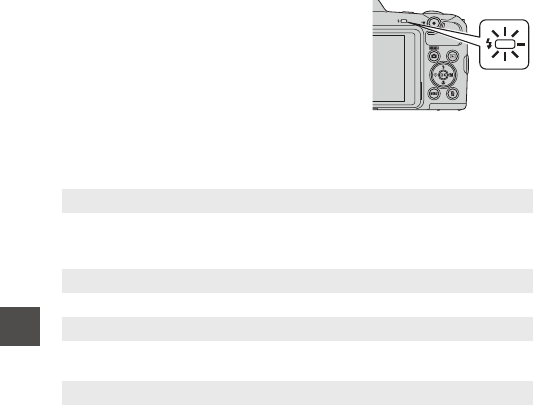
44
Shooting Features
CThe Flash Lamp
•The status of the flash can be confirmed by
pressing the shutter-release button halfway.
- On: The flash fires when you press the shutter-
release button all the way down.
- Flashing: The flash is charging. The camera
cannot shoot images.
- Off: The flash does not fire when a picture is taken.
•If the battery level is low, the monitor turns off
while the flash is charging.
Available Flash Modes
CThe Flash Mode Setting
•The setting may not be available with some shooting modes (A48).
•The setting applied in A (auto) mode is saved in the camera’s memory even after
the camera is turned off.
CRed-eye Reduction
If the camera detects red eye while saving an image, the affected area is processed to
reduce red-eye before the image is saved.
Note the following when shooting:
•More time than usual is required to save images.
•Red-eye reduction may not produce the desired results in some situations.
•In rare cases, red-eye reduction may be applied unnecessarily to other areas of the
image. In these cases, select another flash mode and take the picture again.
UAuto
The flash fires when necessary, such as in dim lighting.
•The flash mode icon on the shooting screen is displayed only
immediately after the setting is made.
VAuto with red-eye reduction
Reduce “red-eye” in portraits caused by the flash.
XFill flash
The flash fires whenever a picture is taken. Use to “fill-in” (illuminate)
shadows and backlit subjects.
YSlow sync
Suited to evening and night portraits that include background scenery.
The flash fires when necessary to illuminate the main subject; slow
shutter speeds are used to capture background at night or under dim
lighting.
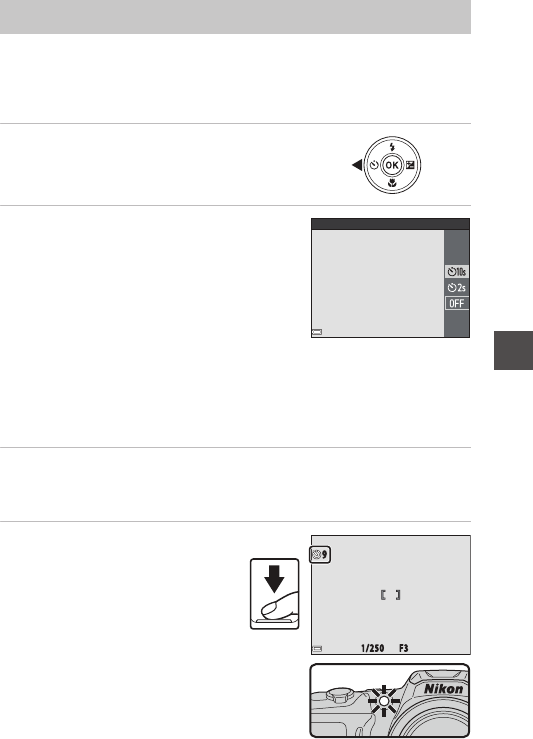
45
Shooting Features
The camera is equipped with a self-timer that releases the shutter 10 seconds
or 2 seconds after you press the shutter-release button.
Set Photo VR (A112) to Off in the setup menu when using a tripod to
stabilize the camera during shooting.
1Press the multi selector J (n).
2Select n10s or n2s, and press
the kbutton.
•n10s (10 seconds): Use on important
occasions, such as weddings.
•n2s (2 seconds): Use to prevent camera
shake.
•If the setting is not applied by pressing the
k button within a few seconds, the
selection will be canceled.
•When the shooting mode is Pet portrait scene mode, Y(pet portrait auto
release) is displayed (A28). The self-timer cannot be used.
•When the shooting mode is set to smart portrait mode, a Smile timer
(A36) and n Self-Collage (A37) are also available besides self-timer.
3Frame the picture and press the shutter-release button
halfway.
•Focus and exposure are set.
4Press the shutter-release
button the rest of the way
down.
•Countdown starts. The self-timer
lamp flashes and then glows
steadily about one second before
the shutter is released.
•When the shutter is released, the
self-timer is set to OFF.
•To stop the countdown, press
the shutter-release button again.
Self-timer
Se lf- tim er
F 31 / 2 5 0
9
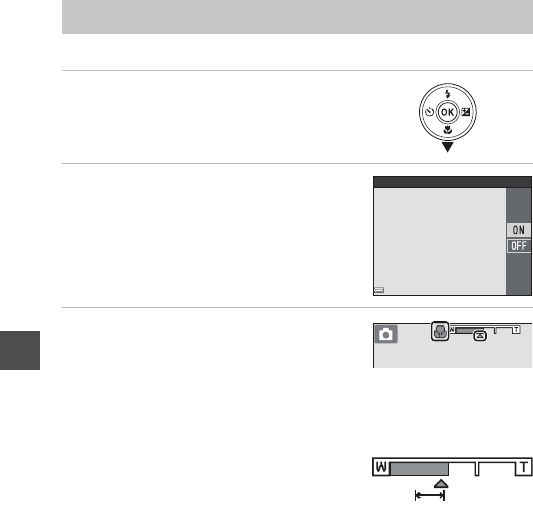
46
Shooting Features
Use macro mode when taking close-up pictures.
1Press the multi selector I (p).
2Select ON and press the
kbutton.
•If the setting is not applied by pressing the
k button within a few seconds, the
selection will be canceled.
3Move the zoom control to set the
zoom ratio to a position where F
and the zoom indicator are
displayed in green.
•When the zoom ratio is set to a position where the zoom indicator is
displayed in green, the camera can focus on subjects as close as
approximately #10# cm (#4# in.) from the lens.
•#When the zoom position is at the wide-
angle and in the area indicated by 1, the
camera can focus on subjects as close as
approximately #1# cm (#0.4# in.) from the
lens.#
BNotes About Using the Flash
The flash may be unable to light the entire subject at distances of less than #50# cm
(#1# ft #8# in.).
CThe Macro Mode Setting
•The setting may not be available with some shooting modes (A48).
•If the setting is applied in A (auto) mode, it will remain saved in the camera’s
memory even after the camera is turned off.
Macro Mode (Taking Close-up Pictures)
Ma cro m ode
1
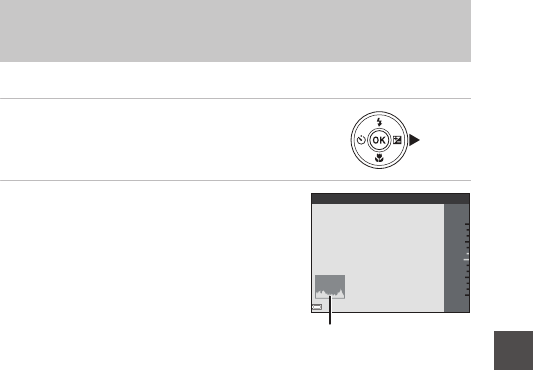
47
Shooting Features
You can adjust overall image brightness.
1Press the multi selector K (o).
2Select a compensation value and
press the k button.
•To brighten the image, set a positive (+)
value.
•To darken the image, set a negative (–)
value.
•The compensation value is applied, even
without pressing the k button.
•When the shooting mode is set to smart
portrait mode, glamour retouches are
displayed (A35).
•When the shooting mode is set to A (auto) mode, the creative slider is
displayed (A41).
CExposure Compensation Value
The setting may not be available with some shooting modes (A48).
CUsing the Histogram
A histogram is a graph showing the distribution of tones in the image. Use as a guide
when using exposure compensation and shooting without the flash.
•The horizontal axis corresponds to pixel brightness, with dark tones to the left and
bright tones to the right. The vertical axis shows the number of pixels.
•Increasing exposure compensation shifts tone distribution to the right, and
decreasing it shifts tone distribution to the left.
Exposure Compensation (Adjusting
Brightness)
Ex pos ure c omp ens ati on
+ 2 . 0
+ 0 . 3
- 2 . 0
Histogram

48
Shooting Features
Default settings for each shooting mode are listed below.
Default Settings (Flash, Self-timer, Etc.)
Flash1
(A43)
Self-timer
(A45)
Macro
(A46)
Exposure
compensation
(A47)
o
(scene auto selector)
U2Off Off30.0
Scene
b (portrait) VOff Off40.0
c (landscape) W4Off Off40.0
d (sports) W4Off4Off40.0
e (night portrait) V4Off Off40.0
f (party/indoor) V5Off Off40.0
Z (beach) UOff Off40.0
z (snow) UOff Off40.0
h (sunset) W4Off Off40.0
i (dusk/dawn) W4Off Off40.0
j (night
landscape) W4Off Off40.0
k (close-up) WOff On40.0
u (food) W4Off On40.0
m (fireworks show) W4Off4Off40.04
o (backlighting) X/W6Off Off40.0
p (easy panorama) W4Off4Off40.0
O (pet portrait) W4Y7Off 0.0
L(moon) W4n 2s Off40.0
l(bird-watching) W4Off Off 0.0
O (
special effects
)WOff Off 0.0
F (smart portrait) U8Off9Off4–10
M (short movie show) W4Off Off 0.0
A (auto) UOff Off –11

49
Shooting Features
1The setting that is used when the flash is raised.
2U (auto) or W (off) can be selected. When U (auto) is selected, the camera
automatically selects the flash mode appropriate for the scene it has selected.
3Cannot be changed. Automatically changes to macro mode when the camera
selects Close-up.
4Cannot be changed. When set to Hand-held, the flash mode setting is fixed at
auto and slow sync with red-eye reduction. When set to Tripod, the flash mode
setting is fixed at fill flash and slow sync with red-eye reduction.
5Slow sync with red-eye reduction flash mode may be used.
6Flash is fixed at X (fill flash) when HDR is set to k. The flash does not fire when
HDR is set to o.
7Self-timer cannot be used. Pet portrait auto release can be turned on or off
(A28).
8Cannot be used when Blink proof is set to On.
9a Smile timer (A36) and n Self-Collage (A37) are also available besides
self-timer.
10 Glamour retouches are displayed (A35).
11 The creative slider is displayed (A41).

50
Shooting Features
The focus area varies depending on the shooting mode.
Using Face Detection
When the following shooting modes or settings
are selected, the camera uses face detection to
automatically focus on human faces.
•o(scene auto selector) mode (A23)
•Portrait or Night portrait scene mode
(A24)
•Smart portrait mode (A35)
•When AF area mode (A84) in A (auto)
mode (A41) is set to Face priority
If the camera detects more than one face, a double border is displayed around
the face that the camera focuses on, and single borders are displayed around
the other faces.
If the shutter button is pressed halfway when no faces are detected:
•In o (scene auto selector) mode, the focus area changes depending on
the scene.
•In Portrait and Night portrait scene modes or in smart portrait mode, the
camera focuses in the center of the frame.
•In A (auto) mode, the camera selects the focus area containing the subject
closest to the camera.
BNotes About Face Detection
•The camera’s ability to detect faces depends on a variety of factors, including the
direction in which the faces are looking.
•The camera cannot detect faces in the following situations:
- When faces are partially hidden by sunglasses or otherwise obstructed
- When faces take up too much or too little of the frame
Focusing
# # # #
25m 0s

51
Shooting Features
Using Skin Softening
When the shutter is released while using one of the shooting modes listed
below, the camera detects human faces and processes the image to soften
facial skin tones (up to three faces).
•Smart portrait mode (A35)
- You can adjust the amount of Skin softening effect in the glamour
retouch.
•o (scene auto selector) mode (A23)
•Portrait or Night portrait in scene mode (A24)
Editing functions such as Skin softening can be applied to saved images by
using Glamour retouch (A65) even after shooting.
BNotes About Skin Softening
•It may take more time than usual to save images after shooting.
•Under some shooting conditions, the desired skin softening results may not be
achieved, and skin softening may be applied to areas of the image where there are
no faces.
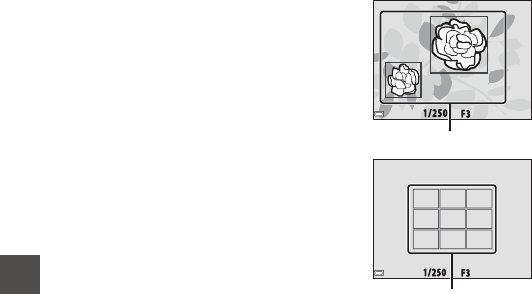
52
Shooting Features
Using Target Finding AF
When AF area mode (A84) in A (auto) mode is set to Target finding AF,
the camera focuses in the manner described below when you press the
shutter-release button halfway:
•The camera detects the main subject and
focuses on it. When the subject is in focus,
the focus area is displayed in green. If a
human face is detected, the camera
automatically sets focus priority on it.
•If no main subject is detected, the camera
automatically selects one or more of the nine
focus areas containing the subject closest to
the camera. When the subject is in focus, the
focus areas that are in focus are displayed in
green.
BNotes About Target Finding AF
•Depending on shooting conditions, the subject that the camera determines to be
the main subject may vary.
•The main subject may not be detected when using certain White balance
settings.
•The camera may not detect the main subject appropriately in the following
situations:
- When the subject is very dark or bright
- When the main subject lacks clearly defined colors
- When the shot is framed so that the main subject is at the edge of the monitor
- When the main subject is composed of a repeating pattern
1/250
F 3
Focus areas
F 3
1 / 2 5 0
Focus areas

53
Shooting Features
Subjects Not Suitable for Autofocus
The camera may not focus as expected in the following situations. In rare cases,
the subject may not be in focus despite the fact that the focus area or the focus
indicator is displayed in green:
•Subject is very dark
•Objects of sharply differing brightness are included in the scene (e.g. the sun
behind the subject makes that subject appear very dark)
•No contrast between the subject and surroundings (e.g. a portrait subject
wearing a white shirt is standing in front of a white wall)
•Several objects are at different distances from the camera (e.g. the subject is
inside a cage)
•Subjects with repeating patterns (window blinds, buildings with multiple
rows of similarly shaped windows, etc.)
•Subject is moving rapidly
In the situations noted above, try pressing the shutter-release button halfway
to refocus several times, or focus on another subject positioned at the same
distance from the camera as the actual desired subject, and use focus lock
(A54).
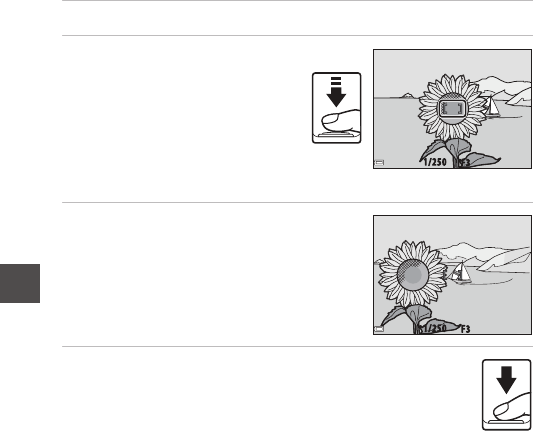
54
Shooting Features
Focus Lock
Focus lock shooting is recommended when the camera does not activate the
focus area that contains the desired subject.
1Set AF area mode to Center in A (auto) mode (A84).
2Position the subject in the
center of the frame and
press the shutter-release
button halfway.
•The camera focuses on the
subject and the focus area is
displayed in green.
•Exposure is also locked.
3Without lifting your finger,
recompose the picture.
•Make sure to maintain the same distance
between the camera and the subject.
4Press the shutter-release button
the rest of the way down to take
the picture.
F 3
1 / 2 5 0
F 3
1 / 2 5 0

55
Shooting Features
Some functions cannot be used with other menu options.
Functions That Cannot Be Used
Simultaneously When Shooting
Restricted
function Option Description
Flash mode
Continuous (A81) When a setting other than Single is
selected, the flash cannot be used.
Blink proof (A89) When Blink proof is set to On, the
flash cannot be used.
Self-timer AF area mode
(A84)
When Subject tracking is selected,
the self-timer cannot be used.
Macro mode AF area mode
(A84)
When Subject tracking is selected,
macro mode cannot be used.
Image mode Continuous (A81)
Image mode is set as follows
depending on the continuous
shooting setting:
•Pre-shooting cache: q (image
size: 1600 × 1200 pixels)
•Continuous H: 120 fps: O (image
size: 640 × 480 pixels)
•Continuous H: 60 fps: M (image
size: 1280 × 960 pixels)
White balance
Hue (using the
creative slider)
(A41)
When hue is adjusted using the
creative slider, White balance in the
shooting menu cannot be set. To set
White balance, select P in the
creative slider setting screen to reset
the brightness, vividness, and hue.
Continuous Self-timer (A45)
If the self-timer is used when Pre-
shooting cache is selected, the
setting is fixed at Single.
ISO sensitivity Continuous (A81)
When Pre-shooting cache,
Continuous H: 120 fps, or
Continuous H: 60 fps is selected, ISO
sensitivity is fixed at Auto.
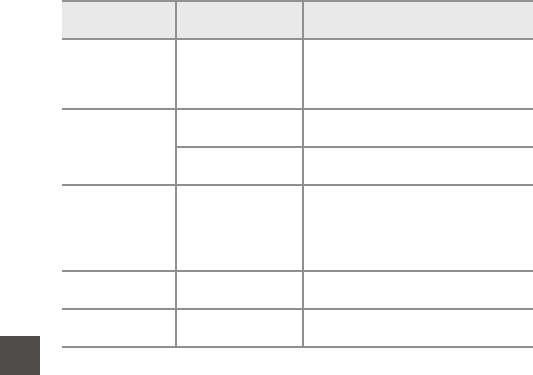
56
Shooting Features
BNotes About Digital Zoom
•Depending on the shooting mode or the current settings, digital zoom may not be
available (A113).
•When digital zoom is in effect, the camera focuses in the center of the frame.
AF area mode White balance
(A79)
When a setting other than Auto is
selected for White balance in Target
finding AF mode, the camera does
not detect the main subject.
Blink proof
Smile timer (A36) When Smile timer is selected, Blink
proof is disabled.
Self-Collage (A37) When Self-Collage is selected, Blink
proof is disabled.
Date stamp Continuous (A81)
When Pre-shooting cache,
Continuous H: 120 fps, or
Continuous H: 60 fps is selected,
date and time cannot be stamped on
images.
Digital zoom AF area mode
(A84)
When Subject tracking is selected,
digital zoom cannot be used.
Shutter sound Continuous (A81) When a setting other than Single is
selected, the shutter sound is disabled.
Restricted
function Option Description
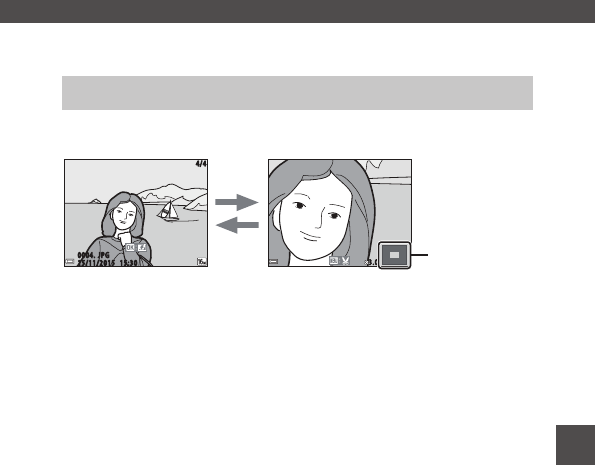
57
Playback Features
Playback Features
Moving the zoom control toward g (i playback zoom) in full-frame playback
mode (A17) zooms in on the image.
•You can change the magnification rate by moving the zoom control toward
f (h) or g (i).
•To view a different area of the image, press the multi selector HIJK.
•When a zoomed image is displayed, press the k button to return to full-
frame playback mode.
CCropping Images
When a zoomed image is displayed, you can press the d button to crop the image
to include only the visible portion and save it as a separate file (A67).
Playback Zoom
4 / 4
15/11/2015 15:30
0 00 4. J P G 3.0
g
(i)
f
(h)
Image is zoomed in.Full-frame Playback
Displayed area
guide
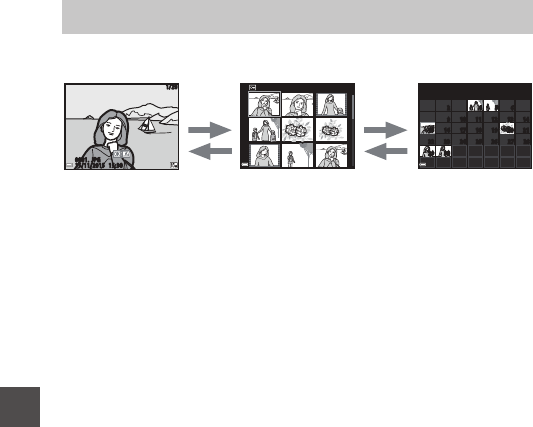
58
Playback Features
Moving the zoom control toward f (h thumbnail playback) in full-frame
playback mode (A17) displays images as thumbnails.
•You can change the number of thumbnails displayed by moving the zoom
control toward f(h) or g (i).
•While using thumbnail playback mode, press the multi selector HIJK to
select an image and then press the k button to display that image in full-
frame playback mode.
•While using calendar display mode, press HIJK to select a date and
then press the kbutton to display the images captured on that day.
BNotes About Calendar Display
Images captured when the camera’s date is not set are treated as images captured
on January 1, 2015.
Thumbnail Playback/Calendar Display
1 / 2 0
1 5/ 11 /2 01 5 1 5 : 3 0
0 00 1. J PG
1 / 2 0
S u n M o n Tu e W e d Th u F r i S a t
2 0 1 5
11
1
3 0
3 02 92 9
2 8
2 82 72 72 62 62 52 52 42 4232 32 22 2
2 1
2 12 02 01 91 91 81 81 71 71 61 61 51 5
1 4
1 41 31 31 21 21 11 1
1 0
1 099
8
8
7
7665544
3
322
1
1
Thumbnail
Playback
Full-frame
Playback
Calendar Display
g
(i)
f
(h)
g
(i)
f
(h)
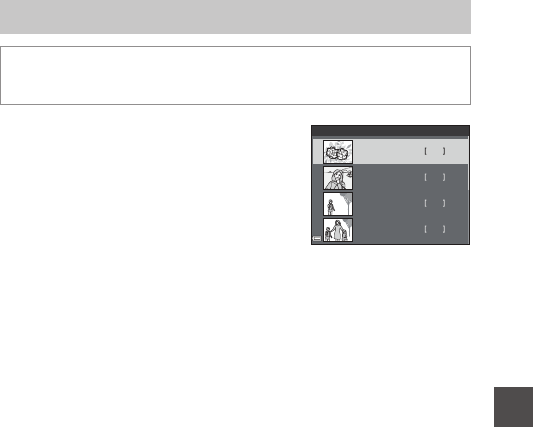
59
Playback Features
Use the multi selector HI to select a date and
then press the k button to play back the
images captured on the selected date.
•Functions in the playback menu (A92) can
be used for the images in the selected
shooting date (except Copy).
•The following operations are available while
the shooting date selection screen is
displayed.
-d button: The functions listed below are available.
•Slide show
•Protect*
* The same settings can be applied to all images captured on the selected
date.
-l button: Deletes all images captured on the selected date.
BNotes About List by Date Mode
•Up to the most recent 29 dates can be selected. If images exist for more than 29
dates, all images saved earlier than the most recent 29 dates will be combined
under Others.
•The 9,000 most recent images can be displayed.
•Images captured when the camera’s date is not set are treated as images captured
on January 1, 2015.
List by Date Mode
Press the c button (playback mode) M c button M C List by date M
k button
Li st by da te
20/11/2015
15/11/2015
3
1
2
1 0
05/11/2015
04/11/2015
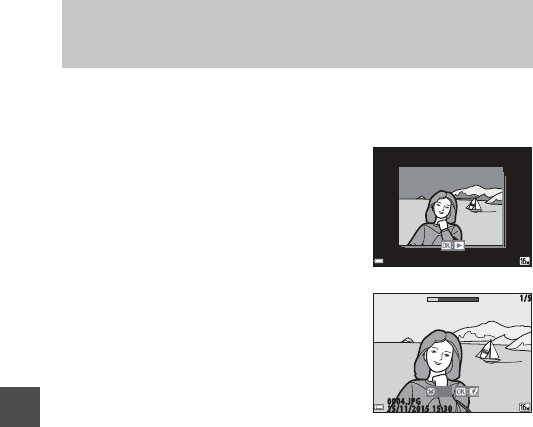
60
Playback Features
Viewing Images in a Sequence
Images captured continuously or with the self-collage function are saved as a
sequence.
The first image of a sequence is used as the key
picture to represent the sequence when
displayed in full-frame playback mode or
thumbnail playback mode. For the self-collage
function, a collage image is used as the key
picture.
To display each image in the sequence
individually, press the k button.
After pressing the k button, the operations
listed below are available.
•To display the previous or next image, press
the multi selector JK.
•To display images that are not included in the
sequence, press H to return to the key
picture display.
•To display images in a sequence as
thumbnails, or to play them back in a slide
show, set Sequence display options to Individual pictures in the
playback menu (A96).
BSequence Display Options
Images captured continuously with cameras other than this camera cannot be
displayed as a sequence.
CPlayback Menu Options Available When Using Sequence
•When images in a sequence are displayed in full-frame playback mode, press the
d button to select functions in playback menu (A92).
•If you press the d button when a key picture is displayed, the following settings
can be applied to all images in the sequence:
- Mark for Wi-Fi upload, Protect, Copy
Viewing and Deleting Images Captured
Continuously (Sequence)
1 / 5
15/11/2015 15:30
0 0 0 4 . J P G
1 / 5
15/11/2015 15:30
0004.JPG
BackBack

61
Playback Features
Deleting Images in a Sequence
When the l (delete) button is pressed for images in a sequence, the images
that are deleted vary depending on how the sequences are displayed.
•When the key picture is displayed:
-Current image: All images in the displayed sequence are
deleted.
-Erase selected images: When a key picture is selected on the erase
selected images screen (A19), all images in
that sequence are deleted.
-All images: All images on the memory card or in the
internal memory are deleted.
•When images in a sequence are displayed in full-frame playback mode:
-Current image: The image currently displayed is deleted.
-Erase selected images: Images that are selected in the sequence are
deleted.
-Entire sequence: All images in the displayed sequence are
deleted.

62
Playback Features
Before Editing Images
You can easily edit images on this camera. Edited copies are saved as separate files.
Edited copies are saved with the same shooting date and time as the original.
CRestrictions on Image Editing
•An image can be edited up to 10 times. Still images created by editing movies can
be edited up to nine times.
•You may not be able to edit images of a certain size or with certain editing functions.
Quick Effects: Changing Hue or Mood
Process images with a variety of effects.
You can select Painting, Photo illustration, Soft portrait, Background
monochrome portrait, Fisheye, Cross screen, or Miniature effect.
1Display the image to which you
want to apply an effect in full-
frame playback mode and press
the k button.
2Use the multi selector HIJK to
select the desired effect and press
the k button.
•Move the zoom control (A1) toward g(i)
to switch to full-frame playback or f(h)
to switch to thumbnail playback.
•To exit without saving the edited image,
press the d button.
3Select Yes and press the k button.
•An edited copy is created.
Editing Images (Still Images)
15/11/2015 15:30
0004. JPG
Qu ick e ec ts
Ph ot o
illustration
Pai nti ng So ft por tra it
P or t r a i t
(c ol or + B &W ) Fis hey e C ro ss scr ee n
Ca nc el
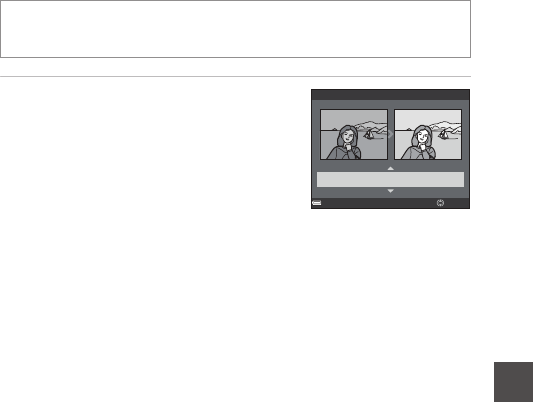
63
Playback Features
Quick Retouch: Enhancing Contrast and Saturation
Use the multi selector HI to select
the amount of effect applied and press
the kbutton.
•The edited version is displayed on the right.
•To exit without saving the copy, press J.
Press the c button (playback mode) M select an image M d button
M Quick retouch M k button
Qu ick re to uc h
No rm al
Am oun t

64
Playback Features
D-Lighting: Enhancing Brightness and Contrast
Use the multi selector HI to select
OK and press the k button.
•The edited version is displayed on the right.
•To exit without saving the copy, select Cancel
and press the kbutton.
Red-eye Correction: Correcting Red-eye When
Shooting with the Flash
Preview the result and press the
kbutton.
•To exit without saving the copy, press the multi
selector J.
BNotes About Red-eye Correction
•Red-eye correction can only be applied to images when red-eye is detected.
•Red-eye correction can be applied to pets (dogs or cats) even if their eyes are not
red.
•Red-eye correction may not produce the desired results in some images.
•In rare cases, red-eye correction may be applied unnecessarily to other areas of the
image.
Press the c button (playback mode) M select an image M d button
M D-Lighting M k button
Press the c button (playback mode) M select an image M d button
M Red-eye correction M k button
D- Lig hti ng
OK
Ca ncel
Ba ck Sa ve
Pre vie w

65
Playback Features
Glamour Retouch: Enhancing Human Faces
1Use the multi selector HIJK to
select the face that you want to
retouch and press the k button.
•When only one face is detected, proceed to
step 2.
2Use JK to select the effect, use
HI to select the effect level, and
press the k button.
•You can simultaneously apply multiple
effects.
Adjust or check the settings for all effects
before pressing the k button.
F Small face, B Skin softening,
lFoundation makeup, m Glare reduction, E Hide eye bags, A Big
eyes, G Whiten eyes, n Eye shadow, o Mascara, H Whiten teeth,
p Lipstick, D Redden cheeks
•Press the d button to return to the screen for selecting a person.
3Preview the result and press the
k button.
•To change the settings, press J to return to
step 2.
•To exit without saving the edited image,
press the d button.
4Select Yes and press the
kbutton.
•An edited copy is created.
Press the c button (playback mode) M select an image M d button
M Glamour retouch M k button
Su bje ct sel ect ion
Ba ck
Sm all fa ce
Ba ck
Pre vie w
Sa ve
Ye s
No
Sa ve OK ?
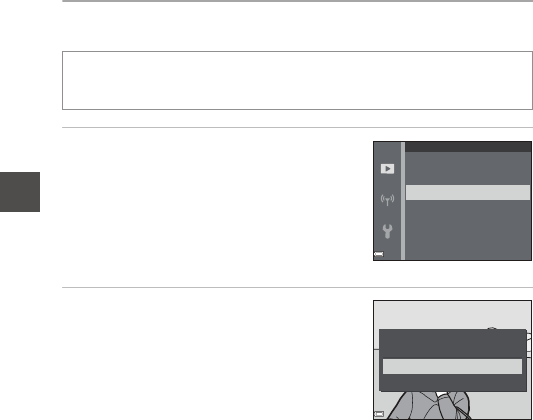
66
Playback Features
BNotes About Glamour Retouch
•One face can be edited at a time. To apply glamour retouch to another face, edit
the edited image again.
•Depending on the direction in which faces are looking, or the brightness of faces,
the camera may be unable to accurately detect faces, or the glamour retouch
function may not perform as expected.
•If no faces are detected, a warning is displayed and the screen returns to the
playback menu.
•The glamour retouch function is available only for images captured at an ISO
sensitivity of 1600 or lower, and the image size of 640 × 480 or larger.
Small Picture: Reducing the Size of an Image
1Use the multi selector HI to
select the desired copy size and
press the kbutton.
•For images captured at an image mode
setting of l 4608×2592, only 640×360
is displayed, and for those of
s3456×3456, only 480×480 is
displayed.
2Select Yes and press the
kbutton.
•An edited copy is created (compression
ratio of approximately 1:8).
Press the c button (playback mode) M select an image M d button
M Small picture M k button
Small picture
640
×
48 0
32 0
×
24 0
16 0
×
12 0
Ye s
No
Cr ea te sm all p ic ture le ?
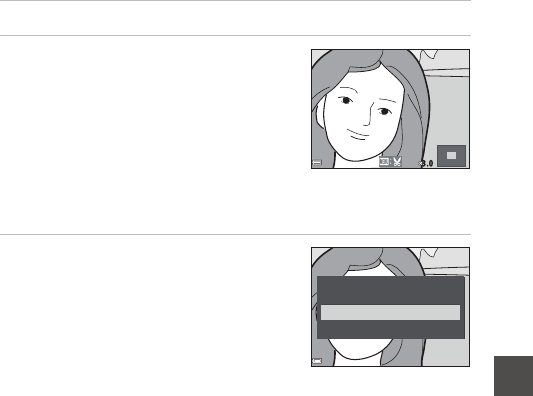
67
Playback Features
Crop: Creating a Cropped Copy
1Move the zoom control to enlarge the image (A57).
2Adjust the image so that only the
portion that you want to keep is
displayed, and then press the d
(menu) button.
•Move the zoom control toward g (i) or
f(h) to adjust the magnification rate.
Set a magnification rate at which u is
displayed.
•Use the multi selector HIJK to scroll to the portion of the image that you
want to display.
3Select Yes and press the
kbutton.
•An edited copy is created.
CImage Size
•The aspect ratio (horizontal to vertical) after cropping is the same as the original
image.
•When the image size of the cropped copy is 320 × 240 or smaller, the image is
displayed at a smaller size during playback.
3 . 0
Ye s
No
Sa ve th is imag e as
di sp lay ed ?
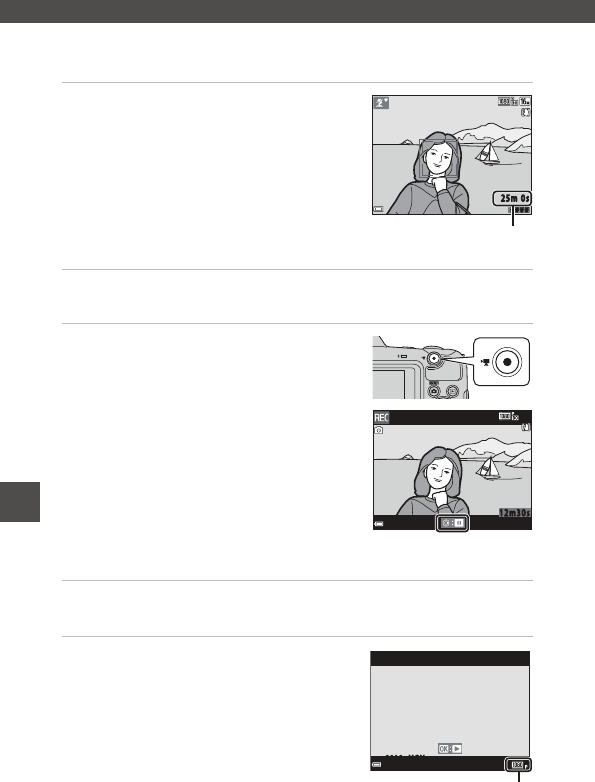
68
Recording and Playing Back Movies
Recording and Playing Back Movies
1Display the shooting screen.
•Check the remaining amount of movie
recording time.
2Lower the flash (A11).
•Recording movies while the flash is raised may cause the audio to be muffled.
3Press the b (e movie-record)
button to start movie recording.
•
The camera focuses in the center of the frame.
•Press the multi selector K to pause
recording, and press K again to resume
recording (except when an HS movie
option is selected in Movie options).
Recording automatically ends if it remains
paused for about five minutes.
•You can capture a still image by pressing the shutter-release button while
recording a movie (A71).
4Press the b (e movie-record) button again to end
recording.
5Select a movie in full-frame
playback mode and press the
kbutton to play it back.
•An image with a movie options icon is a
movie.
# # # #
25m 0s
Remaining movie
recording time
1 2 m 3 0 s
15/11/2015 15:30
0010. MOV
1 0 s
Movie options

69
Recording and Playing Back Movies
Area Captured in Movies
•The area that is captured in a movie varies depending on the Movie
options settings in the movie menu.
•If Photo info in Monitor settings (A109) in the setup menu is set to
Movie frame+auto info, you can confirm the area that will be captured in
a movie before you start recording.
Maximum Movie Recording Time
Individual movie files cannot exceed 4 GB in size or 29 minutes in length, even
when there is sufficient free space on the memory card for longer recording.
•The remaining recording time for a single movie is displayed on the
shooting screen.
•The actual remaining recording time may vary depending on the movie
content, subject movement, or type of memory card.
•Memory cards with an SD Speed Class rating of 6 or faster are
recommended when recording movies (A152). Movie recording may stop
unexpectedly when memory cards with a lower Speed Class rating are used.
BNotes About Camera Temperature
•The camera may become hot when shooting movies for an extended period of
time or when the camera is used in a hot area.
•If the inside of the camera becomes extremely hot when recording movies, the
camera will automatically stop recording.
The amount of time remaining until the camera stops recording (B10s) is
displayed.
After the camera stops recording, it turns itself off.
Leave the camera off until the inside of the camera has cooled.

70
Recording and Playing Back Movies
Notes About Movie Recording
BNotes About Saving Images or Movies
The indicator showing the number of exposures remaining or the indicator showing
the remaining recording time flashes while images or movies are being saved. Do
not open the battery-chamber/memory card slot cover or remove the
batteries or memory card while an indicator is flashing. Doing this could result in
loss of data, or in damage to the camera or the memory card.
BNotes About Recorded Movies
•When using the camera’s internal memory, saving movies may take some time.
•There may be some degradation in image quality when digital zoom is used.
•The sounds of zoom control operation, zoom, autofocus lens drive movement,
vibration reduction, and aperture operation when brightness changes may be
recorded.
•The following phenomena may be seen in the monitor while recording movies.
These phenomena are saved in the recorded movies.
- Banding may occur in images under fluorescent, mercury-vapor, or sodium-
vapor lighting.
- Subjects that move quickly from one side of the frame to the other, such as a
moving train or car, may appear skewed.
- The entire movie image may be skewed when the camera is panned.
- Lighting or other bright areas may leave residual images when the camera is
moved.
•Depending on the distance to the subject or the amount of zoom applied, colored
stripes may appear on subjects with repeating patterns (fabrics, lattice windows, etc.)
during movie recording and playback. This occurs when the pattern in the subject
and the layout of the image sensor interfere with each other; it is not a malfunction.
BNotes About Vibration Reduction During Movie Recording
•When Movie VR (A103) in the movie menu is set to On (hybrid), the angle of
view (i.e., the area visible in the frame) becomes narrower during movie recording.
•When using a tripod to stabilize the camera during shooting, set Movie VR to Off
to prevent potential errors caused by this function.
BNotes About Autofocus for Movie Recording
Autofocus may not perform as expected (A53). Should this occur, try the following:
1. Set Autofocus mode in the movie menu to Single AF (default setting) before
starting movie recording.
2. Frame another subject (positioned at the same distance from the camera as the
intended subject) in the center of the frame, press the b (e movie-record)
button to start recording, and modify the composition.
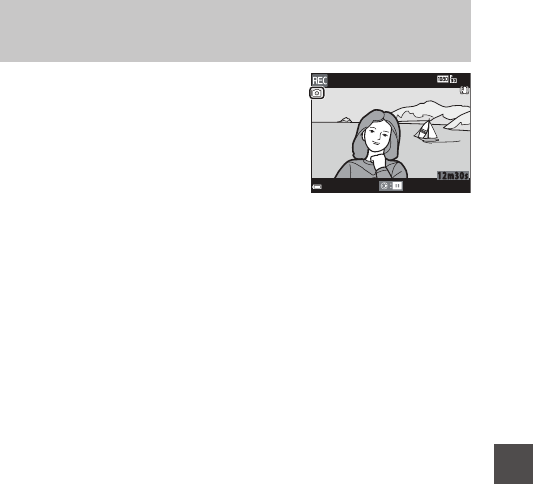
71
Recording and Playing Back Movies
If the shutter-release button is pressed all the
way while recording a movie, one frame is saved
as a still image. Movie recording continues while
the still image is being saved.
•While y is displayed in the monitor, still
images can be captured. While z is
displayed, still images cannot be captured.
•The size of the captured image varies
depending on the Movie options setting
(A98).
BNotes About Capturing Still Images During Movie Recording
•Still images cannot be captured during a movie recording in the following
situations:
- When the remaining movie recording time is less than five seconds
- When Movie options is set to Z 1080/60i, U 1080/50i, g 480/30p,
W480/25p, or HS movie
•The sound of pressing the shutter-release button may be recorded in the movie.
•If the camera moves when the shutter-release button is pressed, the image may be
blurred.
Capturing Still Images While Recording
Movies
1 2 m 3 0 s
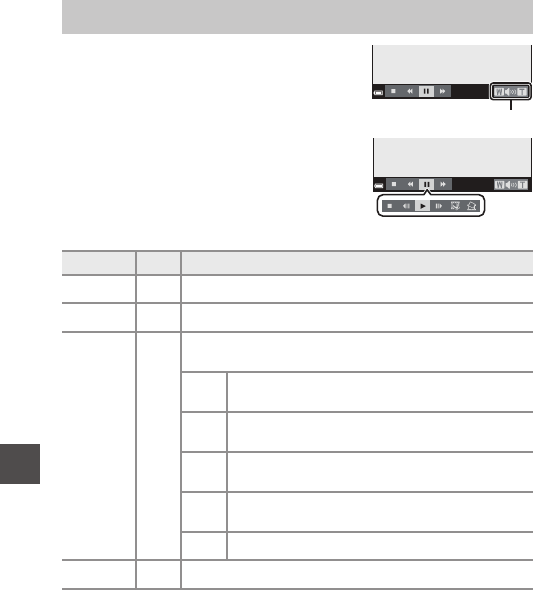
72
Recording and Playing Back Movies
To adjust the volume, move the zoom control
while a movie is playing (A1).
Playback controls are displayed in the monitor.
The operations described below can be
performed by using the multi selector JK to
select a control and then pressing the
kbutton.
Operations During Movie Playback
Function Icon Description
Rewind AHold down the k button to rewind the movie.
Advance BHold down the k button to advance the movie.
Pause E
Pause playback. The operations listed below can be
performed while paused.
CRewind the movie one frame. Hold down the
kbutton for continuous rewinding.
DAdvance the movie one frame. Hold down the
kbutton for continuous advancing.
IExtract the desired portion of a movie and save it as a
separate file.
HOne frame from a recorded movie can be extracted
and saved as a still image.
FResume playback.
End GReturn to full-frame playback mode.
Volume indicator
When paused
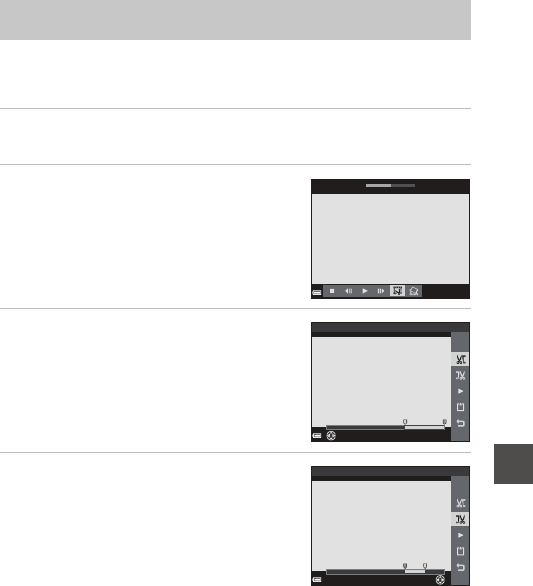
73
Recording and Playing Back Movies
Extracting Only the Desired Portions of a Movie
The desired portion of a recorded movie can be saved as a separate file.
1Play back a movie and pause at the start point of the
portion that you want to extract (A72).
2Use the multi selector JK to
select I in the playback controls,
and then press the k button.
3Use HI to select M (choose start
point) in the editing controls.
•Use JK to move the start point.
•To cancel editing, select O (return), and
press the kbutton.
4Use HI to select N (choose end
point).
•Use JK to move the end point.
•To preview the specified portion, select G
and then press the k button. Press the
kbutton again to stop previewing.
Editing Movies
1 m 3 0 s
Ch oos e s ta rt po int
1 m 0 s
Ch oos e e nd po int
3 0 s
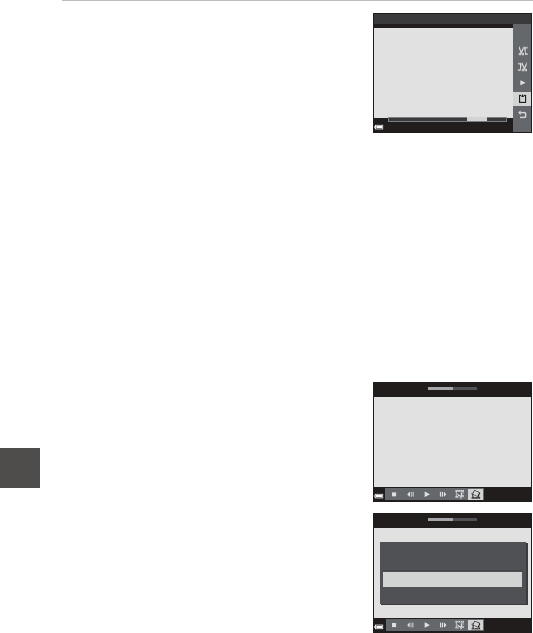
74
Recording and Playing Back Movies
5Use HI to select m (save) and
press the kbutton.
•Follow the instructions on the screen to
save the movie.
BNotes About Movie Editing
•Use batteries with a sufficient amount of charge remaining to prevent the camera
from turning off during editing. When the battery level indicator is B, movie
editing is not possible.
•A movie that was created by editing cannot be trimmed again.
•The actual trimmed portion of a movie may differ slightly from the portion selected
using the start and end points.
•Movies cannot be trimmed so that they are less than two seconds long.
Saving a Frame from a Movie as a Still Image
A frame from a recorded movie can be extracted and saved as a still image.
•Pause movie playback so that the frame to be
extracted is displayed (A72).
•Use the multi selector JK to select H in
the playback controls, and then press the
kbutton.
•When the confirmation dialog is displayed,
select Yes and press the k button to save.
•The image quality of the still images to be
saved is normal (compression ratio of
approximately 1:8). The size of the image
varies depending on the type (image size;
A98) of the original movie.
For example, a still image saved from a movie
recorded with e 1080/30p or
S1080/25p is n (1920 × 1080 pixels).
BNotes About Saving Still Images
Still images cannot be saved from movies recorded at Z 1080/60i, U 1080/
50i, or HS movie (A98).
Sa ve
3 0 s
1m30s
Ye s
No
1 m 3 0 s
Co py th is fr am e as a still i mage?
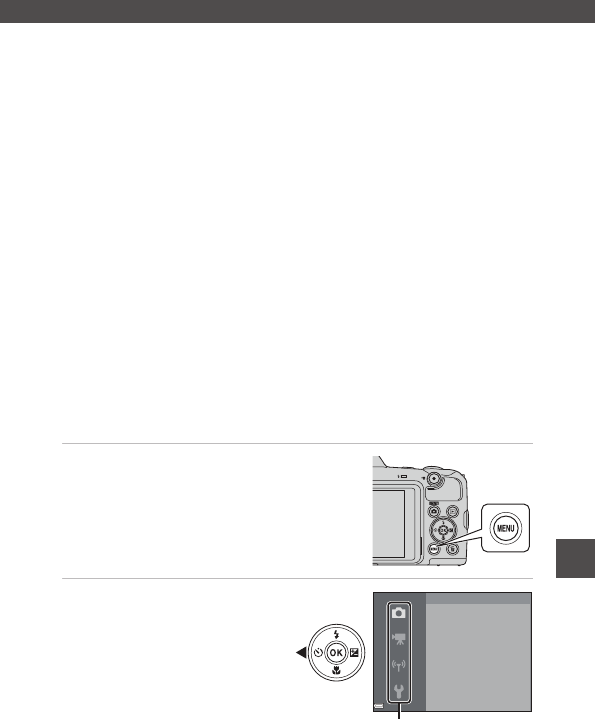
75
Using Menus
Using Menus
You can set the menus listed below by pressing the d (menu) button.
•A Shooting menu
Available by pressing the d button when the shooting screen is
displayed.
Allows you to change image size and quality, continuous shooting settings,
etc.
•G Playback menu
Available by pressing the d button when viewing images in full-frame
playback mode or thumbnail playback mode.
Allows you to edit images, play slide shows, etc.
•D Movie menu
Available by pressing the d button when the shooting screen is
displayed.
Allows you to change movie recording settings.
•J Wi-Fi options menu
Allows you to configure Wi-Fi settings for connecting the camera and a
smart device.
•z Setup menu
Allows you to adjust basic camera functions such as date and time, display
language, etc.
1Press the d (menu) button.
•The menu is displayed.
2Press the multi
selector J.
•The current menu icon is
displayed in yellow.
Imag e mode
Wh it e b al ance
Co ntinu ou s
IS O sensi ti vity
AF a rea m ode
Au tofo cu s mod e
Shooting menu
Menu icons
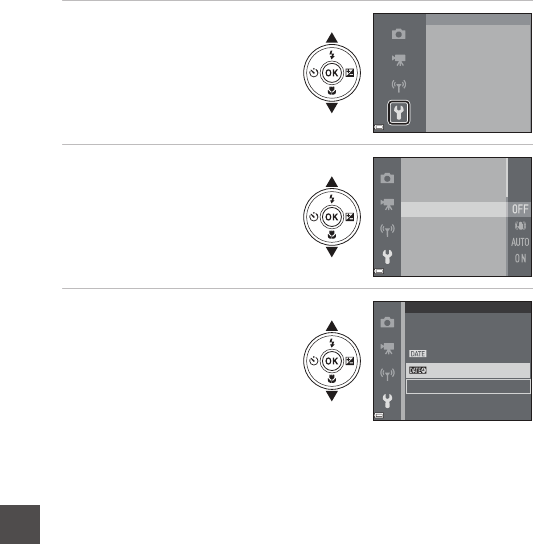
76
Using Menus
3Select a menu icon and
press the k button.
•The menu options become
selectable.
4Select a menu option
and press the k button.
•Certain menu options cannot
be set depending on the
current shooting mode or the
state of the camera.
5Select a setting and
press the k button.
•The setting you selected is
applied.
•When you are finished using
the menu, press the d
button.
•When a menu is displayed, you
can switch to shooting mode by pressing the shutter-release button,
Abutton, or b (e) button.
Di gi tal z oom
AF assist
Ph ot o VR
Da te st am p
Mo ni tor s et tings
Ti me zo ne an d date
Se t u p
Di gi tal z oom
AF assist
Ph ot o VR
Da te st am p
Mo ni tor s et tings
Ti me zo ne an d date
O
Date stamp
Da te an d ti me
Da te
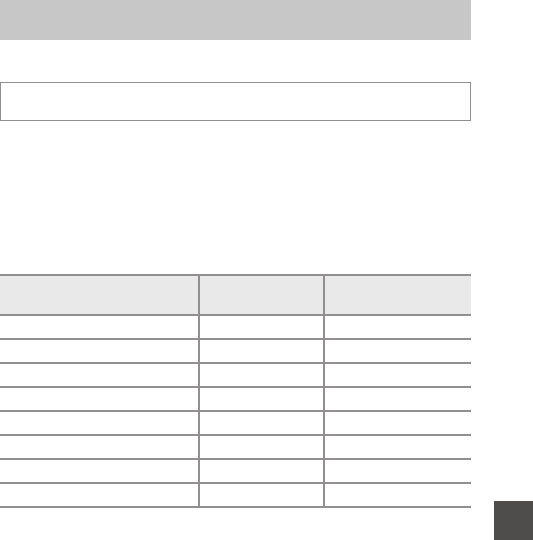
77
Using Menus
Image Mode (Image Size and Quality)
* This setting can also be changed in shooting modes other than auto. The changed
setting is also applied to other shooting modes.
Select the combination of image size and compression ratio to be used when
saving images.
The higher the image mode setting, the larger the size at which it can be
printed, and the lower the compression ratio, the higher the quality of the
images, but the number of images that can be saved is reduced.
* The numerical values indicate the number of pixels that are captured.
Example: P 4608×3456 = approx. 16 megapixels, 4608 × 3456 pixels
The Shooting Menu (for A (Auto) Mode)
Enter shooting mode* M d button M Image mode M k button
Option* Compression ratio Aspect ratio
(horizontal to vertical)
Q 4608×3456PApprox. 1:4 4:3
P 4608×3456 (default setting) Approx. 1:8 4:3
R 3264×2448 Approx. 1:8 4:3
r 2272×1704 Approx. 1:8 4:3
q 1600×1200 Approx. 1:8 4:3
O 640×480 Approx. 1:8 4:3
g 4608×2592 Approx. 1:8 16:9
s 3456×3456 Approx. 1:8 1:1

78
Using Menus
BNotes About Printing Images at 1:1 Aspect Ratio
Change the printer setting to “Border” when printing images at a 1:1 aspect ratio.
Some printers may not be able to print images at a 1:1 aspect ratio.
BNotes About Image Mode
This function may not be available to use in combination with other functions
(A55).
CNumber of Images That Can Be Saved
•The approximate number of images that can be saved can be checked in the
monitor when shooting (A10).
•Note that due to JPEG compression, the number of images that can be saved may
vary greatly depending on the image content, even when using memory cards
with the same capacity and the same image mode setting. In addition, the number
of images that can be saved may vary depending on the make of the memory card.
•If the number of exposures remaining is 10,000 or more, the number of exposures
remaining display shows “9999”.
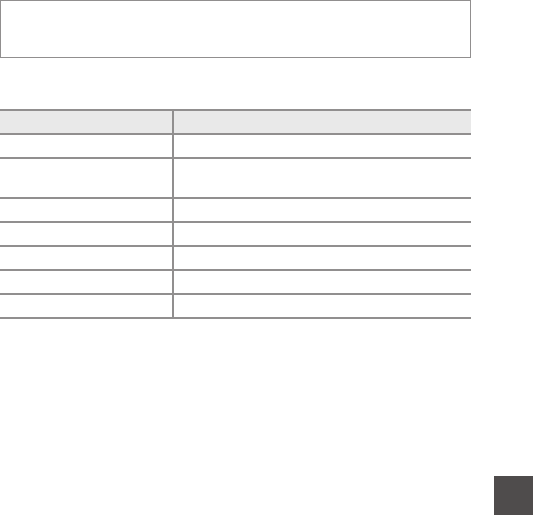
79
Using Menus
White Balance (Adjusting Hue)
Adjust white balance to suit the light source or weather conditions in order to
make the colors in images match what you see with your eyes.
BNotes About White Balance
•Lower the flash when white balance is set to any setting other than Auto and
Flash (A11).
•This function may not be available to use in combination with other functions
(A55).
Enter shooting mode M A (shooting mode) button M A (auto) mode
M k button M d button M White balance M k button
Option Description
aAuto (default setting) White balance is automatically adjusted.
bPreset manual Use when the desired result is not achieved with
Auto, Incandescent, etc. (A80).
cDaylight Use under direct sunlight.
dIncandescent Use under incandescent lighting.
eFluorescent Use under fluorescent lighting.
fCloudy Use under overcast skies.
gFlash Use with the flash.
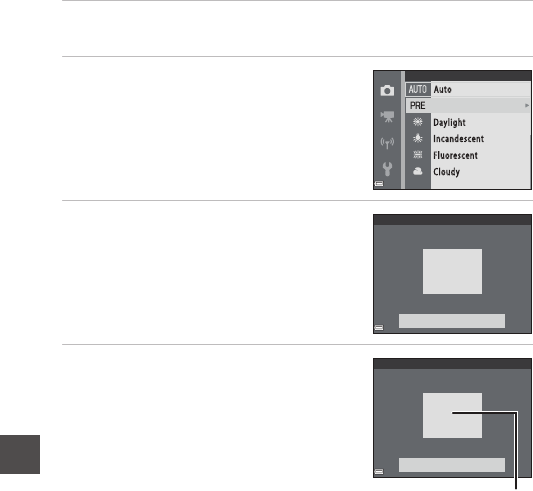
80
Using Menus
Using Preset Manual
Use the procedure below to measure the white balance value under the
lighting used during shooting.
1Place a white or gray reference object under the lighting
that will be used during shooting.
2Use the multi selector HI to
select Preset manual in the
White balance menu, and press
the k button.
•The camera zooms in to the position for
measuring white balance.
3Select Measure.
•To apply the last measured value, select
Cancel and press the k button.
4Frame the white or gray reference
object in the measuring window,
and press the k button to
measure the value.
•The shutter is released and measurement is
complete (no image is saved).
BNotes About Preset Manual
A value for flash lighting cannot be measured with Preset manual. When shooting
using the flash, set White balance to Auto or Flash.
Da yl igh t
Incandescent
Fl uore sc ent
Cloudy
Au to
Pr ese t manua l
White balance
Me as ure
Ca ncel
Pr ese t m anu al
Me as ure
Ca ncel
Pr ese t m anu al
Measuring window

81
Using Menus
Continuous Shooting
Enter shooting mode M A (shooting mode) button M A (auto) mode
M k button M d button M Continuous M k button
Option Description
USingle
(default setting)
One image is captured each time the shutter-release
button is pressed.
k Continuous H
While the shutter-release button is held all the way down,
images are captured continuously.
•The frame rate for continuous shooting is about #9.2#
fps and the maximum number of continuous shots is
about #7# (when image mode is set to P4608×3456).
m Continuous L
While the shutter-release button is held all the way down,
images are captured continuously.
•The frame rate for continuous shooting is about #2.2#
fps and the maximum number of continuous shots is
about #35# (when image mode is set to P
4608×3456).
q Pre-shooting
cache
When the shutter-release button is pressed halfway, pre-
shooting cache shooting begins. When the shutter-release
button is pressed the rest of the way down, the camera
saves the current image as well as the images captured
immediately before the button is pressed (A82). This
function helps you to avoid missing the shot.
•The frame rate for continuous shooting is about #15# fps
and the maximum number of continuous shots is #25#,
including a maximum of #4# frames captured in the pre-
shooting cache.
•Image mode is fixed at q (image size: 1600 × 1200
pixels).
n Continuous H:
120 fps
Each time the shutter-release button is pressed all the way,
images are captured at a high speed rate.
•The frame rate for continuous shooting is about 120 fps
and the maximum number of continuous shots is 50.
•Image mode is fixed at O (image size: 640 × 480 pixels).
j Continuous H:
60 fps
Each time the shutter-release button is pressed all the way,
images are captured at a high speed rate.
•The frame rate for continuous shooting is about 60 fps
and the maximum number of continuous shots is 25.
•Image mode is fixed at M (image size: 1280 × 960 pixels).
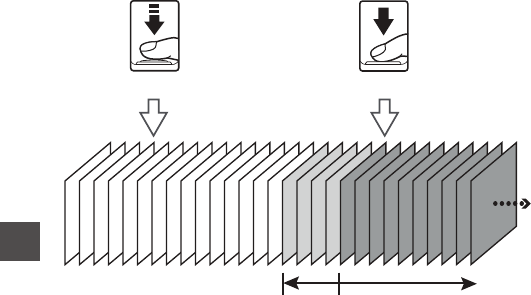
82
Using Menus
BNotes About Continuous Shooting
•Focus, exposure, and white balance are fixed at the values determined with the
first image in each series.
•It may take some time to save the images after shooting.
•When ISO sensitivity increases, noise may appear in captured images.
•The frame rate for continuous shooting may vary depending on the current image
mode setting, the memory card used, or shooting condition.
•When using Pre-shooting cache, Continuous H: 120 fps, or Continuous H: 60
fps, banding or variance in brightness or hue may occur in images that were
captured under lighting that flickers at high speeds, such as fluorescent, mercury-
vapor, or sodium-vapor lighting.
•This function may not be available to use in combination with other functions (A55).
CPre-shooting Cache
When the shutter-release button is pressed halfway or all the way down, images are
saved as described below.
•The pre-shooting cache icon (Q) on the shooting screen changes to green while
the shutter-release button is pressed halfway.
Images saved before pressing all the way Images saved by pressing all
the way
Press down halfway Press down all the way
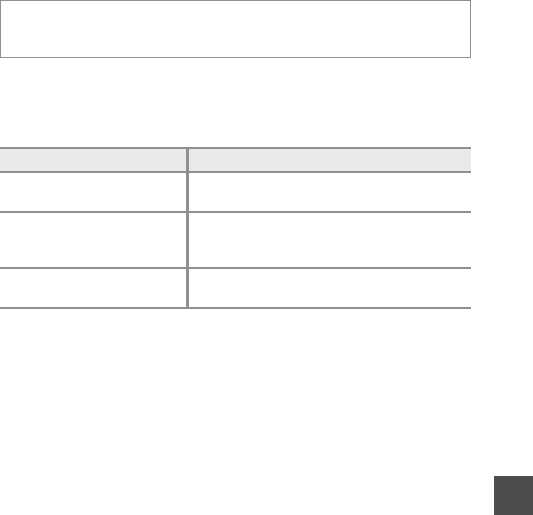
83
Using Menus
ISO Sensitivity
A higher ISO sensitivity allows darker subjects to be captured. Additionally, even
with subjects of similar brightness, pictures can be taken at faster shutter speeds,
and blurring caused by camera shake and subject movement can be reduced.
•When a higher ISO sensitivity is set, images may contain noise.
BNotes About ISO Sensitivity
This function may not be available to use in combination with other functions (A55).
CISO Sensitivity Display on the Shooting Screen
•When Auto is selected, E is displayed when the ISO sensitivity increases.
•
When
Fixed range auto
is selected, the maximum value for ISO sensitivity is displayed.
Enter shooting mode M A (shooting mode) button M A (auto) mode
M k button M d button M ISO sensitivity M k button
Option Description
a Auto
(default setting)
Sensitivity is automatically selected from the
range of ISO 125 to 1600.
I Fixed range auto
Select the range in which the camera
automatically adjusts ISO sensitivity, from ISO
125-400 or ISO 125-800.
125, 200, 400, 800, 1600, 3200,
6400 Sensitivity is locked at the specified value.
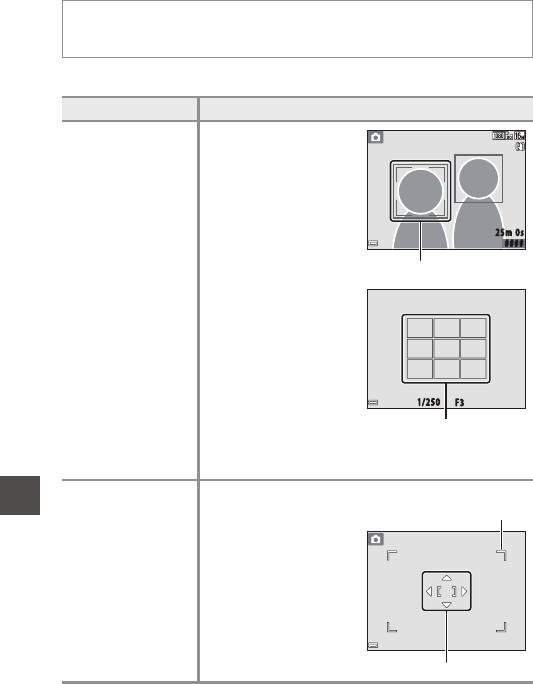
84
Using Menus
AF Area Mode
Set how the camera selects the focus area for autofocus.
Enter shooting mode M A (shooting mode) button M A (auto) mode
M k button M d button M AF area mode M k button
Option Description
a Face priority
When the camera
detects a human face, it
focuses on that face. See
“Using Face Detection”
(A50) for more
information.
When framing a
composition with no
human subjects or
detected faces, the
camera automatically
selects one or more of
the nine focus areas
containing the subject
closest to the camera
when the shutter-release
button is pressed
halfway.
x Manual
Use the multi selector
HIJK to move the
focus area to where you
want to focus.
•To use the multi
selector to configure
the flash mode or
other settings, press
the k button. To
return to moving the
focus area, press the
k button again.
# # # #
25m 0s
Focus area
F 3
1 / 2 5 0
Focus areas
Focus area
Scope of movable
focus area
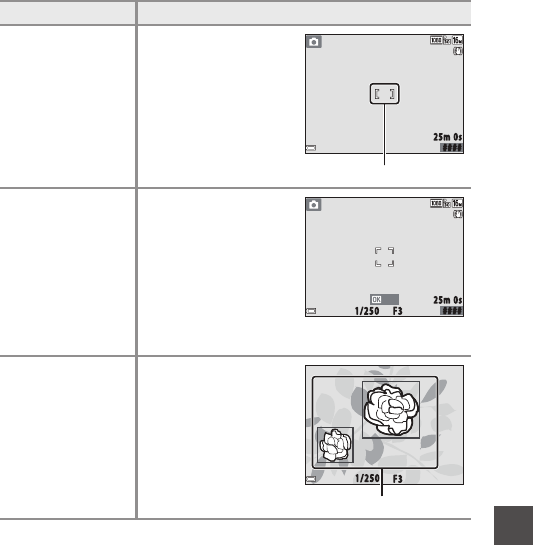
85
Using Menus
BNotes About AF Area Mode
•When digital zoom is in effect, the camera focuses in the center of the frame
regardless of the AF area mode setting.
•This function may not be available to use in combination with other functions
(A55).
y Center
The camera focuses on
the subject in the center
of the frame.
s Subject tracking
Use this function to take
pictures of moving
subjects. Register the
subject on which the
camera focuses. The
focus area automatically
moves to track the
subject.
See “Using Subject
Tracking” (A86) for more information.
M Target finding
AF (default setting)
When the camera
detects the main subject,
it focuses on that
subject.
See “Using Target
Finding AF” (A52).
Option Description
# # # #
2 5 m 0 s
Focus area
S t ar t
# # # #
2 5 m 0 s
1/250
F 3
1/250
F 3
Focus areas
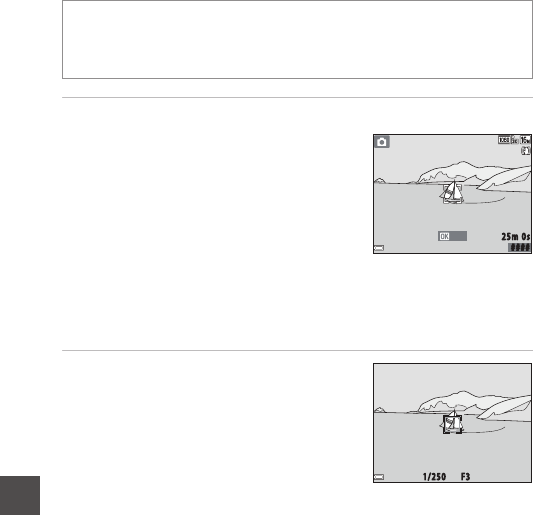
86
Using Menus
Using Subject Tracking
1Register a subject.
•Align the subject that you want to track
with the border in the center of the monitor
and press the k button.
•When the subject is registered, a yellow
border (focus area) is displayed around it
and the camera begins tracking the subject.
•If the subject cannot be registered, the
border is displayed in red.
Change the composition and try registering
the subject again.
•To cancel subject registration, press the k button.
•If the camera can no longer track the registered subject, the focus area
disappears. Register the subject again.
2Press the shutter-release button
fully to take the picture.
•If the shutter-release button is pressed
while the focus area is not displayed, the
camera focuses on the subject in the center
of the frame.
BNotes About Subject Tracking
•If you perform operations such as zooming while the camera is tracking the
subject, the registration is canceled.
•Subject tracking may not be possible in certain shooting conditions.
Enter shooting mode M A (shooting mode) button M A (auto) mode
M k button M d button M AF area mode M k button M s Subject
tracking M k button M d button
25m 0s
# # # #
S t ar t
F 31 / 2 5 0

87
Using Menus
Autofocus Mode
Set how the camera focuses when shooting still images.
CAutofocus Mode for Movie Recording
Autofocus mode for movie recording can be set with Autofocus mode (A102) in
the movie menu.
Enter shooting mode M A (shooting mode) button M A (auto) mode
M k button M d button M Autofocus mode M k button
Option Description
ASingle AF The camera focuses only when the shutter-release
button is pressed halfway.
BFull-time AF
The camera continues focusing even when the
shutter-release button is not pressed halfway. The
sound of lens drive movement is heard while the
camera focuses.
a Pre-focus
(default setting)
Even when the shutter-release button is not pressed
halfway, the camera focuses automatically if the
composition of the framed image is significantly
changed.

88
Using Menus
•See “Image Mode (Image Size and Quality)” (A77) for information about
Image mode.
Self-Collage
The Smart Portrait Menu
Enter shooting mode M A (shooting mode) button M F Smart portrait
mode M k button M d button M Self-Collage M k button
Option Description
Number of shots
Set the number of shots that the camera automatically
captures (number of captured images for an aggregated
image).
•4 (default setting) or 9 can be selected.
Interval
Set the interval time between each shot.
•Short, Medium (default setting), or Long can be
selected.
Shutter sound
Set whether to activate the shutter sound when shooting
with the self-collage function.
•Standard, SLR, Magic (default setting), or Off can be
selected.
•The same setting that is specified for Shutter sound in
Sound settings in the setup menu is not applied to this
setting.

89
Using Menus
Blink Proof
Enter shooting mode M A (shooting mode) button M F Smart portrait
mode M k button M d button M Blink proof M k button
Option Description
y On
The camera automatically
releases the shutter twice with
every shot and saves one
image in which the subject’s
eyes are open.
•If the camera saved an
image in which the subject’s
eyes may have been closed,
the dialog shown on the
right is displayed for a few seconds.
•The flash cannot be used.
Off
(default setting) Turns the blink proof off.
A bl ink w as dete ct ed in t he
pi ct ure j us t tak en .

90
Using Menus
Number of Shots
Select from three combinations of recording time and number of shots below
for the movie (source) that will be recorded.
•2 s × 15 clips (default setting), 3 s × 10 clips, or 5 s × 6 clips
Special Effects
Select from nine types of effects below to be applied to the movie (source) that
will be recorded (A33).
•Soft, Nostalgic sepia, High-contrast mono., Selective color, Pop, Cross
process, Toy camera effect 1, Toy camera effect 2, or Mirror
•Select Off (default setting) when you do not want to apply any effects.
The Short Movie Show Menu
Enter shooting mode M A (shooting mode) button M M Short movie
show mode M k button M d button M Number of shots M k button
Enter shooting mode M A (shooting mode) button M M Short movie
show mode M k button M d button M Special effects M k button

91
Using Menus
Background Music
Select background music to compose into the audio of the recorded movie
(source). The default setting is Background track 1.
End Recording
Select when to save a short movie show before recording for the number of
shots set by Number of shots (A90) ends.
Enter shooting mode M A (shooting mode) button M M Short movie
show mode M k button M d button M Background music M
kbutton
Enter shooting mode M A (shooting mode) button M M Short movie
show mode M k button M d button M End recording M k button

92
Using Menus
•See “Editing Images (Still Images)” (A62) for information about image
editing functions.
Mark for Wi-Fi Upload
Select images in the camera that you want to transfer to a smart device in
advance before transferring them.
On the image selection screen (A97), select or deselect images for the Mark
for Wi-Fi upload function.
Note that when you select Reset all (A116) in the setup menu or Restore
default settings (A105) in the Wi-Fi options menu, the Mark for Wi-Fi
upload settings that you made are canceled.
The Playback Menu
Press the c button (playback mode) M d button M Mark for Wi-Fi
upload M k button
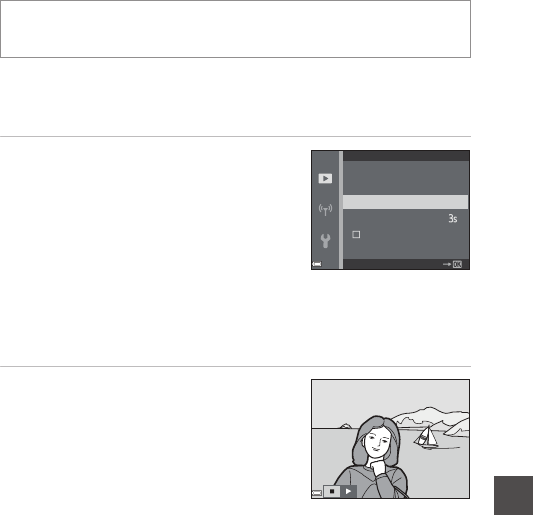
93
Using Menus
Slide Show
Play back images one by one in an automated “slide show.” When movie files
are played back in the slide show, only the first frame of each movie is
displayed.
1Use the multi selector HI to
select Start and press the
kbutton.
•The slide show begins.
•To change the interval between images,
select Frame intvl, press the k button,
and specify the desired interval time before
selecting Start.
•To repeat the slide show automatically, select Loop and press the k button
before selecting Start.
•The maximum playback time is up to about 30 minutes even if Loop is
enabled.
2End or restart the slide show.
•The screen shown on the right is displayed
after the slide show ends or is paused. To
exit the show, select G and then press the
k button. To resume the slide show, select
F and then press the k button.
Operations During Playback
•Use the multi selector JK to display the previous/next image. Press and
hold to rewind/fast forward.
•Press the k button to pause or end the slide show.
Press the c button (playback mode) M d button M Slide show M
kbutton
Slide show
S ta r t
Lo op
Frame i ntvl
Pau se
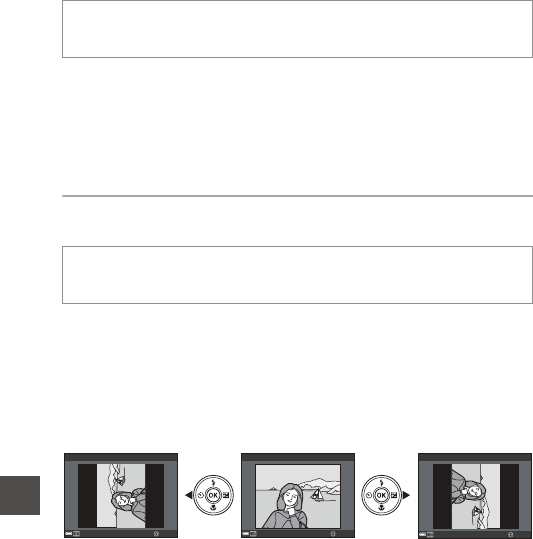
94
Using Menus
Protect
The camera protects selected images from accidental deletion.
Select images to protect or cancel protection from the image selection screen
(A97).
Note that formatting the memory card or the camera’s internal memory
permanently deletes all data including protected files (A115).
Rotate Image
Specify the orientation in which saved images are displayed during playback.
Still images can be rotated 90 degrees clockwise or 90 degrees
counterclockwise.
Select an image from the image selection screen (A97). When the Rotate
image screen is displayed, press the multi selector JK to rotate the image 90
degrees.
Press the k button to finalize display orientation, and save orientation
information with the image.
Press the c button (playback mode) M d button M Protect M
kbutton
Press the c button (playback mode) M d button M Rotate image M
k button
Rot a t eBac k
Rot a t e i m ag e
Rot a t eBac k
Rot a t e i m ag e
Rot a t eBac k
Rot a t e i m ag e
Rotate 90 degrees
counterclockwise
Rotate 90 degrees
clockwise
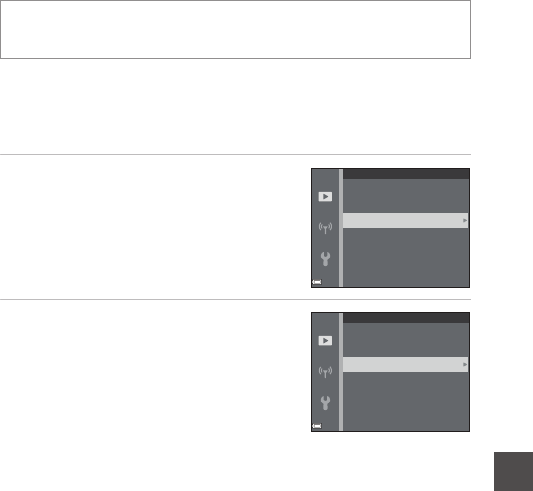
95
Using Menus
Copy (Copy Between the Memory Card and Internal
Memory)
Images can be copied between a memory card and the internal memory.
•When a memory card that contains no images is inserted and the camera is
switched to playback mode, Memory contains no images. is displayed. In
that case, press the d button to select Copy.
1Use the multi selector HI to
select a destination option to
which images are copied and
press the k button.
2Select a copy option and press the
kbutton.
•When you choose Selected images, use the
image selection screen to specify images
(A97).
BNotes About Copying Images
•Only files in formats that this camera can record can be copied.
•Operation is not guaranteed with images captured with another make of camera
or that have been modified on a computer.
CCopying Images in a Sequence
•If you select a key picture of a sequence in Selected images, all images in the
sequence are copied.
•If you press the d button while images in a sequence are displayed, only the
Card to camera copy option is available. All images in the sequence are copied if
you select Current sequence.
Press the c button (playback mode) M d button M Copy M
kbutton
Co py
Ca me ra to card
Ca rd to c ame ra
Ca me ra to car d
Se le ct ed im ag es
Al l image s

96
Using Menus
Sequence Display Options
Select the method used to display images in the sequence (A60).
Settings are applied to all sequences, and the setting is saved in the camera’s
memory even if the camera is turned off.
Press the c button (playback mode) M d button M Sequence display
options M kbutton
Option Description
Q Individual pictures Displays each image in a sequence individually.
F is displayed on the playback screen.
V Key picture only
(default setting)
Displays only the key picture for images in a
sequence.
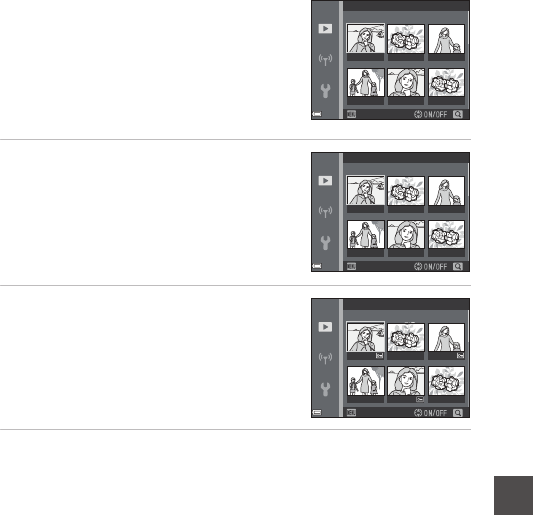
97
Using Menus
The Image Selection Screen
When an image selection screen such as the
one shown on the right is displayed while
operating the camera, follow the procedures
described below to select the images.
1Use the multi selector JK to
select an image.
•Move the zoom control (A1) toward g (i)
to switch to full-frame playback or f (h)
to switch to thumbnail playback.
•Only one image can be selected for Rotate
image. Proceed to step 3.
2Use HI to select or deselect (or
to specify the number of copies).
•When an image is selected, an icon is
displayed with the image. Repeat steps 1
and 2 to select additional images.
3Press the k button to apply image selection.
•When a confirmation dialog is displayed, follow the on-screen instructions to
operate.
Pro tec t
Ba ck
Pro tec t
Ba ck
Pro tec t
Ba ck
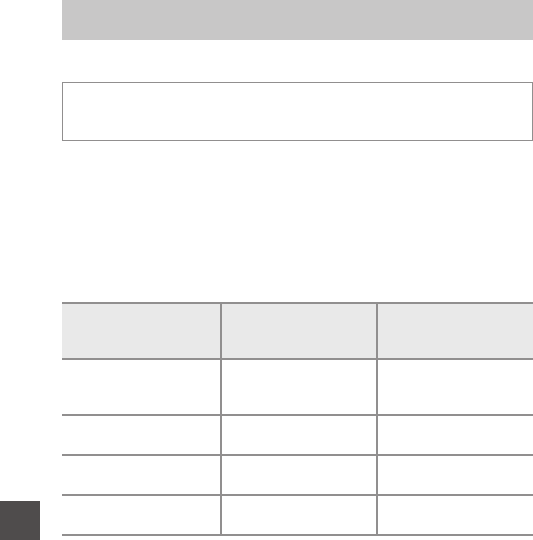
98
Using Menus
Movie Options
Select the desired movie option to record. Select normal speed movie options
to record at normal speed, or HS movie options (A99) to record in slow or fast
motion. The movie options that can be selected vary depending on the Frame
rate setting (A104).
•Memory cards with an SD Speed Class rating of 6 or faster are
recommended for recording movies (A152).
Normal Speed Movie Options
1Interlaced format uses Fields per second.
2The setting is not available when using certain effects in special effects mode or
glamour retouch.
The Movie Menu
Enter shooting mode M d button M D menu icon M Movie options
M k button
Option
(Image size/Frame rate1,
File format)
Image size Aspect ratio
(horizontal to vertical)
e
S
1080/30p2
1080/25p2
(default setting)
1920 × 1080 16:9
Z
U
1080/60i2
1080/50i21920 × 1080 16:9
f
V
720/30p2
720/25p21280 × 720 16:9
g
W
480/30p
480/25p 640 × 480 4:3
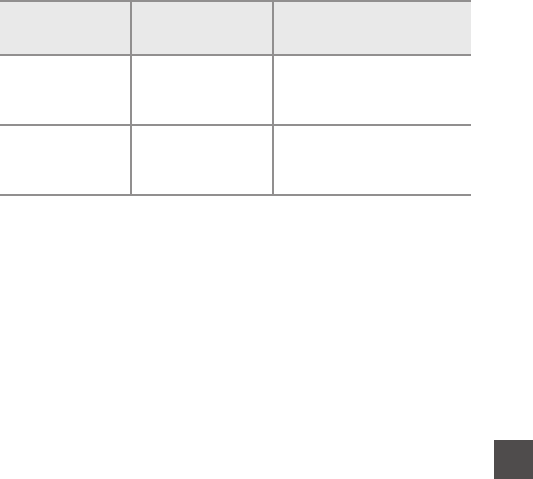
99
Using Menus
HS Movie Options
Recorded movies are played back in fast or slow motion.
See “Recording Movies in Slow Motion and Fast Motion (HS Movie)” (A101).
1The setting is not available when using certain effects in special effects mode or
glamour retouch.
2While recording movies, the camera can be switched between normal speed
movie recording and slow motion or fast motion movie recording.
The maximum recording time shown here refers only to the portion of the movie
that is recorded in slow motion or fast motion.
BNotes About HS Movie
•Sound is not recorded.
•Zoom position, focus, exposure, and white balance are locked when movie
recording starts.
Option
Image size
Aspect ratio
(horizontal to vertical)
Description
h
aHS 480/4×1640 × 480
4:3
1/4-speed slow motion movies
•Max. recording time2:
15 seconds (playback time:
1 minute)
j
YHS 1080/0.5×11920 × 1080
16:9
2× speed fast motion movies
•Max. recording time2:
2 minutes (playback time:
1 minute)
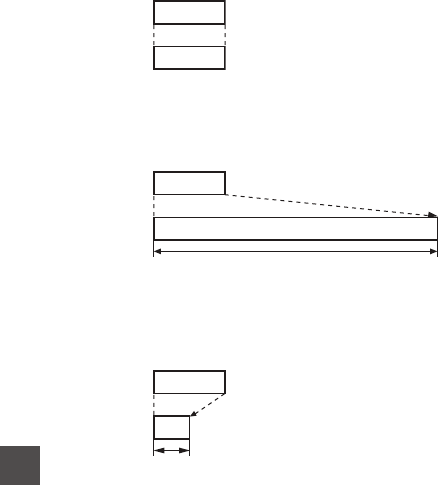
100
Using Menus
CPlaying Back in Slow Motion and Fast Motion
When recording at normal speed:
When recording at h/a HS 480/4×:
Movies are recorded at 4× normal speed.
They are played back in slow motion at 4× slower speed.
When recording at j/Y HS 1080/0.5×:
Movies are recorded at 1/2 normal speed.
They are played back in fast motion at 2× faster speed.
Recording
time
Playback
time
10 s
10 s
Recording
time
Playback
time
Slow motion playback
10 s
40 s
Recording
time
Playback
time
Fast motion playback
10 s
5 s
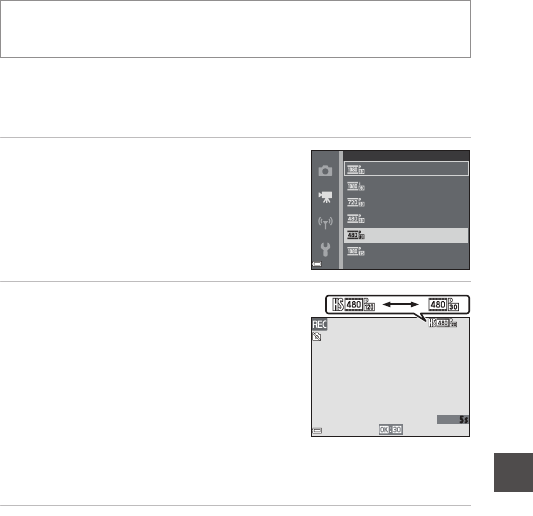
101
Using Menus
Recording Movies in Slow Motion and Fast Motion (HS
Movie)
Movies recorded using HS movie can be played back in slow motion at 1/4 of
the normal playback speed, or in fast motion at twice the normal playback
speed.
1Use the multi selector HI to
select an HS movie option (A99)
and press the k button.
•After applying the option, press the d
button to return to the shooting screen.
2Press the b (e movie-record)
button to start recording.
•The camera starts recording an HS movie.
•The camera switches between normal
speed movie recording and HS movie
recording each time the k button is
pressed.
•The movie options icon changes when
switching between HS movie recording
and normal speed movie recording.
•When the maximum recording time for HS movies (A99) is reached, the
camera automatically switches to normal speed movie recording.
3Press the b (e movie-record) button to end recording.
Enter shooting mode M d button M D menu icon M Movie options
M k button
Mo vie op ti ons
HS 1 080/0 .5
×
HS 4 80/4
×
48 0/ 30p
72 0/ 30p
10 80 /30p
10 80 /60i
5 s

102
Using Menus
Autofocus Mode
Set how the camera focuses in movie mode.
•When an HS movie option is selected in Movie options, the setting is fixed
at Single AF.
Enter shooting mode M d button M D menu icon M Autofocus mode
M k button
Option Description
A Single AF
(default setting)
Focus is locked when movie recording starts.
Select this option when the distance between the camera and
subject will remain fairly consistent during movie recording.
B Full-time AF
The camera focuses continuously during movie recording.
Select this option when the distance between the camera
and subject will change significantly during recording. The
sound of the camera focusing may be heard in the recorded
movie. Use of Single AF is recommended to prevent the
sound of the camera focusing from interfering with recording.
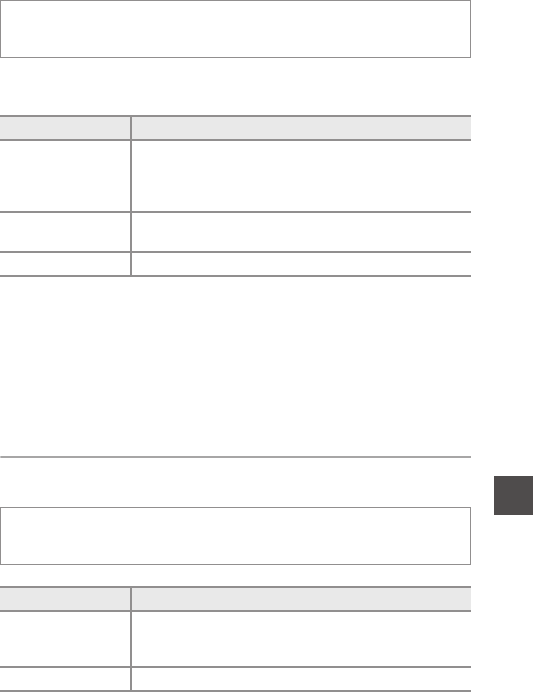
103
Using Menus
Movie VR
Select the vibration reduction setting used when recording movies.
Set to Off when using a tripod to stabilize the camera during shooting.
•When an HS movie option is selected in Movie options, the setting is fixed
at Off.
BNotes About Movie VR
•The effects of camera shake may not be completely eliminated in some situations.
•After turning on the camera or after switching from playback mode to shooting
mode, wait for the shooting mode screen to be displayed completely before
taking pictures.
Wind Noise Reduction
•When an HS movie option is selected in Movie options, the setting is fixed
at Off.
Enter shooting mode M d button M D menu icon M Movie VR M
kbutton
Option Description
V On (hybrid)
(default setting)
Performs optical compensation for camera shake using
lens shift VR and simultaneously performs electronic VR
using image processing. The angle of view (i.e., the area
visible in the frame) becomes narrower.
g On Performs compensation for camera shake using lens shift
VR.
Off Vibration reduction is disabled.
Enter shooting mode M d button M D menu icon M Wind noise
reduction M k button
Option Description
Y On
Reduces the sound that is produced when wind passes
over the microphone during movie recording. Other
sounds may become difficult to hear during playback.
Off (default setting) Wind noise reduction is disabled.

104
Using Menus
Frame Rate
Select the frame rate (fields per second for the interlaced format) used when
recording movies. When the frame rate setting is switched, options that can be
set in Movie options (A98) change.
Enter shooting mode M d button M D menu icon M Frame rate M
kbutton
Option Description
30 fps (30p/60i) Suited for playback on a TV using the NTSC standard.
25 fps (25p/50i) Suited for playback on a TV using the PAL standard.
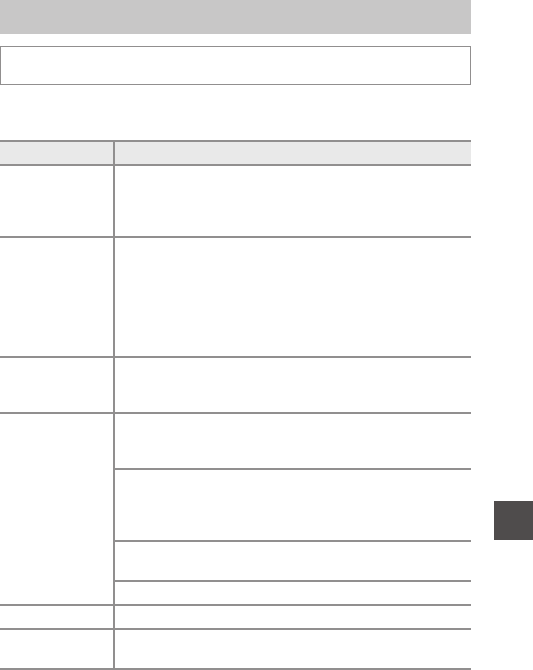
105
Using Menus
Configure the Wi-Fi (wireless LAN) settings to connect the camera and a smart
device.
The Wi-Fi Options Menu
Press the d button M J menu icon M k button
Option Description
Connect to smart
device
Select when wirelessly connecting the camera and a smart
device.
See “Using the Wi-Fi (Wireless LAN) Function” (A118) for
more information.
Upload from
camera
Select when wirelessly connecting the camera and a smart
device. See “Using the Wi-Fi (Wireless LAN) Function” (A118)
for more information.
•The images to transfer can be selected on the image
selection screen before establishing a Wi-Fi connection
(A97). The SSID and password of the camera are displayed
on the screen after images are selected.
Disable Wi-Fi
Select to terminate the wireless connection between the
camera and a smart device. See “Using the Wi-Fi (Wireless
LAN) Function” (A118) for more information.
Options
SSID: Change the SSID. The SSID configured here is displayed
on the smart device. Set a 1- to 24-character alphanumeric
SSID.
Auth./encryp.: Select whether or not to encrypt the
communications between the camera and the connected
smart device. Communications are not encrypted when
Open (default setting) is selected.
Password: Set the password. Set an 8- to 16-character
alphanumeric password.
Channel: Select the channel used for wireless connections.
Current settings Display the current settings.
Restore default
settings
The wireless connection is terminated if this option is
performed while Wi-Fi is connected.
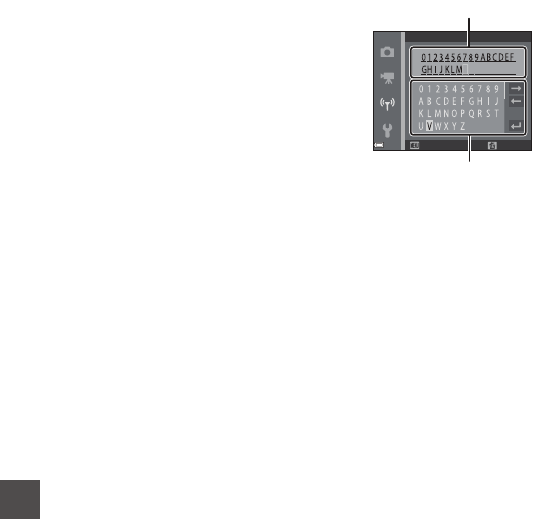
106
Using Menus
Operating the Text Input Keyboard
•Use the multi selector HIJK to select
alphanumeric characters. Press the k button
to enter the selected character in the text
field and move the cursor to the next space.
•To move the cursor in the text field, select N
or O on the keyboard, and press the
kbutton.
•To delete one character, press the l button.
•To apply the setting, select P on the
keyboard and press the k button.
Ba ck De let e
SSID
Text field
Keyboard
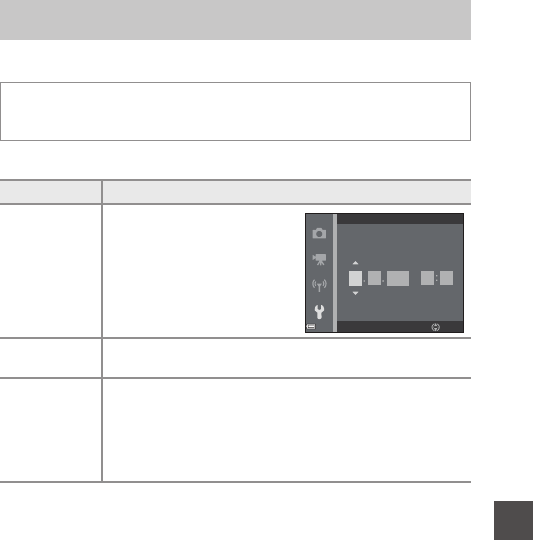
107
Using Menus
Time Zone and Date
Set the camera clock.
The Setup Menu
Press the d button M z menu icon M Time zone and date M
kbutton
Option Description
Date and time
•Select a field: Press the multi
selector JK.
•Edit the date and time: Press
HI.
•Apply the setting: Select the
minute setting and press the
k button.
Date format Select Year/Month/Day, Month/Day/Year, or Day/Month/
Year.
Time zone
Set time zone and daylight saving time.
•When Travel destination (x) is set after having set the
home time zone (w), the time difference between the travel
destination and the home time zone is automatically
calculated, and the date and time are saved for the selected
region.
Ed it
Da te an d t ime
201501 01 00 00
YMD h m
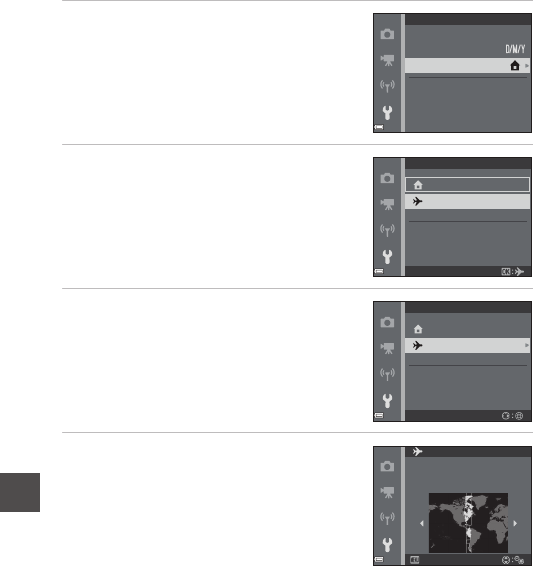
108
Using Menus
Setting the Time Zone
1Use the multi selector HI to
select Time zone and press the
kbutton.
2Select w Home time zone or x
Travel destination and press the
k button.
•The date and time displayed in the monitor
changes depending on whether the home
time zone or travel destination is selected.
3Press K.
4Use JK to select the time zone.
•Press H to enable daylight saving time
function, and W is displayed. Press I to
disable the daylight saving time function.
•Press the k button to apply the time zone.
•If the correct time is not displayed for the
home or travel destination time zone
setting, set the appropriate time in Date
and time.
Ti me zo ne and da te
Ti me zo ne
Da te fo rmat
Da te an d time
15/11/2015 15:30
Lo nd on, Ca sab lan ca
15/11/2015 15:30
Lo nd on, Ca sab lan ca
Ho me time z one
Tra vel d estin at ion
Ti me zo ne
15/11/2015 15:30
Lo nd on, Ca sab lan ca
Tra vel d estin at ion
Home time zone
Ti me zo ne
1 0 : 3 0 – 0 5 : 0 0
Ne w Yor k, To ro nto, Li ma
Ba ck
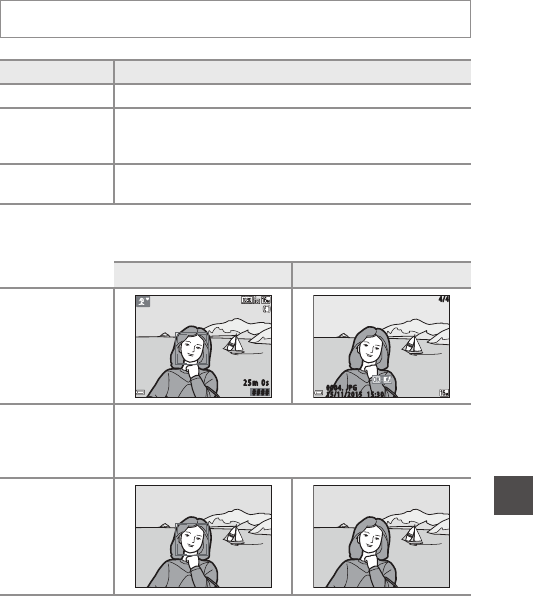
109
Using Menus
Monitor Settings
Photo Info
Press the d button M z menu icon M Monitor settings M k button
Option Description
Photo info Set whether or not to display information in the monitor.
Image review
Set whether or not to display the captured image immediately
after shooting.
•Default setting: On
Brightness Adjust the brightness.
•Default setting: 3
Shooting mode Playback mode
Show info
Auto info
(default setting)
The same information as shown in Show info is displayed,
and it is hidden as shown in Hide info if no operations are
performed for a few seconds. The information is displayed
again when an operation is performed.
Hide info
2 5 m 0 s
# # # #
4 / 4
15/11/2015 15:30
0004. JPG
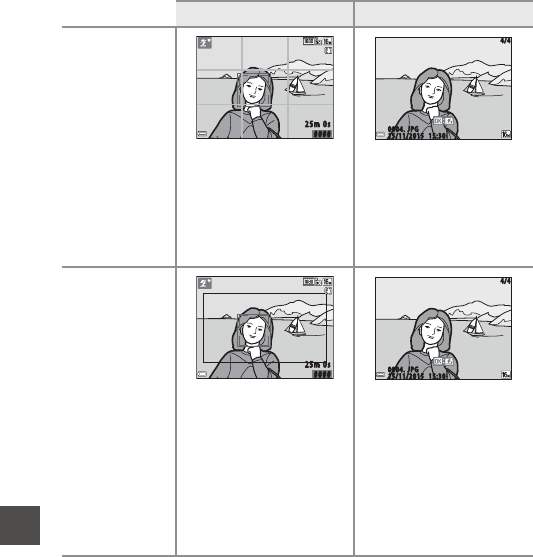
110
Using Menus
Framing
grid+auto info In addition to the information
shown in Auto info, a
framing grid is displayed to
help frame pictures.
The framing grid is not
displayed while recording
movies.
Same as Auto info.
Movie
frame+auto info
In addition to the information
shown in Auto info, a frame
is displayed before movie
recording begins that
represents the area that will
be captured when recording
movies.
The movie frame is not
displayed while recording
movies.
Same as Auto info.
Shooting mode Playback mode
2 5 m 0 s
# # # #
4 / 4
1 5/ 11 /2 0 1 5 15 :3 0
0004. JPG
2 5 m 0 s
# # # #
4 / 4
1 5/ 11 /2 0 1 5 15 :3 0
0004. JPG
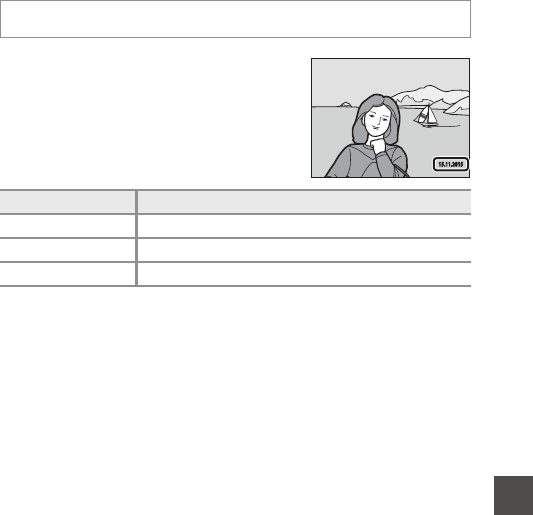
111
Using Menus
Date Stamp
The shooting date and time can be stamped on
images when shooting. The information can be
printed even when using a printer that does not
support the date imprinting function.
BNotes About Date Stamp
•Stamped dates form a permanent part of image data and cannot be deleted. The
date and time cannot be stamped on images after they have been captured.
•The date and time cannot be stamped in the following situations:
- When using Night portrait (when Y Hand-held is selected), Night
landscape (when Y Hand-held is selected), Backlighting (when HDR is set
to o), or Easy panorama scene mode
- When the continuous shooting setting (A81) is set to Pre-shooting cache,
Continuous H: 120 fps, or Continuous H: 60 fps
- When shooting movies
- When saving still images during moving recording
- When creating still images by editing movies
•The stamped date and time may be difficult to read when using a small image size.
CPrinting a Shooting Date on Images Without a Date Stamp
You can transfer images to a computer and use the ViewNX 2 software (A130) to
imprint the shooting date on the images when they are printed.
Press the d button M z menu icon M Date stamp M k button
Option Description
fDate Date is stamped on images.
SDate and time Date and time are stamped on images.
Off (default setting) Date and time are not stamped on images.
15 . 11.2 0 15

112
Using Menus
Photo VR
Select the vibration reduction setting used when shooting still images.
Set to Off when using a tripod to stabilize the camera during shooting.
BNotes About Photo VR
•After turning on the camera or after switching from playback mode to shooting
mode, wait for the shooting mode screen to be displayed completely before
taking pictures.
•Images in the camera monitor may be displayed blurry immediately after shooting.
•The effects of camera shake may not be completely eliminated in some situations.
AF Assist
Press the d button M z menu icon M Photo VR M k button
Option Description
g On (default setting) Compensation for camera shake is performed using lens
shift VR.
Off Compensation is not performed.
Press the d button M z menu icon M AF assist M k button
Option Description
a Auto
(default setting)
The AF-assist illuminator automatically lights up when you
press the shutter-release button under dim lighting. The
illuminator has a range of about #5.0# m (#16# ft) at the
maximum wide-angle position and about #5.0# m (#16# ft) at
the maximum telephoto position.
•The AF-assist illuminator may not light depending on the
position of the focus area or the shooting mode.
Off The AF-assist illuminator does not light.

113
Using Menus
Digital Zoom
BNotes About Digital Zoom
•Digital zoom cannot be used in the following shooting modes:
-Portrait, Night portrait, Night landscape, Backlighting (when HDR is set),
Easy panorama, or Pet portrait scene mode
- Smart portrait mode
•Digital zoom cannot be used in other shooting modes when using certain settings
(A56).
Sound Settings
Press the d button M z menu icon M Digital zoom M k button
Option Description
On (default setting) Digital zoom is enabled.
Off Digital zoom is disabled.
Press the d button M z menu icon M Sound settings M k button
Option Description
Button sound
When On (default setting) is selected, the camera produces
one beep when operations are performed, two beeps when
focus is acquired on the subject, and three beeps when an
error occurs. The welcome screen sound is also produced.
•Sounds are disabled when using Pet portrait or Bird-
watching scene mode.
Shutter sound
When On (default setting) is selected, the shutter sound is
produced when the shutter is released.
•The shutter sound is not produced when using continuous
shooting mode, when recording movies, or when using
Pet portrait or Bird-watching scene mode.

114
Using Menus
Auto Off
Set the amount of time that elapses before the camera enters standby mode
(A13).
You can select 30 s, 1 min (default setting), 5 min, or 30 min.
CSetting the Auto Off Function
The time that passes before the camera enters standby mode is fixed in the following
situations:
•When a menu is displayed: 3 minutes (when auto off is set to 30 s or 1 min)
•When shooting using Pet portrait auto release: 5 minutes (when auto off is set
to 30 s or 1 min)
•When shooting using Smile timer: 5 minutes (when auto off is set to 30 s or
1 min)
•When the audio/video cable is connected: 30 minutes
•When an HDMI cable is connected: 30 minutes
•When the AC Adapter EH-67 is connected: 30 minutes
Press the d button M z menu icon M Auto off M k button

115
Using Menus
Format Card/Format Memory
Use this option to format a memory card or the internal memory.
Formatting the memory cards or internal memory permanently deletes
all data. Data that has been deleted cannot be recovered. Make sure to
save important images to a computer before formatting.
Formatting a Memory Card
•Insert a memory card into the camera.
•Select Format card in the setup menu and then press the k button.
Formatting the Internal Memory
•Remove the memory card from the camera.
•Select Format memory in the setup menu and then press the k button.
To start formatting, select Format on the screen that is displayed and press the
k button.
•Do not turn the camera off or open the battery-chamber/memory card slot
cover during formatting.
•This setting cannot be selected while Wi-Fi is connected.
Press the d button M z menu icon M Format card/Format memory M
k button

116
Using Menus
Language
Select a language for display of camera menus and messages.
Reset All
When Reset is selected, the camera’s settings are restored to their default
values.
•Some settings, such as Time zone and date or Language, are not reset.
•This setting cannot be selected while Wi-Fi is connected.
CResetting File Numbering
To reset file numbering to “0001”, delete all images saved on the memory card or in
the internal memory (A18) before selecting Reset all.
Battery Type
To ensure that the camera shows the correct battery level (A10), select the
type that matches the batteries currently in use.
Press the d button M z menu icon M Language M k button
Press the d button M z menu icon M Reset all M k button
Press the d button M z menu icon M Battery type M k button
Option Description
k Alkaline (default setting) LR6/L40 (AA-size) alkaline batteries
l COOLPIX (Ni-MH) Nikon EN-MH2 rechargeable Ni-MH (nickel metal
hydride) batteries
m Lithium FR6/L91 (AA-size) lithium batteries

117
Using Menus
Conformity Marking
View the standards with which the camera complies.
Firmware Version
View the current camera firmware version.
•This setting cannot be selected while Wi-Fi is connected.
Press the d button M z menu icon M Conformity marking M
kbutton
Press the d button M z menu icon M Firmware version M k button

118
Using the Wi-Fi (Wireless LAN) Function
Using the Wi-Fi (Wireless LAN)
Function
You can perform the following functions if you install the dedicated software
“Wireless Mobile Utility” on your smart device that runs on Android OS or iOS,
and connect it to the camera.
Take Photos
You can capture still images using the two methods described below.
•Release the shutter on the camera and save the captured images to a smart
device.
•Use a smart device to remotely release the camera shutter and save images
to the smart device.
View Photos
Images that are saved in the camera’s memory card can be transferred and
viewed on your smart device. You can also preselect the images in the camera
that you want to transfer to your smart device.
1Use your smart device to connect to the Google Play Store,
App Store or other online apps marketplace and search for
“Wireless Mobile Utility.”
•Check the user’s manual provided with your smart device for further details.
2Check the description and other information and install the
software.
CUser’s Manual for Wireless Mobile Utility
Download the user’s manual from the website below.
•Android OS: http://nikonimglib.com/ManDL/WMAU/
•iOS: http://nikonimglib.com/ManDL/WMAU-ios/
Functions That Can Be Performed Using Wi-Fi
Installing the Software on the Smart Device
To establish a connection with the camera, press the Z (Wi-Fi) button on the
camera, and then turn on the Wi-Fi function of the smart device. Start the “Wireless
Mobile Utility” after the connection is established.
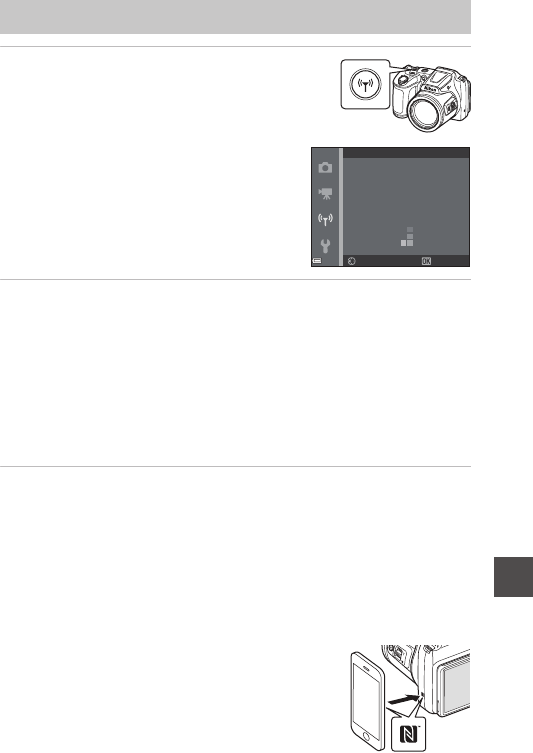
119
Using the Wi-Fi (Wireless LAN) Function
1Press the Z (Wi-Fi) button on the
camera.
•The screen shown on the right is displayed.
•If no connection confirmation is received
from the smart device within three minutes,
No access. is displayed and the camera
returns to the Wi-Fi options screen.
•The screen shown on the right can also be
displayed using Connect to smart device
(A105) in the Wi-Fi options menu.
2Set the Wi-Fi setting on the smart device to On.
•Check the user’s manual provided with your smart device for further details.
•After the network names (SSIDs) that can be used for the smart device are
displayed, select the SSID displayed on the camera.
•When Auth./encryp. in the Wi-Fi options menu is set to WPA2-PSK-AES,
you are prompted to enter a password. Enter the password that is displayed
on the camera.
•When the camera is successfully connected to a Wi-Fi network, the shooting
screen is displayed on the camera with the Wi-Fi communication indicator
(A4).
3Start the “Wireless Mobile Utility” installed on the smart
device.
•The screen for selecting “Take photos” or “View photos” is displayed.
•When the message “Cannot connect to camera.” is displayed, return to step
1 and retry the procedure.
CTouching an NFC-compatible Smart Device to the Camera for a
Wi-Fi Connection
When you use a smart device that is compatible with near
field communication (NFC) functions, you can establish a
Wi-Fi connection and start the “Wireless Mobile Utility” by
touching Y (N-Mark) on the smart device to the one on
the camera.
Connecting the Smart Device to the Camera
Co nn ec t to sma rt d evi ce
XXXXXXXXXXXXXXXXXX
XXXXXXXXXXXXXXXXXX
SSID:
Ba ck Ca nc el

120
Using the Wi-Fi (Wireless LAN) Function
To Terminate the Wi-Fi Connection
Perform one of the operations described below.
•Turn off the camera.
•Select Disable Wi-Fi in the Wi-Fi options menu on the camera (except when the
camera is operated by remote control).
•Set the Wi-Fi setting on the smart device to Off.
BNotes About Wi-Fi Connection
•Wi-Fi connection operations are disabled in the following situations:
- When the camera is connected to a TV, computer, or printer.
- While recording movies
- While the camera is processing data such as saving images or recording movies
- When the camera is connected to a smart device
•Select Disable Wi-Fi in areas where the use of radio waves is prohibited.
•When Wi-Fi is connected, Auto off is disabled.
•When Wi-Fi is connected, the battery drains faster than normal.
•If the battery level is low, the Wi-Fi connection is terminated.
CSecurity Settings
If no security settings (encryption and password) are configured for the camera’s
Wi-Fi function, unauthorized third parties may access the network and cause harm.
We strongly recommend performing the required security settings before using the
Wi-Fi function.
Use Options in the Wi-Fi options menu (A105) to perform the security settings.

121
Using the Wi-Fi (Wireless LAN) Function
You can preselect images in the camera that you want to transfer to a smart
device. Movies cannot be preselected for transfer.
1Select images to transfer.
You can preselect the images to transfer to a smart device in the following
menus:
•Mark for Wi-Fi upload in the playback menu (A92)
•Upload from camera in the Wi-Fi options menu (A105)
When using Upload from camera, the SSID and password of the camera are
displayed after images are selected.
2Connect the camera and smart device (A119).
After the camera and smart device are connected and the “Wireless Mobile
Utility” starts, tap “View Photos” on the displayed confirmation screen to
transfer the specified images to the smart device.
BPreselecting Images to Transfer During Playback
While the camera is in playback mode, press the Z (Wi-Fi) button or use the NFC
function to establish a Wi-Fi connection, and preselect the displayed images that you
want to transfer.
•You can preselect one image at a time in full-frame playback mode.
•You can preselect one image at a time in thumbnail playback mode.
•You can preselect all images at the selected shooting date in calendar display
mode.
This operation is not available when you use Connect to smart device in the Wi-Fi
options menu to establish the Wi-Fi connection.
Preselecting Images in the Camera That
You Want to Transfer to a Smart Device
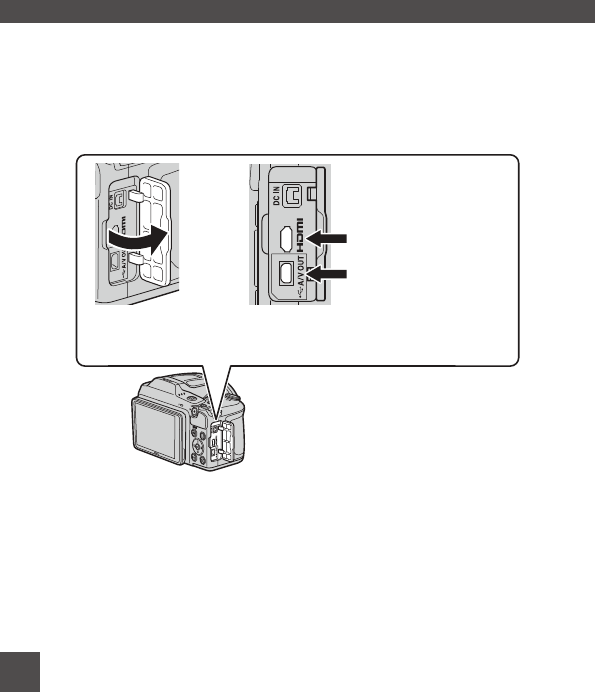
122
Connecting the Camera to a TV, Printer, or Computer
Connecting the Camera to a TV,
Printer, or Computer
You can enhance your enjoyment of images and movies by connecting the
camera to a TV, printer, or computer.
•Before connecting the camera to an external device, make sure the
remaining battery level is sufficient and turn the camera off. Before
disconnecting, make sure to turn the camera off.
•If the AC Adapter EH-67 (available separately) is used, this camera can be
powered from an electrical outlet. Do not use any other make or model of
AC adapter as it may cause the camera to heat up or malfunction.
•For information about the connection methods and subsequent operations,
refer to the documentation included with the device in addition to this
document.
Insert the plug straight.
USB/audio/video output
connector
Open the connector
cover.
HDMI micro connector
(Type D)
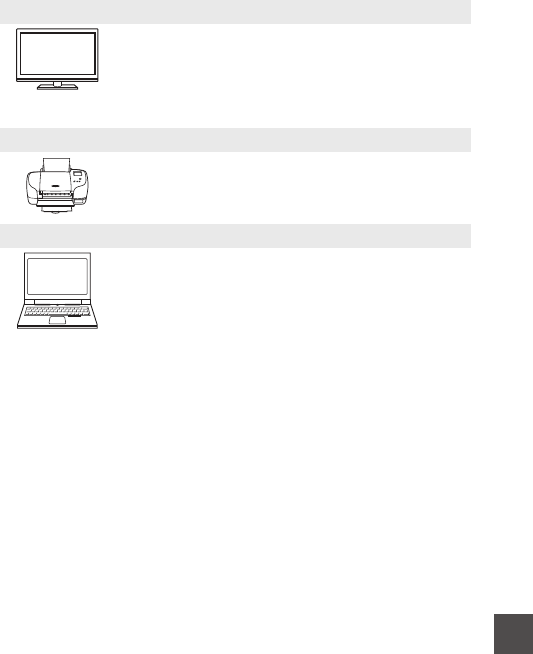
123
Connecting the Camera to a TV, Printer, or Computer
Viewing images on a TV A124
Images and movies captured with the camera can be viewed
on a TV.
Connection method: Connect the video and audio plugs of
the optional audio video cable to the TV’s input jacks.
Alternatively, connect a commercially available HDMI cable to
the TV’s HDMI input jack.
Printing images without using a computer A126
If you connect the camera to a PictBridge-compatible printer,
you can print images without using a computer.
Connection method: Connect the camera directly to the
printer’s USB port with the included USB cable.
Viewing and organizing images on a computer A130
You can transfer images to a computer to perform simple
retouching and manage image data.
Connection method: Connect the camera to the computer’s
USB port with the USB cable.
•Before connecting to a computer, install ViewNX 2 on the
computer (A130).
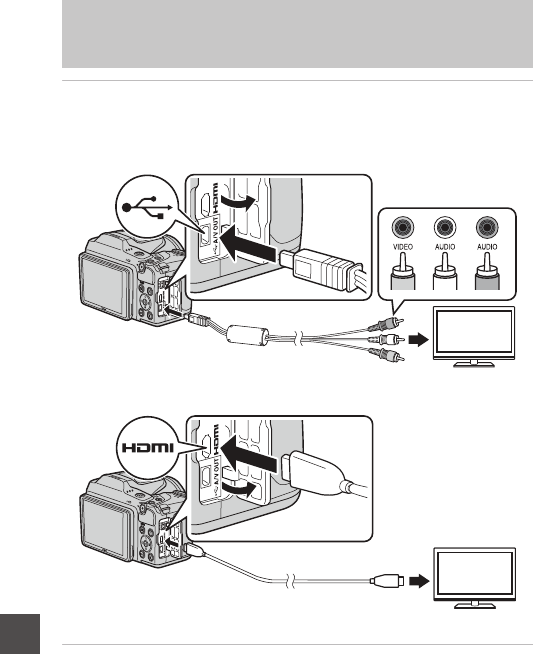
124
Connecting the Camera to a TV, Printer, or Computer
1Turn off the camera and connect it to the TV.
•Make sure that the plugs are properly oriented. Do not insert or remove the
plugs at an angle when connecting or disconnecting them.
When using the audio/video cable
When using a commercially available HDMI cable
2Set the TV’s input to external input.
•See the documentation provided with your TV for details.
Connecting the Camera to a TV (Playback
on a TV)
WhiteYellow Red
HDMI micro connector (Type D)
to HDMI jack

125
Connecting the Camera to a TV, Printer, or Computer
3Hold down the c (playback)
button to turn on the camera.
•Images are displayed on the TV.
•The camera monitor does not turn on.
CImage Resolution During TV Output
The option best suited to the TV to which the camera is connected is automatically
selected from 1080i, 720p, or 480p.
CHDMI
HDMI (High-Definition Multimedia Interface) is a multimedia interface.
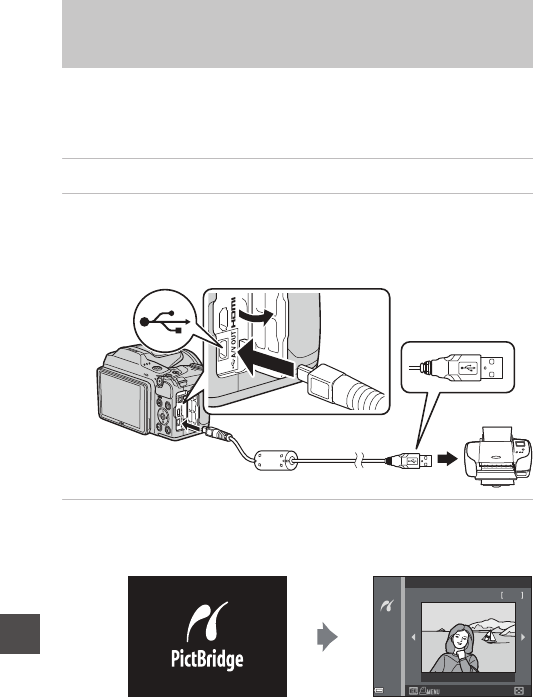
126
Connecting the Camera to a TV, Printer, or Computer
Users of PictBridge-compatible printers can connect the camera directly to the
printer and print images without using a computer.
Connecting the Camera to a Printer
1Turn on the printer.
2Turn off the camera and connect it to the printer using the
USB cable.
•Make sure that the plugs are properly oriented. Do not insert or remove the
plugs at an angle when connecting or disconnecting them.
3Turn on the camera.
•The PictBridge startup screen (1) is displayed in the camera monitor,
followed by the Print selection screen (2).
Connecting the Camera to a Printer (Direct
Print)
Print selection
15 /11 /20 15 N o. 3 2 32
1 2

127
Connecting the Camera to a TV, Printer, or Computer
Printing Images One at a Time
1Use the multi selector JK to
select the desired image and press
the k button.
•Move the zoom control toward f (h) to
switch to thumbnail playback or g (i) to
switch to full-frame playback.
2Use HI to select Copies and
press the kbutton.
•Use HI to set the desired number of
copies (up to nine) and press the k button.
3Select Paper size and press the
kbutton.
•Select the desired paper size and press the
k button.
•To print with the paper size setting
configured on the printer, select Default.
•The paper size options available on the
camera vary depending on the printer that
you use.
4Select Start print and press the
kbutton.
•Printing starts.
Print selection
15 /11 /20 15 N o. 3 2 32
1pr in ts
PictBridge
Paper s ize
Co pies
St ar t pr int
St ar t pr int
Co pies
Paper s ize
4pr in ts
PictBridge
4pr in ts
Paper s ize
Co pies
St ar t pr int
PictBridge

128
Connecting the Camera to a TV, Printer, or Computer
Printing Multiple Images
1When the Print selection screen
is displayed, press the d (menu)
button.
2Use the multi selector HI to
select Paper size and press the
kbutton.
•Select the desired paper size and press the
k button.
•To print with the paper size setting
configured on the printer, select Default.
•The paper size options available on the
camera vary depending on the printer that you use.
•To exit the print menu, press the d button.
3Select Print selection or Print all
images and press the k button.
Print selection
15 /11 /20 15 N o. 3 2 32
Pr in t m enu
Paper s ize
Pr int a ll imag es
Pr int s el ec tion
Pr in t m enu
Paper s ize
Pr int a ll imag es
Pr int s el ec tion

129
Connecting the Camera to a TV, Printer, or Computer
Print selection
Select images (up to 99) and the
number of copies (up to 9) of each.
•Use the multi selector JK to
select images, and use HI to
specify the number of copies to
be printed.
•Images selected for printing are
indicated by a and the number
of copies to be printed. To cancel
the print selection, set the number of copies to 0.
•Move the zoom control toward g (i) to switch to full-frame
playback or f (h) to switch to thumbnail playback.
•Press the k button when setting is complete. When the screen for
confirming the number of print copies is displayed, select Start
print and press the k button to start printing.
Print all images
One copy each of all images saved in the internal memory, or on the
memory card, is printed.
•When the screen for confirming the number of print copies is
displayed, select Start print and press the k button to start
printing.
1 1
3
5
Print selection
Ba ck
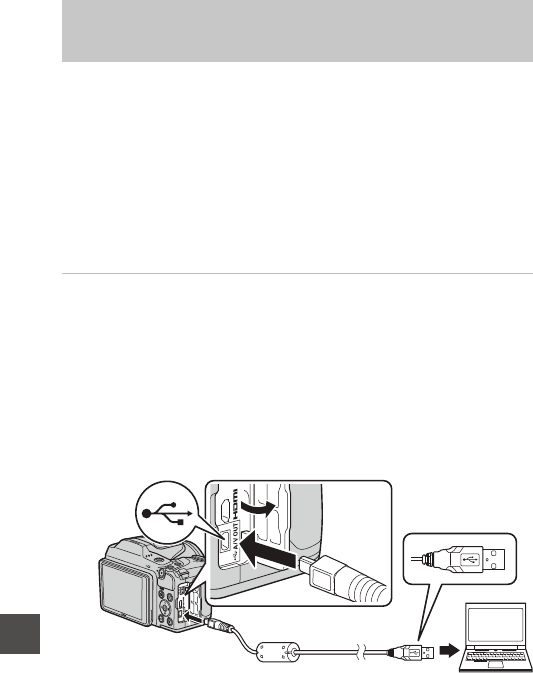
130
Connecting the Camera to a TV, Printer, or Computer
Installing ViewNX 2
ViewNX 2 is free software that enables you to transfer images and movies to
your computer so that you can view, edit, or share them. To install ViewNX 2,
download the ViewNX 2 installer from the website below and follow the on-
screen installation instructions.
http://nikonimglib.com/nvnx/
For system requirements and other information, see the Nikon website for your
region.
Transferring Images to a Computer
1Prepare a memory card that contains images.
You can use any of the methods below to transfer images from the memory
card to a computer.
•SD memory card slot/card reader: Insert the memory card into the card
slot of your computer or the card reader (commercially available) that is
connected to the computer.
•
Direct USB connection
: Turn the camera off and ensure that the memory card
is inserted in the camera. Connect the camera to the computer using the USB
cable. Turn the camera on.
To transfer images that are saved in the camera’s internal memory, remove
the memory card from the camera before connecting it to the computer.
Using ViewNX 2 (Transferring Images to a
Computer)
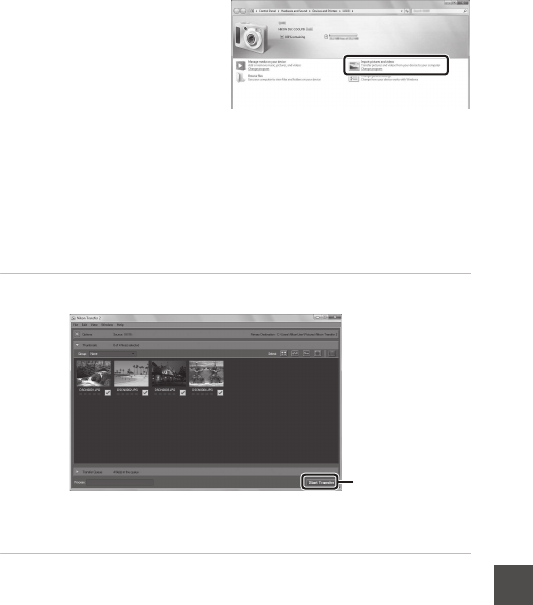
131
Connecting the Camera to a TV, Printer, or Computer
If a message is displayed prompting you to choose a program, select Nikon
Transfer 2.
•When using Windows 7
If the dialog shown at right is
displayed, follow the steps
below to select Nikon Transfer 2.
1 Under Import pictures and
videos, click Change
program. A program
selection dialog will be
displayed; select Import File using Nikon Transfer 2 and click OK.
2 Double-click Import File.
If the memory card contains a large number of images, it may take a while for
Nikon Transfer 2 to start. Wait until Nikon Transfer 2 starts.
BNotes About Connecting the USB Cable
Operation is not guaranteed if the camera is connected to the computer via a USB
hub.
2After Nikon Transfer 2 starts, click Start Transfer.
•Image transfer begins. When image transfer is complete, ViewNX 2 starts and
the transferred images are displayed.
•Consult online help for more information on using ViewNX 2.
3Terminate the connection.
•If you are using a card reader or card slot, choose the appropriate option in
the computer operating system to eject the removable disk corresponding
to the memory card and then remove the memory card from the card reader
or card slot.
•If the camera is connected to the computer, turn the camera off and
disconnect the USB cable.
Start Transfer

132
Technical Notes
Technical Notes
Caring for the Product .................................................................................133
The Camera..............................................................................................133
Batteries ....................................................................................................134
Memory Cards.........................................................................................135
Cleaning and Storage ..................................................................................136
Cleaning....................................................................................................136
Storage ......................................................................................................136
Error Messages ...............................................................................................137
Troubleshooting ............................................................................................140
File Names........................................................................................................146
Optional Accessories....................................................................................147
Specifications..................................................................................................148
Approved Memory Cards ...................................................................152
Index...................................................................................................................154

Technical Notes
133
Observe the precautions described below in addition to the warnings in “For
Your Safety” (Av–vii) when using or storing the device.
The Camera
Do Not Apply Strong Impact to the Camera
The product may malfunction if subjected to strong shock or vibration. In addition,
do not touch or apply force to the lens.
Keep Dry
The device will be damaged if immersed in water or subjected to high humidity.
Avoid Sudden Changes in Temperature
Sudden changes in temperature, such as when entering or leaving a heated building
on a cold day, can cause condensation to form inside the device. To prevent
condensation, place the device in a carrying case or a plastic bag before exposing it
to sudden changes in temperature.
Keep Away from Strong Magnetic Fields
Do not use or store this device in the vicinity of equipment that generates strong
electromagnetic radiation or magnetic fields. Doing so could result in loss of data or
camera malfunction.
Do Not Point the Lens at Strong Light Sources for Extended Periods
Avoid pointing the lens at the sun or other strong light sources for extended periods
when using or storing the camera. Intense light may cause the image sensor to
deteriorate or produce a white blur effect in photographs.
Turn the Product Off Before Removing or Disconnecting the Power
Source or Memory Card
Do not remove the batteries while the product is on, or while images are being saved
or deleted. Forcibly cutting power in these circumstances could result in loss of data
or in damage to product memory or internal circuitry.
Notes About the Monitor
•Monitors and electronic viewfinders are constructed with extremely high precision;
at least 99.99% of pixels are effective, with no more than 0.01% being missing or
defective. Hence while these displays may contain pixels that are always lit (white,
red, blue, or green) or always off (black), this is not a malfunction and has no effect
on images recorded with the device.
•Images in the monitor may be difficult to see under bright lighting.
•Do not apply pressure to the monitor, as this could cause damage or malfunction.
Should the monitor break, care should be taken to avoid injury caused by broken
glass and to prevent the liquid crystal from the display touching the skin or
entering the eyes or mouth.
Caring for the Product

Technical Notes
134
Batteries
Precautions for Use
•Note that the batteries may become hot after use.
•Do not use batteries beyond their recommended expiration date.
•Do not turn the camera on and off repeatedly if discharged batteries are inserted in
the camera.
Carrying Spare Batteries
We recommend carrying spare batteries depending on where you are shooting. It
may be difficult to purchase batteries in certain areas.
Charging Batteries
If using optional rechargeable batteries, charge the batteries before taking pictures.
Batteries are not fully charged at the time of purchase.
Be sure to read and follow the warnings noted in the operating instructions included
with the battery charger.
Charging Rechargeable Batteries
•Do not mix batteries with different amounts of charge remaining, or batteries of a
different make or model.
•When using EN-MH2 batteries with this camera, charge four batteries at a time using
Battery Charger MH-73. Use only Battery Charger MH-73 to charge EN-MH2 batteries.
•When using Battery Charger MH-73, only charge EN-MH2 batteries.
•EN-MH1 rechargeable Ni-MH batteries cannot be used.
Notes About Rechargeable Ni-MH Batteries
•If you repeatedly charge rechargeable Ni-MH batteries while they still have some
charge remaining, the message Battery exhausted. may be displayed prematurely
when using the batteries. This is due to the “memory effect,” in which the amount of
charge the batteries can hold decreases temporarily. Use the batteries until there is
no charge remaining and they will return to their normal behavior.
•Rechargeable Ni-MH batteries discharge even when not being used. We
recommend charging the batteries just before using them.
Using the Batteries When Cold
On cold days, the capacity of batteries tends to decrease. If exhausted batteries are
used at a low temperature, the camera may not turn on. Keep spare batteries in a
warm place and exchange as necessary. Once warmed, cold batteries may recover
some of their charge.
Battery Terminals
Dirt on the battery terminals may prevent the camera from functioning. Should the
battery terminals become dirty, wipe them off with a clean, dry cloth before use.
Remaining Battery Charge
If you insert discharged batteries into the camera, the camera may indicate that the
batteries have adequate charge remaining. This is a characteristic of batteries.

Technical Notes
135
Recycling Used Batteries
Replace the batteries when they no longer hold a charge. Used batteries are a
valuable resource. Please recycle used batteries in accordance with local regulations.
Memory Cards
Precautions for Use
•Use only Secure Digital memory cards. See “Approved Memory Cards” (A152) for
recommended memory cards.
•Be sure to follow the precautions described in the documentation included with
the memory card.
•Do not put labels or stickers on memory cards.
Formatting
•Do not format the memory card using a computer.
•The first time you insert a memory card that has been used in another device into
this camera, be sure to format it with this camera.
We recommend formatting new memory cards with this camera before using
them with this camera.
•Note that formatting a memory card permanently deletes all images and
other data on the memory card. Be sure to make copies of any images you wish
to keep before formatting the memory card.
•If the message Card is not formatted. Format card? is displayed when the
camera is turned on, the memory card must be formatted. If there is data that you
do not want to delete, select No. Copy the necessary data to a computer, etc. If you
want to format the memory card, select Yes. The confirmation dialog will be
displayed. To start formatting, press the k button.
•Do not perform the following during formatting, while data is being written to or
deleted from the memory card, or during data transfer to a computer. Failure to
observe this precaution could result in the loss of data or in damage to the camera
or memory card:
- Open the battery-chamber/memory card slot cover to remove/insert the
batteries or memory card.
- Turn off the camera.
- Disconnect the AC adapter.

Technical Notes
136
Cleaning
Do not use alcohol, thinner, or other volatile chemicals.
Storage
Remove the batteries if the camera will not be used for an extended period. To
prevent mold or mildew, take the camera out of storage at least once a month.
Turn the camera on and release the shutter a few times before putting the
camera away again. Do not store the camera in any of the following locations:
•Places that are poorly ventilated or subject to humidity of over 60%
•Exposed to temperatures above 50°C (122°F) or below –10°C (14°F)
•Next to equipment that produces strong electromagnetic fields, such as
televisions or radios
Cleaning and Storage
Lens
Avoid touching glass parts with your fingers. Remove dust or lint with
a blower (typically a small device with a rubber bulb attached to one
end that is pumped to produce a stream of air out the other end). To
remove fingerprints or other stains that cannot be removed with a
blower, wipe the lens with a soft cloth, using a spiral motion that
starts at the center of the lens and working toward the edges. If this
fails, clean the lens using a cloth lightly dampened with commercial
lens cleaner.
Monitor
Remove dust or lint with a blower. To remove fingerprints and other
stains, clean the monitor with a soft, dry cloth, being careful not to
apply pressure.
Body
Use a blower to remove dust, dirt, or sand, then wipe gently with a
soft, dry cloth.
After using the camera at the beach or other sandy or dusty
environment, wipe off any sand, dust, or salt with a dry cloth lightly
dampened with fresh water and dry thoroughly. Note that foreign
matter inside the camera could cause damage not covered by
the warranty.

Technical Notes
137
Refer to the table below if an error message is displayed.
Error Messages
Display Cause/Solution A
Battery temperature is
elevated. The camera
will turn off. The camera turns off automatically. Wait until
the temperature has cooled before resuming
use.
–
The camera will turn off
to prevent overheating.
Memory card is write
protected.
The write-protect switch is in the “lock”
position.
Slide the write-protect switch to the “write”
position.
–
This card cannot be
used.
An error occurred while accessing the
memory card.
•Use an approved memory card.
•Check that the terminals are clean.
•Confirm that the memory card is correctly
inserted.
7, 152
This card cannot be
read.
Card is not formatted.
Format card?
The memory card has not been formatted for
use in the camera.
Formatting deletes all data saved on the
memory card. If you need to keep copies of
any images, make sure to select No and save
the copies to a computer or other medium
before formatting the memory card. Select
Yes and press the kbutton to format the
memory card.
135
Out of memory. Delete images or insert a new memory card. 7, 18
Image cannot be saved.
An error occurred while saving the image.
Insert a new memory card or format the
memory card or internal memory.
115
The camera has run out of file numbers.
Insert a new memory card or format the
memory card or internal memory.
115
There is insufficient space to save the copy.
Delete images from the destination. 18
Image cannot be
modified. Check that the images can be edited. 62, 144

Technical Notes
138
Cannot record movie.
A time-out error occurred while saving the
movie on the memory card.
Select a memory card with a faster write speed.
69, 152
Memory contains no
images.
There are no images in the internal memory
or on the memory card.
•Remove the memory card to play back
images in the internal memory.
•To copy the images saved in the camera’s
internal memory to the memory card, press
the d button to select Copy in the
playback menu.
8
95
File contains no image
data.
The file was not created or edited with this camera.
The file cannot be viewed on this camera.
View the file using a computer or the device
used to create or edit this file.
–
All images are hidden.
There are no images available for a slide show, etc.
93
This image cannot be
deleted.
The image is protected.
Disable protection. 94
No access.
The camera could not receive the signal from
the smart device. Establish the wireless
connection again.
•Press the Z (Wi-Fi) button.
•Touch an NFC-compatible smart device to
the camera.
•Select Connect to smart device in the
Wi-Fi options menu.
105,
119
Could not connect.
The camera failed to establish the connection
while receiving the signals from the smart
device. Set a different channel in Channel
under Options in the Wi-Fi options menu,
and establish the wireless connection again.
105,
119
Wi-Fi connection
terminated.
The Wi-Fi connection is terminated in the
following situations:
•The signal strength is poor.
•The battery level is low.
•
A cable or memory card was inserted or removed.
Use batteries with a sufficient amount of
charge remaining, disconnect the TV,
computer, or printer, and then establish the
wireless connection again.
105,
119
Raise the flash.
The flash is lowered.
Raise the flash when shooting in Night
portrait or Backlighting (when HDR is set
to k) scene mode.
25, 27,
43
Display Cause/Solution A

Technical Notes
139
* See the documentation provided with your printer for further guidance and
information.
Lens error. Try again
after turning the camera
off and on.
If the error persists, contact your retailer or
Nikon-authorized service representative. 6, 140
Communications error
An error occurred while communicating with
the printer.
Turn the camera off and reconnect the USB
cable.
126
System error
An error occurred in the camera’s internal
circuitry.
Turn the camera off, remove and reinsert the
batteries, and turn the camera on. If the error
persists, contact your retailer or Nikon-
authorized service representative.
140
Printer error: check
printer status.
After solving the problem, select Resume
and press the kbutton to resume printing.* –
Printer error: check
paper.
Load the specified size of paper, select
Resume, and press the k button to resume
printing.*
–
Printer error: paper jam. Remove the jammed paper, select Resume,
and press the kbutton to resume printing.* –
Printer error: out of
paper.
Load the specified size of paper, select
Resume, and press the k button to resume
printing.*
–
Printer error: check ink.
There is a problem with the printer’s ink.
Check the ink, select Resume, and press the
k button to resume printing.*
–
Printer error: out of ink. Replace the ink cartridge, select Resume, and
press the kbutton to resume printing.* –
Printer error: file corrupt.
There is a problem with the image file to be
printed.
Select Cancel and press the k button to
cancel printing.
–
Display Cause/Solution A

Technical Notes
140
If the camera fails to function as expected, check the list of common problems
below before consulting your retailer or Nikon-authorized service
representative.
Power, Display, Settings Issues
Troubleshooting
Problem Cause/Solution A
The camera is on
but does not
respond.
Wait for recording to end.
If the problem persists, turn the camera off.
If the camera does not turn off, remove and reinsert
the battery or batteries or, if you are using an AC
adapter, disconnect and reconnect the AC adapter.
Note that although any data currently being
recorded will be lost, data that have already been
recorded will not be affected by removing or
disconnecting the power source.
–
The camera
cannot be turned
on.
The batteries are exhausted. 7, 134
The camera turns
off without
warning.
•The camera automatically turns off to save power
(auto off function).
•The camera and batteries may not work properly
at low temperatures.
•The inside of the camera has become hot. Leave
the camera off until the inside of the camera has
cooled, and then try turning it on again.
13
134
–
The monitor is
blank.
•The camera is off.
•The camera automatically turns off to save power
(auto off function).
•The flash lamp flashes while the flash is charging.
Wait until charging is complete.
•The camera is connected to a TV or computer.
•The camera and smart device are connected
using a Wi-Fi connection and the camera is being
operated by remote control.
9
13
–
–
–
The camera
becomes hot.
The camera may become hot when used for an
extended period of time to shoot movies or when
used in a hot environment; this is not a malfunction.
–
The monitor is
hard to read.
•Adjust the monitor brightness.
•The monitor is dirty. Clean the monitor.
109
136

Technical Notes
141
Shooting Issues
O flashes on the
screen.
•If the camera clock has not been set, O flashes
on the shooting screen, and images and movies
saved before the clock is set are dated “00/00/
0000 00:00” and “01/01/2015 00:00” respectively.
Set the correct time and date for Time zone and
date in the setup menu.
•The camera clock is not as accurate as ordinary
watches or clocks. Periodically compare the time
of the camera clock with that of a more accurate
timepiece, and reset as required.
3, 107
Date and time of
recording are not
correct.
No indicators
displayed in
monitor.
Hide info is selected for Photo info in Monitor
settings in the setup menu. 109
Date stamp not
available.
Time zone and date has not been set in the setup
menu. 107
Date not stamped
on images even
when Date
stamp is enabled.
•The current shooting mode does not support
Date stamp.
•The date cannot be stamped on movies.
111
Screen for setting
time zone and
date is displayed
when the camera
is turned on.
The clock battery is exhausted; all settings were
restored to their default values. 9, 11
The camera
settings reset.
The camera
makes sound.
When Autofocus mode is set to Full-time AF or
while in some shooting modes, the camera may
produce an audible focusing sound.
20, 102
Problem Cause/Solution A
Cannot switch to
shooting mode. Disconnect the HDMI cable or USB cable. 122
Cannot take
pictures or record
movies.
•
When the camera is in playback mode, press the
A
button, shutter-release button, or
b
(
e
) button.
•When menus are displayed, press the d button.
•
The flash is charging while the flash lamp is flashing.
•The batteries are exhausted.
1, 17
75
44
7, 134
Problem Cause/Solution A

Technical Notes
142
The camera
cannot focus.
•The subject is too close. Try shooting using scene
auto selector mode, Close-up scene mode, or
macro mode.
•The subject is hard to focus on.
•Set AF assist in the setup menu to Auto.
•Turn the camera off and then on again.
20, 21,
23, 26,
46
53
112
–
Images are
blurred.
•Use the flash.
•Increase the ISO sensitivity value.
•Enable Photo VR when shooting still images.
Enable Movie VR when recording movies.
•Use a tripod to stabilize the camera (using the
self-timer at the same time is more effective).
43
83
103,
112
45
Bright specks
appear in images
captured with
flash.
The flash is reflecting off particles in the air. Lower
the flash. 11, 43
Flash does not
fire.
•The flash is lowered.
•A scene mode that restricts the flash is selected.
•A function that restricts the flash is enabled.
11, 43
48
55
Digital zoom
cannot be used.
•Digital zoom is set to Off in the setup menu.
•Digital zoom cannot be used with certain
shooting modes or when using certain settings in
other functions.
113
56, 113
Image mode not
available. A function that restricts Image mode is enabled. 55
No sound when
the shutter is
released.
•Off is selected for Shutter sound in Sound
settings in the setup menu. No sound is
produced with some shooting modes and
settings, even when On is selected.
•Do not block the speaker.
113
1
AF-assist
illuminator does
not light.
Off is selected for AF assist in the setup menu. The
AF-assist illuminator may not light depending on
the position of the focus area or the shooting mode,
even when Auto is selected.
112
Problem Cause/Solution A

Technical Notes
143
Images appear
smeared. The lens is dirty. Clean the lens. 136
Colors are
unnatural. White balance or hue is not adjusted properly. 26, 79
Randomly spaced
bright pixels
(“noise”) appear in
image.
The subject is dark and the shutter speed is too
slow, or ISO sensitivity is too high. Noise can be
reduced by:
•Using the flash
•Specifying a lower ISO sensitivity setting
43
83
Images are too
dark
(underexposed).
•The flash is lowered or a shooting mode that
restricts the flash is selected.
•The flash window is blocked.
•The subject is beyond the range of the flash.
•Adjust exposure compensation.
•Increase ISO sensitivity.
•The subject is backlit. Select Backlighting scene
mode or raise the flash and set the flash mode
setting to X (fill flash).
11, 43,
48
12
149
47
83
27, 43
Images are too
bright
(overexposed).
Adjust exposure compensation. 47
Unexpected results
when flash set to
V
(auto with
red-eye reduction).
Use any scene mode other than Night portrait,
and change the flash mode to any setting other
than V (auto with red-eye reduction) and try
taking the picture again.
43, 48
Skin tones are not
softened.
•In some shooting conditions, facial skin tones
may not be softened.
•For images containing four or more faces, try using
the Skin softening effect in Glamour retouch in
the playback menu.
51
65
Saving images
takes time.
It may take more time to save images in the
following situations:
•When the noise reduction function is in operation,
such as when shooting in a dark environment
•When the flash mode is set to V (auto with
red-eye reduction)
•When shooting in Night portrait, Night
landscape, or Backlighting (when HDR is set
to o) scene mode
•When the skin softening function is applied while
shooting
•When using continuous shooting mode
–
44
25, 26,
27
35, 51
81
Problem Cause/Solution A

Technical Notes
144
Playback Issues
Problem Cause/Solution A
File cannot be
played back.
•This camera may not be able to play back images
saved with another make or model of digital
camera.
•This camera cannot play back movies recorded
with another make or model of digital camera.
•This camera may not be able to play back data
edited on a computer.
–
Cannot zoom in
on image.
•Playback zoom cannot be used with movies.
•When viewing small images, the playback zoom
ratio that is displayed may not match the actual
image zoom ratio.
•This camera may not be able to zoom in on
images captured with another make or model of
digital camera.
–
Cannot edit
images.
•Some images cannot be edited. Images that have
already been edited may not be edited again.
•There is not enough free space on the memory
card or in the internal memory.
•This camera is unable to edit images captured
with other cameras.
•Editing functions used for images are not
available for movies.
32, 62
–
–
–
Cannot rotate
image.
This camera cannot rotate images captured with
another make or model of digital camera. –
Images are not
displayed on TV.
•A computer or printer is connected to the
camera.
•The memory card contains no images.
•Remove the memory card to play back images in
the internal memory.
–
–
8
Nikon Transfer 2
does not start
when the camera
is connected to a
computer.
•The camera is off.
•The batteries are exhausted.
•The USB cable is not correctly connected.
•The camera is not recognized by the computer.
•The computer is not set to start Nikon Transfer 2
automatically. For more information about Nikon
Transfer 2, refer to help information contained in
ViewNX 2.
–
122
122,
130
–
–

Technical Notes
145
Images to be
printed are not
displayed.
•The memory card contains no images.
•Remove the memory card to print images in the
internal memory.
–
8
Cannot select
paper size with
the camera.
The camera cannot be used to select the paper size
in the following situations, even when printing from
a PictBridge-compatible printer. Use the printer to
select the paper size.
•The printer does not support the paper sizes
specified by the camera.
•The printer automatically selects the paper size.
–
Problem Cause/Solution A

Technical Notes
146
Images or movies are assigned file names as follows.
File name: DSCN
0001
.JPG
(1) (2) (3)
File Names
(1) Identifier
Not shown on the screen of the camera.
•DSCN: Original still images, movies, still images created by
editing movies
•SSCN: Small picture copies
•RSCN: Cropped copies
•FSCN: Images created by an image editing function other
than crop and small picture, movies created by the movie
editing function
(2) File number Assigned in ascending order, starting with “0001” and ending
with “9999.”
(3) Extension
Indicates file format.
•.JPG: Still images
•.MOV: Movies

Technical Notes
147
* When using EN-MH2 rechargeable Ni-MH batteries with the camera, charge the
batteries four at a time using Battery Charger MH-73. Also, do not charge batteries
at the same time if they have different amounts of charge remaining (A134). EN-
MH1 rechargeable Ni-MH batteries cannot be used.
Availability may vary with country or region.
See our website or brochures for the latest information.
Optional Accessories
Battery charger,
rechargeable batteries*
•Battery Charger MH-73 (includes four EN-MH2
rechargeable Ni-MH batteries)
•Replacement rechargeable batteries: Rechargeable
Ni-MH batteries EN-MH2-B4 (set of four EN-MH2
batteries)
AC adapter AC Adapter EH-67
Audio/video cable Audio Video Cable EG-CP16
Hand strap Hand Strap AH-CP1

Technical Notes
148
Nikon COOLPIX L840 Digital Camera
Specifications
Type Compact digital camera
Number of effective pixels #16.0# million (Image processing may reduce the
number of effective pixels.)
Image sensor
1
/
2.3
-in. type CMOS; approx. #16.76# million total pixels
Lens NIKKOR lens with #38#× optical zoom
Focal length #4.0#–#152# mm (angle of view equivalent to that
of #22.5#–#855# mm lens in 35mm [135] format)
f/-number f/#3–6.5#
Construction 12 elements in 9 groups (#3# ED lens elements)
Digital zoom magnification Up to 4× (angle of view equivalent to that of
approx. #3420# mm lens in 35mm [135] format)
Vibration reduction Lens shift (still images)
Lens shift and electronic VR (movies)
Autofocus (AF) Contrast-detect AF
Focus range
•[W]: Approx. #50# cm (#1# ft #8# in.)–∞,
[T]: Approx. #3.5# m (#11# ft #6# in.)–∞
•Macro mode: Approx. #1# cm (#0.4# in.) (when
zoom is set to middle position)–∞
(All distances measured from center of front surface
of lens)
Focus-area selection Face priority, manual with 99 focus areas, center,
subject tracking, target finding AF
Monitor
7.5 cm (3-in.), approx. 921k-dot, wide viewing angle
TFT LCD with anti-reflection coating and 5-level
brightness adjustment, tiltable approx. #85°#
downward, approx. #90°# upward
Frame coverage
(shooting mode)
Approx. #98#% horizontal and vertical (compared to
actual picture)
Frame coverage
(playback mode)
Approx. #100#% horizontal and vertical (compared
to actual picture)
Storage
Media Internal memory (approx. #59# MB), SD/SDHC/
SDXC memory card
File system DCF and Exif 2.3 compliant
File formats
Still images: JPEG
Movies: MOV (Video: H.264/MPEG-4 AVC, Audio:
LPCM stereo)

Technical Notes
149
Image size
(pixels)
•16M (High) [4608 × 3456P]
•16M [4608 × 3456]
•8M [3264 × 2448]
•4M [2272 × 1704]
•2M [1600 × 1200]
•VGA [640 × 480]
•16:9 [4608 × 2592]
•1:1 [3456 × 3456]
ISO sensitivity
(Standard output
sensitivity)
•ISO 125–1600
•ISO 3200, 6400 (available when using Auto
mode)
Exposure
Metering mode Matrix, center-weighted (digital zoom less than 2×),
spot (digital zoom 2× or more)
Exposure control
Programmed auto exposure and exposure
compensation
(–2.0 – +2.0 EV in steps of 1/3 EV)
Shutter Mechanical and CMOS electronic shutter
Speed
•1/1500–1 s
•1/4000 s (maximum speed during high-speed
continuous shooting)
•4 s (Fireworks show scene mode)
Aperture Electronically-controlled ND filter (–2 AV) selection
Range 2 steps (f/#3# and f/#6# [W])
Self-timer Can be selected from 10 s and 2 s
Flash
Range (approx.)
(ISO sensitivity: Auto)
[W]: #0.5#–#6.9# m (#1# ft #8# in.–#22# ft)
[T]: #1.5#–#3.2# m (#5#–#10# ft)
Flash control TTL auto flash with monitor preflashes
Interface
USB connector
Hi-Speed USB
•Supports Direct Print (PictBridge)
•Audio/video output connector (can be selected
from NTSC and PAL)
HDMI output connector HDMI micro connector (Type D)
DC input connector For AC Adapter EH-67 (available separately)

Technical Notes
150
Wi-Fi (Wireless LAN)
Standards IEEE 802.11b/g/n (standard wireless LAN protocol)
Communications
protocols
IEEE 802.11b: DBPSK/DQPSK/CCK
IEEE 802.11g: OFDM
IEEE 802.11n: OFDM
Range (line of sight) Approx. 10 m (11 yd)
Operating frequency 2412–2462 MHz (1-11 channels)
Data rates (actual
measured values)
IEEE 802.11b: 5 Mbps
IEEE 802.11g: 20 Mbps
IEEE 802.11n: 20 Mbps
Security WPA2
Access protocols Infrastructure
Supported languages
Arabic, Bengali, Bulgarian, Chinese (Simplified and
Traditional), Czech, Danish, Dutch, English, Finnish,
French, German, Greek, Hindi, Hungarian,
Indonesian, Italian, Japanese, Korean, Marathi,
Norwegian, Persian, Polish, Portuguese (European
and Brazilian), Romanian, Russian, Serbian, Spanish,
Swedish, Tamil, Telugu, Thai, Turkish, Ukrainian,
Vietnamese
Power sources
•Four LR6/L40 (AA-size) alkaline batteries
•Four FR6/L91 (AA-size) lithium batteries
•Four EN-MH2 rechargeable Ni-MH batteries
(available separately)
•AC Adapter EH-67 (available separately)
Battery life1
Still images
•Approx. ### shots when using alkaline batteries
•Approx. ### shots when using lithium batteries
•Approx. ### shots when using EN-MH2 batteries
Movies (actual battery
life for recording)2
•Approx. # h ## min when using alkaline batteries
•Approx. # h ## min when using lithium batteries
•Approx. # h ## min when using EN-MH2 batteries
Tripod socket 1/4 (ISO 1222)
Dimensions (W × H × D) Approx. #113.5# × #78.3# × #96.0# mm (#4.5# ×
#3.1# × #3.8# in.) (excluding projections)
Weight Approx. #520# g (#1# lb #2.4# oz) (including
batteries and memory card)

Technical Notes
151
•Unless otherwise stated, all figures assume fresh LR6/L40 (AA-size) alkaline
batteries and an ambient temperature of 23 ±3°C (73.4 ±5.4°F) as specified
by the Camera and Imaging Products Association (CIPA).
1Battery life may vary depending on conditions of use, such as the interval between
shots or the length of time that menus and images are displayed. The included
batteries are for trial use only. Figures listed for lithium batteries are measured
using commercially available FR6/L91 (AA-size) Energizer(R) Ultimate Lithium
batteries.
2Individual movie files cannot exceed 4 GB in size or 29 minutes in length.
Recording may end before this limit is reached if camera temperature becomes
elevated.
•Nikon will not be held liable for any errors this manual may contain.
•The appearance of this product and its specifications are subject to change
without notice.
Operating environment
Temperature 0°C–40°C (32°F–104°F)
Humidity 85% or less (no condensation)
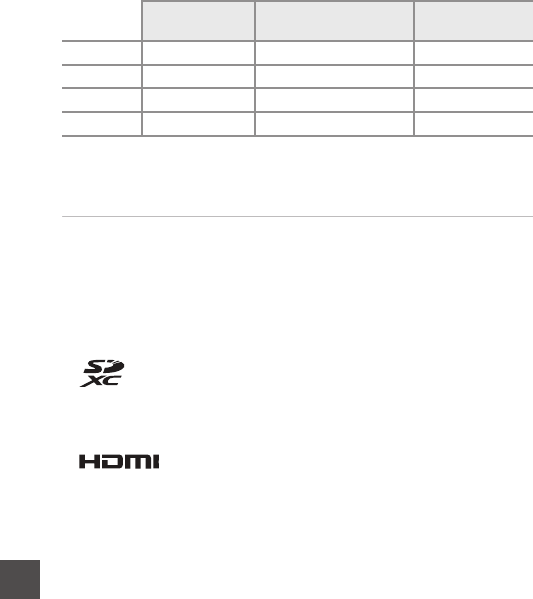
Technical Notes
152
Approved Memory Cards
The following Secure Digital (SD) memory cards have been tested and
approved for use in this camera.
•Memory cards with an SD Speed Class rating of 6 or faster are
recommended for recording movies. When using a memory card with a
lower Speed Class rating, movie recording may stop unexpectedly.
•Contact the manufacturer for details on the above cards. We cannot guarantee
camera performance when using memory cards made by other manufacturers.
•If you use a card reader, make sure that it is compatible with your memory card.
Trademark Information
•Windows is either a registered trademark or trademark of Microsoft
Corporation in the United States and/or other countries.
•Adobe, the Adobe logo, and Reader are either trademarks or registered
trademarks of Adobe Systems Incorporated in the United States and/or
other countries.
•SDXC, SDHC, and SD Logos are trademarks of SD-3C, LLC.
•PictBridge is a trademark.
•HDMI, HDMI logo and High-Definition Multimedia Interface are trademarks
or registered trademarks of HDMI Licensing LLC.
•Wi-Fi and the Wi-Fi logo are trademarks or registered trademarks of the Wi-Fi
Alliance.
•Android and Google Play are trademarks or registered trademarks of Google,
Inc.
•The N-Mark is a trademark or registered trademark of NFC Forum, Inc. in the
United States and in other countries.
•All other trade names mentioned in this manual or the other
documentation provided with your Nikon product are the trademarks or
registered trademarks of their respective holders.
SD memory card SDHC memory card SDXC memory
card
SanDisk – 4 GB, 8 GB, 16 GB, 32 GB 64 GB, 128 GB
TOSHIBA – 4 GB, 8 GB, 16 GB, 32 GB 64 GB
Panasonic 2 GB 4 GB, 8 GB, 16 GB, 32 GB 64 GB
Lexar – 8 GB, 16 GB, 32 GB 64 GB, 128 GB

Technical Notes
153
AVC Patent Portfolio License
This product is licensed under the AVC Patent Portfolio License for the personal
and non-commercial use of a consumer to (i) encode video in compliance with
the AVC standard (“AVC video”) and/or (ii) decode AVC video that was encoded
by a consumer engaged in a personal and non-commercial activity and/or was
obtained from a video provider licensed to provide AVC video. No license is
granted or shall be implied for any other use.
Additional information may be obtained from MPEG LA, L.L.C.
See http://www.mpegla.com.
FreeType License (FreeType2)
Portions of this software are copyright © 2012 The FreeType Project
(http://www.freetype.org). All rights reserved.
MIT License (HarfBuzz)
Portions of this software are copyright © 2015 The HarfBuzz Project
(http://www.freedesktop.org/wiki/Software/HarfBuzz). All rights reserved.

154
Technical Notes
Symbols
g (Telephoto)......................................... 14
f (Wide-angle).................................... 14
i Playback zoom ......................... 17, 57
h Thumbnail playback.......... 17, 58
o Scene auto selector mode
................................................................ 20, 23
b Scene mode ........................... 20, 24
O
Special effects mode
... 20, 33
F Smart portrait mode......... 20, 35
n
Short movie show mode
... 20, 38
A Auto mode............................. 20, 41
c Playback mode.............................. 17
C List by date mode......................... 59
J Wi-Fi options menu
................................................... 75, 105, 119
z Setup menu........................... 75, 107
k Apply selection button ....... 2, 75
A Shooting mode button..... 2, 20
b (e
movie-record) button
... 2, 22
c Playback button ...................... 2, 17
l Delete button.............................. 2, 18
d Menu button......................... 2, 75
m (flash pop-up) button...... 1, 11, 43
q (snap-back zoom) button............ 1
Z Wi-Fi button ........................................ 1
m Flash mode ................................ 21, 43
n Self-timer................................... 21, 45
p Macro mode............................ 21, 46
o Exposure compensation
............................................... 21, 35, 41, 47
j Help...................................................... 24
Y N-Mark ............................... 1, 119, 121
A
AC adapter ............................................ 147
AF area mode......................................... 84
AF assist ................................................... 112
AF-assist illuminator............................... 1
Alkaline batteries ..................................... 7
Aperture value........................................ 16
Audio/video cable .... 123, 124, 147
Audio/video-in jack.............. 123, 124
Auto flash ................................................. 44
Auto mode ...................................... 20, 41
Auto off............................................ 13, 114
Autofocus...................................... 53, 102
Autofocus mode....................... 87, 102
B
Background music............................... 91
Backlighting o............................ 24, 27
Battery .................................................... 7, 11
Battery charger................................... 147
Battery level.............................................. 10
Battery type........................................... 116
Battery-chamber/memory card slot
cover................................................................ 2
Beach Z................................................... 24
Bird-watching l................................ 29
Blink proof................................................ 89
Brightness.............................................. 109
Button sound....................................... 113
C
Calendar display................................... 58
Capturing still images while
recording movies ................................. 71
Close-up k.................................... 24, 26
Compression ratio............................... 77
Computer................................... 123, 130
Conformity marking ........................ 117
Connect to smart device ... 105, 119
Index

155
Technical Notes
Connector cover...................................... 2
Continuous shooting......................... 81
Copy............................................................. 95
Creative slider......................................... 41
Crop..................................................... 57, 67
Cross process o.................................. 33
Current settings ................................. 105
D
Date and time ............................... 9, 107
Date format..................................... 9, 107
Date stamp............................................. 111
Daylight saving time................. 9, 108
DC input connector............................... 2
Delete.................................................. 18, 61
Digital zoom................................. 14, 113
Direct print ................................. 123, 126
D-Lighting ............................................... 64
Dusk/dawn i...................................... 24
E
Easy panorama p...................... 24, 30
Easy panorama playback................. 32
Editing images....................................... 62
Editing movies.............................. 72, 73
End recording......................................... 91
EN-MH2....................................... 134, 147
Exposure compensation
............................................... 21, 35, 41, 47
Extracting still images .............. 72, 74
Eyelet for camera strap......................... 1
F
Face detection....................................... 50
Face priority............................................ 84
File names.............................................. 146
Fill flash...................................................... 44
Fireworks show m.................... 24, 26
Firmware version................................ 117
Fixed range auto................................... 83
Flash................................................. 1, 11, 43
Flash lamp.......................................... 2, 44
Flash mode...................................... 21, 43
Focus........................................................... 50
Focus area................................................. 13
Focus indicator ......................................... 3
Focus lock ................................................ 54
Food u.............................................. 24, 26
Format internal memory............... 115
Format memory cards............... 7, 115
Formatting........................................ 7, 115
Foundation makeup........................... 35
Frame rate............................................. 104
Full-frame playback............................. 17
Full-time AF........................................... 102
G
Glamour retouch ......................... 35, 65
H
HDMI cable................................ 123, 124
HDMI micro connector............ 2, 122
HDR .............................................................. 27
Help.............................................................. 24
High-contrast monochrome
F... 33
High-speed continuous ................... 81
Histogram................................................. 47
HS movie....................................... 99, 100
Hue................................................................ 41
I
Image mode........................................... 77
Image review....................................... 109
Internal memory ..................................... 8
Interval ....................................................... 88
ISO sensitivity......................................... 83
L
Landscape c........................................ 24
Language................................................ 116
Lens...................................................... 1, 148

156
Technical Notes
List by date mode................................ 59
Lithium batteries ..................................... 7
M
Macro mode................................... 21, 46
Mark for Wi-Fi upload ........................ 92
Memory card........................ 7, 135, 152
Memory card slot.................................... 7
Microphone (stereo) .............................. 1
Mirror b.................................................... 33
Monitor................................ 2, 3, 22, 136
Monitor settings ................................ 109
Moon L.................................................... 29
Movie menu................................... 75, 98
Movie options ....................................... 98
Movie recording .......................... 22, 68
Movie VR................................................. 103
Multi selector.................................... 2, 75
N
Night landscape j.................. 24, 26
Night portrait e.......................... 24, 25
Nikon Transfer 2.................................. 131
Nostalgic sepia E.............................. 33
Number of exposures remaining
................................................................ 10, 78
Number of shots.......................... 88, 90
O
Optical zoom .......................................... 14
Optional accessories ....................... 147
Options.................................................... 105
P
Paper size .................................... 127, 128
Party/indoor f............................ 24, 25
Pet portrait auto release .................. 28
Pet portrait O.............................. 24, 28
Photo info.............................................. 109
Photo VR.................................................. 112
PictBridge.................................... 123, 126
Playback ............................................ 17, 72
Playback menu.............................. 75, 92
Playback mode....................................... 17
Playback zoom.............................. 17, 57
Pop l...................................................... 33
Portrait b................................................. 24
Power switch/power-on lamp... 1, 9
Preset manual........................................ 80
Pre-shooting cache.................... 81, 82
Pressing halfway ................................... 16
Print..................................... 123, 127, 128
Printer ........................................... 123, 126
Protect........................................................ 94
Q
Quick effects........................................... 62
Quick retouch........................................ 63
R
Rechargeable battery..................... 147
Rechargeable nickel-metal hydride
batteries......................................................... 7
Recording movies ...................... 22, 68
Recording slow motion movies
............................................................ 99, 100
Red-eye correction............................. 64
Red-eye reduction .............................. 44
Remaining movie recording time
............................................................... 68, 69
Reset all.................................................... 116
Restore default settings................. 105
Rotate image.......................................... 94
S
Scene auto selector mode..... 20, 23
Scene mode................................... 20, 24
SD memory card............... 7, 135, 152
Selective color I................................. 33
Self-Collage ..................................... 37, 88
Self-timer .......................................... 21, 45

157
Technical Notes
Self-timer lamp................................. 1, 45
Sequence display options .... 60, 96
Setup menu................................. 75, 107
Shooting........................................... 12, 20
Shooting menu ............................ 75, 77
Shooting mode..................................... 20
Short movie show menu................ 90
Shutter sound.............................. 88, 113
Shutter speed......................................... 16
Shutter-release button ................. 1, 13
Side zoom control .................. 1, 12, 14
Single AF................................................. 102
Single-frame shooting ...................... 81
Skin softening......................................... 35
Slide show ................................................ 93
Slow sync ................................................. 44
Small picture .......................................... 66
Smart portrait menu.................. 75, 88
Smart portrait mode ................. 20, 35
Smile timer............................................... 36
Snow z.................................................... 24
Soft................................................................ 35
Soft D........................................................ 33
Sound settings..................................... 113
Speaker........................................................... 1
Special effects........................................ 90
Special effects mode................. 20, 33
Sports d........................................... 24, 25
Strap ................................................................ 6
Subject tracking........................... 85, 86
Sunset h................................................. 24
T
Target finding AF......................... 52, 85
Telephoto ................................................. 14
Thumbnail playback................... 17, 58
Time difference .................................. 108
Time zone........................................ 9, 107
Time zone and date................... 9, 107
Toy camera effect 1 m.................... 33
Toy camera effect 2 n.................... 33
Tripod socket.................................. 2, 150
TV..................................................... 123, 124
U
Upload from camera ....................... 105
USB cable......................... 122, 126, 130
USB/audio/video output connector
.............................. 2, 122, 124, 126, 130
V
ViewNX 2................................................. 130
Vividness ........................................... 35, 41
Volume....................................................... 72
W
White balance........................................ 79
Wide-angle............................................... 14
Wi-Fi disconnection......................... 105
Wi-Fi options menu ......................... 105
Wind noise reduction ..................... 103
Wireless LAN......................................... 118
Wireless Mobile Utility.................... 118
Z
Zoom............................................................ 14
Zoom control............................. 1, 12, 14
Zoom in...................................................... 14
Zoom out .................................................. 14

No reproduction in any form of this manual, in whole or in part
(except for brief quotation in critical articles or reviews), may be
made without written authorization from NIKON CORPORATION.
CT4L01(11)
6MN50811-01